industry insights
Featured Articles
Why Do You Need Updated As-Builts on Your Next Project?
Is Utility Mapping Worth the Cost?
industry insights
Concrete Coring Explained
Concrete coring involves drilling precise, circular holes into concrete structures.
It sounds simple, but coring is a technically demanding task. It requires careful planning, specialized equipment, and – most critically – accurate data showing you what's embedded within the concrete slab before you core.
How Is Concrete Coring Done?
The coring process begins with selecting the appropriate drill and bit size. Contractors prefer diamond core bits because they can cut through concrete, aggregate, and embedded steel with minimal vibration and dust. The drill is mounted on a rig, which may be handheld or anchored to the surface for stability.
Water is typically used during drilling to cool the bit and suppress dust. In sensitive environments, such as hospitals or data centers, dry coring can be used. Dry coring often employs vacuum systems to effectively handle debris.
The operator must maintain steady pressure and monitor their progress. They need to ensure they are not damaging the surrounding concrete slab, or any embedded utilities or structural components.
Once extracted, cores can be analyzed for compressive strength, density, or other properties.
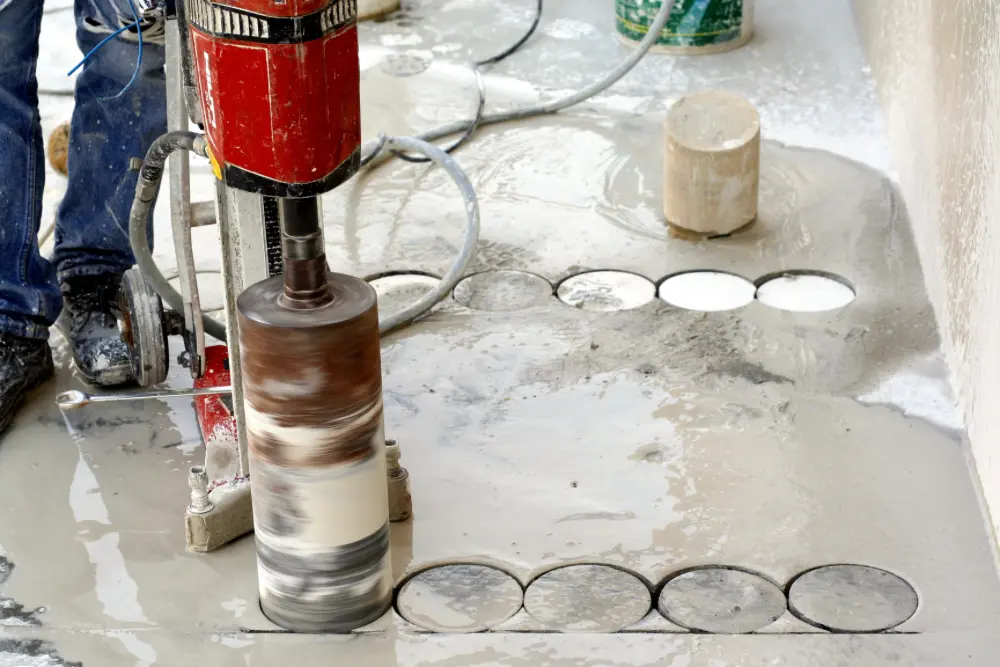
Why Is Concrete Coring Necessary?
Concrete coring serves a wide range of functions across industries:
- Utility Installation: Electricians, plumbers, and HVAC technicians often run conduits, pipes, or ductwork through concrete walls or floors
- Structural Testing: Engineers extract cores to assess the quality and integrity of existing concrete, especially in aging infrastructure
- Retrofitting and Renovation: When buildings are modified or expanded, coring allows for the integration of new systems without compromising structural integrity
- Anchoring and Fastening: Holes may be drilled to install anchor bolts, dowels, or other structural reinforcements
Precision is paramount when concrete coring to ensure the success of your project. Misaligned or poorly executed cores can compromise the structure, damage embedded systems, or create safety hazards.
The Hidden Dangers Beneath the Surface
Concrete is rarely just concrete. Modern slabs often contain a complex network of embedded elements:
- Reinforcing Steel (Rebar): Provides tensile strength and structural integrity
- Post Tension Cables: Used in high-performance slabs to reduce cracking and increase load capacity
- Electrical Conduits: Carry power and data throughout buildings
- Plumbing Lines: Transport water, gas, or waste
- Fiber Optic Cables: Critical for communication infrastructure
Drilling into any of these elements can have serious consequences. Severing a post tension cable can release stored energy with explosive force. This endangers workers and can compromise the structure. Damaging electrical conduits can cause outages, fires, or electrocution. Hitting a water line can flood the site and halt work for days.
These are not hypothetical risks. These things happen regularly on job sites across the world. The cost of such mistakes can be staggering, both in terms of safety and project delays.
Why You Need to Know What’s Below
Before you core, you need to know what's within and below the concrete slab you're planning to penetrate.
Ground penetrating radar (GPR) is a non-destructive imaging technology used for locating and mapping objects embedded within concrete slabs. A GPR scanner emits radio waves into the slab, then detects the interactions between those waves and any embedded objects such as rebar, post tension cable, or conduit. These interactions show up in a GPR readout as hyperbolas. Their size and shape vary based on the material detected.
Unlike X-ray scanning, GPR does not require access to both sides of the slab and poses no radiation risk. It’s fast, accurate, and ideal for identifying:
- Rebar patterns and depth
- Post-tension cables
- Conduits and pipes
- The likely location of voids or honeycombing
- Embedded anomalies
When properly interpreted by a qualified concrete scanning professional, the resulting data reveals safe coring areas. You’ll be able to avoid any critical embedded infrastructure and ensure compliance with safety standards.
Let GPRS Keep You Safe When You Need to Core
Concrete coring isn't just drilling holes. It's a precise and risky task that requires skill and planning.
Concrete slabs have hidden complexities, so every coring job comes with risks. If you don't hire a professional concrete scanning company to give you accurate data of what's within the slab before you core, you're risking serious safety hazards and financial setbacks.
GPRS provides precision concrete scanning services that help keep your concrete coring projects on time, on budget, and safe. Utilizing GPR scanning, electromagnetic (EM) locating, and other complementary technologies, we Visualize The Built World® to help you plan, manage, and build better. Our SIM-certified concrete scanning Project Managers have achieved and maintained a 99.8%+ rate of accuracy, meaning we’re providing you with industry-leading services to ensure you can get your work done while avoiding mistakes and delays.
Concrete Thickness
GPRS Project Managers provide GPR scanning services to determine key slab information for structural engineers, including concrete cover and overlay thickness, concrete thickness, and even dowel placement. Unlike other concrete scanning companies, GPRS is not limited by the size or scope of your site; we have the training and the equipment to fully evaluate your concrete structure.
Slab On Grade
Ground penetrating radar’s ability to visualize what’s inside and under concrete slab-on-grade is one of its biggest advantages over X-Ray scanning technology. Because GPR only needs access to one side of a concrete slab or structure to scan the material for anomalies such as embedded conduit, it can evaluate slab-on-grade.
Shallow Utility Locating
It’s not just the utilities within your concrete slab that you need to worry about – if it’s a slab-on-grade, you also need to avoid lines buried in the soil below. GPRS Project Managers utilize both GPR and EM locating to provide you with a 99.8%+ accurate picture of the infrastructure within and below your concrete slab.
Conduit Mapping
We know you can’t risk severing an electrical conduit while coring or cutting through concrete. We mark our GPR findings directly on your slab so you know where all subsurface obstructions are buried and where you can safely cut or core.
Rebar Locating
Damaged rebar will cost you tens of thousands of dollars to repair. And that’s not counting any structural damage or injuries that occur because of the damaged support. GPRS Project Managers are specially trained to use GPR to locate and map the rebar within your slab or concrete structure.
Post Tension Cable Mapping
Our concrete scanning GPR service can locate post tension cables prior to core drilling. Our concrete scanning results are directly marked on the slab's surface. We can also create 2D CAD drawings and a 3D BIM model. These will show the layout of the post-tension cables inside your slab.
The GPRS Green Box Guarantee
When GPRS places a Green Box within a layout on a concrete slab before you cut or core the concrete, we guarantee that area will be free of obstruction.
If we’re wrong, we agree to pay the cost of any damage that occurs.
Green Box Guarantee information is presented directly on the surface of the coring location. This ensures clear communication of where you can and can’t safely core. GPRS Project Managers perform post-job walkthroughs to explain all Green Box Guarantee locations and parameters.
Click here to learn more.
Post Tension Slab 3D BIM Modeling
See inside your post-tensioned concrete slabs - including conduit, draping, rebar, and more - with comprehensive 3D BIM models that help you avoid damages and plan, upgrade, and renovate better.
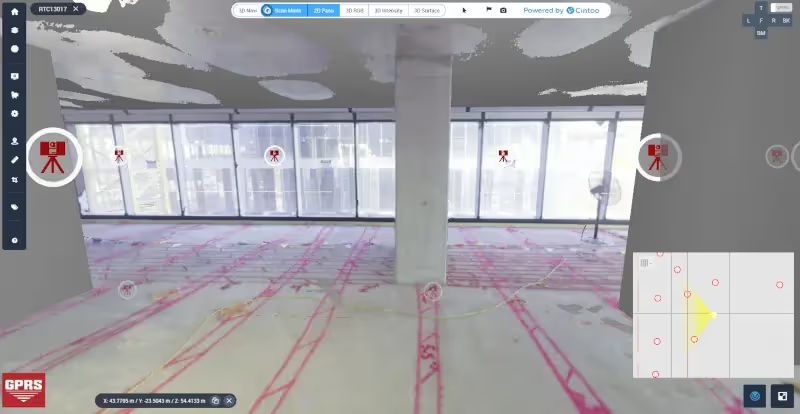
Case Study: GPRS Provides Accurate PT Cable Layout for 49-story Building
Task:
GPRS partnered with Turner Construction to locate and mark the full post tension cable system layout for floors 12-23 of a 49-story building, with approximately 12,500 sq. ft. of concrete on each floor. After completing concrete scanning using GPR, each floor was 3D laser scanned. We used this data to produce 2D CAD drawings and a 3D BIM model for virtual design and construction. The architect received a permanent record of the post tension cable layout to complete fit and finish design plans for the 12 floors of the building.
Problem:
The AEC team required precise interior PT slab mapping for design, planning, and construction of their mixed-use building. Every PT cable bears up to 30,000 Ibs. of load and costs $20,000-$30,000 to replace.
Solution:
GPRS Project Managers employed GPR to accurately scan the interior of each slab. The team then 3D laser scanned the surface markings so that our in-house Mapping & Modeling Team could build accurate 2D CAD drawings and a 3D BIM model of the interior of each slab, including individual and bundled cable drape.
What can we help you visualize?
Frequently Asked Questions
Can GPRS scan vertical surfaces or ceilings?
Yes, GPR can scan for the location of rebar in concrete columns and walls. It can also scan the underside of a floor to mark out the reinforced steel and any embedded conduits.
How is GPR used to identify tendons vs. rebar in a post-tensioned slab?
In post-tensioned structures, we typically find one mat of support rebar near the base of the slab. This mat is generally consistently spaced and remains at a constant elevation. Post-tension cables are generally found above this support mat and “draped” throughout the rest of the structure. The elevation of the cable is usually high near the beams and column lines and drapes lower through the span between beams and column lines. Knowledge of these structural differences allows us to accurately differentiate between components. Our Project Managers will leave you feeling confident in our findings and in your ability to drill or cut without issue.
How long does it take to scan an area for core drilling?
GPR is an extremely efficient and rapid technology. Large areas can be easily and quickly scanned with the state-of-the-art GPR units utilized by GPRS Project Managers. Our standard layout for a typical core drilling location is 2’x2’. It usually takes about 10 minutes to scan and mark an area this size.
Can GPR scan concrete slab-on-grade?
Yes, it can. Unlike with X-ray, where both sides of a concrete slab must be accessible to obtain a picture of the subsurface structure, GPR only requires access to one side of a slab to obtain a comprehensive view of what’s inside the slab. This makes it an ideal technology for evaluating concrete slab-on-grade.
LiDAR vs. 3D Photogrammetry: Which is Right for My Next Job?
If you’re considering reality capture services for your next project, you’ll encounter the terms LiDAR and 3D Photogrammetry. They are technologies that are best utilized when operated by reality capture professionals, like GPRS Project Managers.
While they both have similar uses and can sometimes complement each other, their capabilities and ideal scopes of work are different.
By understanding these differences, you can make a well-informed decision on how to best capture your reality.
WHAT IS LiDAR?
LiDAR, short for “light detection and ranging,” is a remote sensing technology that uses light in the form of a pulsed laser to measure distances to a target. A LiDAR sensor sends out beams of ultraviolet and/or near-infrared light and then measures how long it takes for them to return to the sensor. Each scan is limited to the scanner’s line-of-sight, so multiple scans are required to provide a comprehensive 3D view of an object or scan area.
GPRS utilizes LiDAR technology in our reality capture services to provide clients with highly accurate scan data that we can translate into 2D CAD drawings and 3D models. LiDAR can also be used with other technologies like ground penetrating radar (GPR) or electromagnetic (EM) locators in an attempt to “Go Beyond the Line of Sight.”
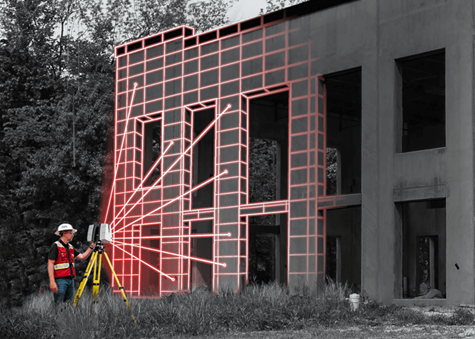
Once a given geographical area, terrain, building, or space is scanned using a LiDAR laser scanner, a point cloud of the area is created.
Point clouds provide powerful and dynamic information for a project. CAD technicians, like the GPRS Mapping & Modeling Team, transform point clouds into deliverables vital for decision-making and analysis, such as 2D CAD drawings and 3D BIM models.

Site plans, floor plans, elevations, isometric drawings, and reflected ceiling plans are all examples of 2D drawings that GPRS can provide using reality capture technology like LiDAR.
GPRS also provides 3D modeling and scan-to-BIM services to support design, visualization, space definition, prefabrication, and clash detection.
There are two types of LiDAR scanners: airborne and terrestrial. Airborne LiDAR scanners mount a laser to a remote-control device, like a drone, to capture scan data. Terrestrial LiDAR scanners are typically mounted to a tripod and are stationary during the scanning process. Terrestrial LiDAR scanners are the type most commonly utilized by GPRS Project Managers.
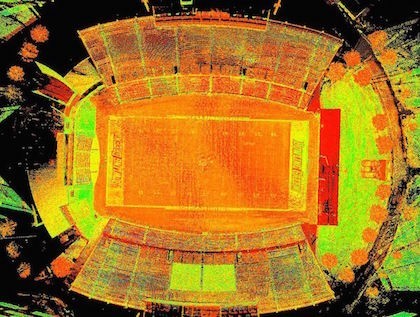
In recent years, Apple has added LiDAR sensors to the latest iPhones for better camera quality and augmented reality (AR) experiences.
LiDAR services and deliverables are ideal for construction and architectural projects. Accurate point cloud data from LiDAR 3D scans helps professionals in AEC industries keep projects on schedule, within budget, and safe.
There are many manufacturers that utilize LiDAR scanning technology, including:
- Leica Geosystems – the most well-known manufacturer of LiDAR scanning technology. They are known for their high accuracy and user-friendly integration with CAD & BIM platforms
- FARO Technologies – known for applications in AEC industries along with forensic cases and assembly lines
- Luminar Technologies – the only company with LiDAR technology included in the global production of a vehicle
- YellowScan – known for drone LiDAR scanning in the entertainment, archeological, and agricultural industries.
- Teledyne Optech – known for their advanced aircraft LiDAR scanning and surveying
WHAT IS PHOTOGRAMMETRY?
Photogrammetry is the process of capturing images and stitching them together to create a digital model of a structure or site for visualization, planning, and analysis.
Photogrammetry uses a camera, which can also be equipped with LiDAR, to digitally document sites with high-resolution photographs. The photographs are taken from different positions and angles to capture a 360° view of each setup and can be stitched together in a virtual tour of the site.

Like LiDAR, there are two types of photogrammetry: aerial and terrestrial. Aerial photogrammetry captures aerial photos by mounting a camera to a drone or an aircraft, while terrestrial photogrammetry takes photos from a fixed position.
The data captured with photogrammetry can be used to create digital twins, virtual tours, floorplans, 2D CAD plan views, digital terrain models, and more.
GPRS utilizes 3D Photogrammetry as part of our reality capture services, and our WalkThru 3D, FLRPLN, and ProCap products. It has tremendous value in its ability to capture our 99.8% accurate field markings to allow our Mapping & Modeling Team to create integrated digital twins and provide a 360° view of any site or facility.
There are many manufacturers that utilize 3D photogrammetry technology, including:
- Matterport – utilizes LiDAR to create interactive 3D models, point clouds, layouts, and floorplans of physical spaces best suited for real estate and facilities
- Pix4D – performs aerial and terrestrial photogrammetry that also utilize LiDAR for AEC industries, land surveying, and forensic cases
- Polycam – created an app that allows smartphones to perform 3D photogrammetric scans
It is also important to note that most brands that utilize photogrammetry also utilize LiDAR technology, and vice versa.
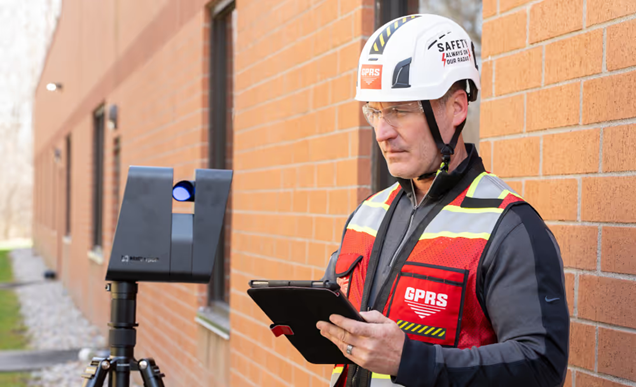
WHAT ARE THE SIMILARITIES AND DIFFERENCES BETWEEN LiDAR AND PHOTOGRAMMETRY?
One of the biggest differences between LiDAR and photogrammetry is the level of accuracy of the scans.
LiDAR laser scanners can capture 2-4 mm accurate scans up to 60 meters away. They achieve this by capturing 2 million data points per second. This level of high accuracy is why it is most ideal for architecture and construction. Being off by an inch or two can make a huge difference on a job site. Photogrammetry is done with overlapping, rectified photos that focuses more on detailed images rather than accurate measurements.
However, if color images are what a client needs, then photogrammetry is the route to go. By default, all photogrammetry scans are in full color while LiDAR scans are in greyscale. LiDAR can do color scans if chosen ahead of time. That choice does extend the time needed to conduct the 3D scans, so it’s important to address that early on. LiDAR laser scanners rely on the overlap of a laser point cloud and a 3D photo in order to assign an RGB value to the point cloud.
Photogrammetry scans are also full of rich visual detail. The texture and color of surfaces are very well captured through photogrammetry scans. LiDAR scans are often limited in the amount of surface detail conveyed in the scans.
One benefit of LiDAR’s default greyscale scans is its ability to scan data in darker or even pitch-black environments. That is beneficial for jobs in places with limited lighting like underground caves. Since photogrammetry scanners only shoot in color, it will not pick up any good scan data in darker environments without extra lighting.
In terms of similarities, LiDAR and photogrammetry scanners can both create similar deliverables as well. While the process of creating them may be different, they can both create 3D models, points clouds, and 2D drawings.
LiDAR and photogrammetry also can both be conducted in the air on drones or aircrafts, and on the ground from a stationary position.
They both support planning, design, construction, and facility management by reducing site visits, improving collaboration, and streamlining workflows.
Another similarity between LiDAR and photogrammetry products is that it is always best to hire professionals, like GPRS Reality Capture Project Managers, to use these tools and capture scan data. Even if you have thousands of dollars to spend on a brand-new laser scanner, the result will lack accuracy without the proper training and expertise of a professional.
CAN THEY BE USED TOGETHER?
LiDAR and 3D Photogrammetry can be used together on some occasions to amplify scan results. Since they each have certain weaknesses that the other does not, their technologies can be complementary.
For example, since LiDAR scans are conducted in greyscale, photogrammetric imagery can be used to enhance and colorize point cloud data.
Further, 2-4 mm accurate LiDAR scans can be used to create an accurate model backbone that ties in 3D photogrammetry scans to make the model more precise.
HOW DO I KNOW WHEN I NEED REALITY CAPTURE SERVICES?
Almost any project that requires as-built information can benefit from a laser scanning survey.
Utilizing GPRS’ reality capture and 3D laser scanning services can yield the following benefits:
- Collecting millions of real-world data points
- Eliminate measurement errors
- Reduce change orders and waste
- Eliminating or minimizing operational shutdowns and client inconvenience
- Increased safety
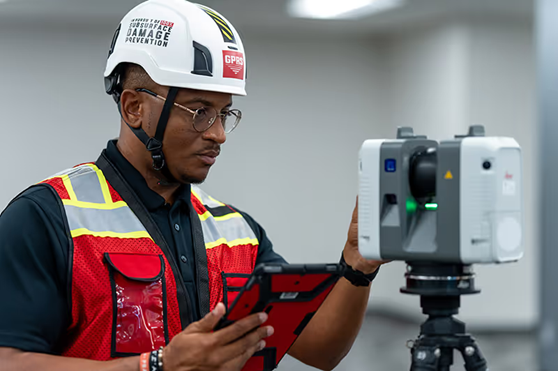
For LiDAR and photogrammetry, their capabilities and ideal scope of work perfectly demonstrate how they can help you.
We recommend a GPRS Project Manager utilizing LiDAR laser scanners if you need:
- A detailed scan of a building’s entire exterior and/or interior
- To update a structure’s as-built documentation
- 2D CAD drawings or 3D models with high accuracy
- A 3D model of complex mechanical, electrical, and plumbing (MEP) systems
- Updated measurements and models of historical buildings without having to physically touch the aging infrastructure
We recommend a GPRS Project Manager utilizing 3D Photogrammetry if you need:
- To create a virtual tour of a real estate, commercial, or industrial space
- To create a digital twin to track progress or plan future projects
- To develop floorplans, 3D models and walkthroughs
- Color models of a structure or facility
- Highly detailed images of building façades not easily seen from the ground
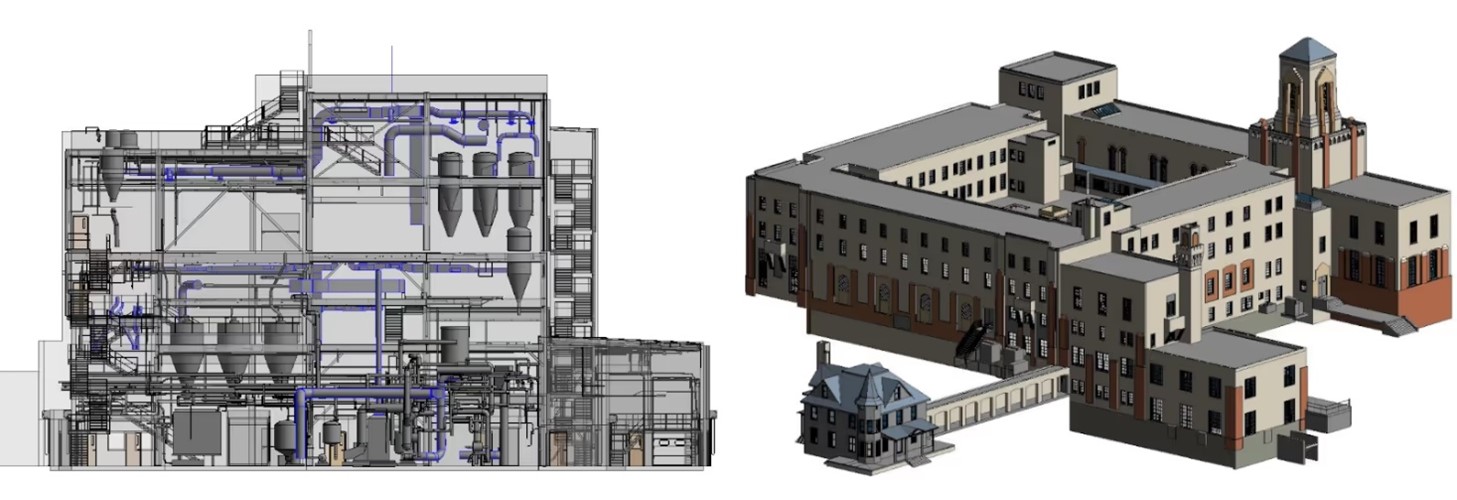
From schools to stadiums, to skyscrapers, GPRS captures your reality to keep your projects on time, on budget, and safe.
What can we help you visualize?
FREQUENTLY ASKED QUESTIONS
What is Scan-To-BIM?
Scan to BIM is the process of digitally capturing a site with a 3D laser scanner and using the data to create a BIM model. Building information modeling (BIM) is an intelligent software modeling process that engineers, contractors, and architects can use to collaborate on a building’s design, construction, and operation. It’s more than just a model. It’s a process of collecting and managing data throughout a building’s entire life cycle.
What Is a Digital Twin?
A digital twin is a highly complex virtual model that is the exact counterpart (or twin) of a physical object. GPRS uses 3D laser scanners to collect real-time data for a building or facility and create a digital duplicate. Data can be easily visualized, measured, analyzed, and updated. Digital twins can be used to improve efficiencies, optimize workflows and detect problems before they occur.
The CGA Takes Off the Gloves, Calls for Legislation, Ending Exemptions, and Enacting Mandatory Industry Protocols
This is the start of a multi-part series focusing on the findings, recommendations, and potential impacts of the Common Ground Alliance’s 2024 DIRT Report.
Ending exemptions for water and sewer asset holders, renegotiating One Call contracts based on performance instead of cost, and enacting mandatory preconstruction protocols for telecommunication infrastructure installation are just some of the changes the Common Ground Alliance is urging to combat excavation utility damages nationwide.
The CGA’s 2024 DIRT Report includes the strongest language the trade association of nearly 4,000 damage prevention professionals has ever used regarding compliance with federal and state 811 regulations, and safety practices, and for good reason.
“We are falling critically short of the progress necessary to drive real change,” the letter from President & CEO Sarah Magruder Lyle at the front of the report states.
“After encouraging progress in 2023, the 2024 data shows an increasing trend of total damages, with the CGA Index rising from 94 to 96.7… our current trajectory will not achieve the transformative change our industry needs without commitment and immediate investment.”
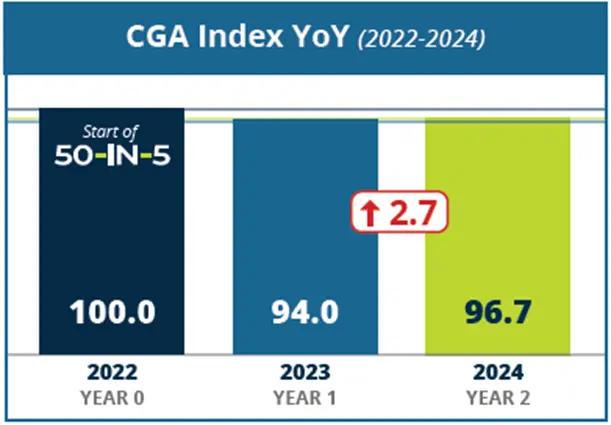
What is the CGA Index?
In 2023, for the 2022 reporting year, the CGA instituted a new scale of metrics designed to provide a clearer picture of how utility damages occurred, in what business sectors, and what factors caused the damages. The organization shows a 2.3 point increase in full dataset quality, which could potentially signal that the more accurate the reporting and metrics become, the larger and more dangerous the problem of underground utility strikes actually is.
What Are the Main Causes of Utility Damages?
Of the 196,977 unique damage reports covered in the 2024 report (combined total of the U.S. and Canada) 85% of all utility damages were caused by the “top 10 root causes.”
1. Failure to file a locate request
2. Excavators verifying marks but failing to maintain clearances
3. Facilities unmarked due to locator error
4. Facilities inaccurately marked due to locator error
5. Improper excavation practices (not otherwise listed)
6. Excavation proceeding without marking verification via potholing
7. No mark-out due to unresponsive utility operator or contract locator
8. Failure to shore excavation support/facilities
9. Faded, lost, or unmaintained mark-outs
10. Unmarked facilities due to incorrect existing records/maps
In 38% of reported incidents, excavators had followed the rules of their state’s reporting system, but were unable to break ground safely, if at all, because their locate request had an “incomplete response.”
And the top 10 root causes “reveal clear patterns” showing that utility work “dominates” damage incidents across all root causes.
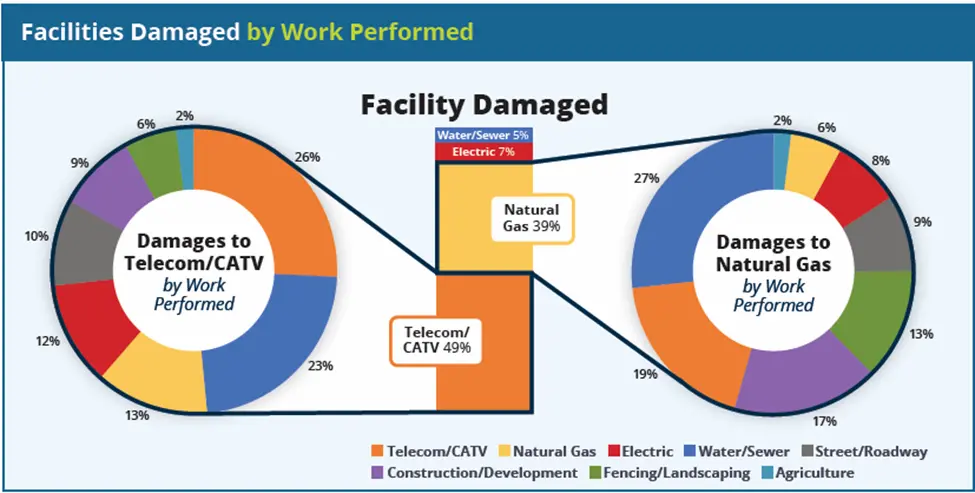
In the Executive Summary for the 2024 report, the CGA lays out specific training, industry, and “regulatory frameworks that balance deployment speed with safety,” to meet the moment. “…we must fundamentally shift our approach form voluntary Best Practices adoption to consistent, enforceable standards and forward-thinking Next Practice innovation,” they say on page 6.
Their rallying cry is “The Path Forward Requires Systemic Change,” and is broken into five main priorities, each with its own specific recommendations for regulators and policymakers, facility owners, and excavators.

Priority 1: Improve Locate Timelines Across All Operators to Target Top Damage Root Cause
Priority 2: Target Water/Sewer and Telecommunications Dominance in Work Performed
Priority 3: Scale Successful Programs Based on Damage Prevention Institute Findings
Priority 4: Implement Systematic Enforcement Across All Stakeholders
Priority 5: Accelerate Data-Driven Decision-Making
Why is the CGA Sounding the Alarm Now?
While this is not the first time the Common Ground Alliance has called for legislation and regulatory oversight of the nation’s One Call/811 systems, the 2024 DIRT Report contains the organization’s most strident and comprehensive call to action in memory.
In its 2022 report, the CGA urged a reset of the enforcement and penalty structure, stating that stakeholders should “examine enforcement of all primary participants in the process to ensure penalties are effective and incentivize those involved to change their behavior.” Further, they asked that accountability extend to asset owners, excavators, and utility locators.
Again, in 2023, the DIRT Report framed the organization’s recommendations in the form of industry actions and called on stakeholders to “establish coordination mechanisms between government agencies/regulators, facility owners, excavators, locators and other industry stakeholders.” Such coordination usually requires rulemaking or statutory updates. So, in proposing mandatory standards, the CGA was looking to legislators at the city, state, and federal level, although the ask was couched in some rhetoric.
Prior to and since 2022, every update to the CGA’s Best Practices Guide & its Stakeholder Advocacy Toolkit has encouraged mandatory education either as an alternative to, or supplement of civil penalties for damage-prevention law violations, but stopped short of direct calls for legislative change.
Now, the gloves have come off in 2025 with the 2024 DIRT Report’s calls for mandatory preconstruction protocols for telecommunications installations, which are often done using directional drilling/trenchless technology, and can have a massive impact on existing utilities, among other sweeping recommendations.
Future GPRS Industry Insights articles on the 2024 DIRT Report will delve into each of the CGA-named priorities, their precedents, potential regulatory steps, and overall impacts on the construction and damage prevention industries.
GPRS has been at the cutting edge of construction damage prevention since 2001, striving to provide our customers nationwide the infrastructure data they need to bring their projects in on time, on budget, and most importantly, safely. Utility damage prevention is a cornerstone of our commitment to Visualizing The Built World®.
What can we help you visualize?
What are 4D and 5D Modeling?
Digital technologies have changed how we think about, plan, and carry out construction projects.
4D and 5D modeling are major breakthroughs. They enhance Building Information Modeling (BIM) by including time and cost factors in standard 3D models.
These advanced modeling techniques are not just buzzwords. They represent a paradigm shift in project management, collaboration, and decision-making.
Understanding the Dimensions: From 3D to 5D
To grasp the importance of 4D and 5D modeling, you need to see how they fit into the larger BIM framework.
- 3D modeling forms the foundation, representing the geometric and spatial aspects of a building. It includes architectural elements, structural components, and systems like HVAC and electrical
- 4D modeling adds time as a dimension. It connects construction schedules to the 3D model. This enables visual simulation of the construction process over time
- 5D modeling includes cost data. This helps stakeholders analyze financial impacts alongside design and scheduling
These dimensions work together to support smarter decision-making throughout the entire project lifecycle.

4D Modeling: Time as a Design Element
4D modeling is the integration of scheduling data with a 3D BIM model. It helps project teams see the construction sequence. They can find conflicts and improve workflows before any construction work begins.
How It Works
4D modeling connects each part of the 3D model to tasks in the construction schedule. This connection makes it possible to create time-based simulations. They illustrate the construction of the building step by step. You can play these simulations like a video. They show exactly what will happen on-site at any moment.
A project manager knows when the team will pour the foundation, install the steel framing, and add the interior finishes. All this information appears on one clear timeline.
Benefits of 4D Modeling
The advantages of 4D modeling are both strategic and operational. It enhances communication among stakeholders by providing a shared visual language. Contractors can better coordinate trades, reduce downtime, and avoid clashes. Owners gain a clearer understanding of project milestones and potential delays.
4D modeling also supports scenario planning. Teams can simulate different construction sequences to find the most efficient path forward. They can account for variables like weather, labor availability, and site constraints.
5D Modeling: The Financial Dimension
While 4D modeling focuses on time, 5D modeling brings cost into the equation. It connects the 3D model and construction schedule with detailed cost data. This allows for real-time budget analysis and forecasting.
How It Works
In a 5D model, each building element is associated with cost information—materials, labor, equipment, and more. As the design evolves or the schedule changes, the model automatically updates the cost estimates. This dynamic connection allows you to continuously track costs and stay ahead of budget overruns.
Say a design change increases the quantity of steel required for your project. The 5D model will reflect the updated cost immediately. You and your team can quickly make informed decisions. You and your clients can balance design aspirations with financial realities.
Benefits of 5D Modeling
The integration of cost data into the BIM environment offers several key benefits. Because all stakeholders have access to the same financial information, it improves transparency and accountability. It also enhances accuracy in cost estimation, reducing the risk of surprises during construction.
5D modeling also supports value engineering. Teams can try different materials or construction methods. They can quickly see how those choices impact the budget. This fosters a more collaborative and proactive approach to cost management.
Real-World Applications and Case Studies
Infrastructure Projects
Large infrastructure projects, like highways, bridges, and rail systems, gain a lot from 4D modeling. These projects often involve complex phasing and coordination among multiple contractors. Time-based simulations keep each phase on track with the schedule. This helps reduce disruptions and delays.
In a major rail project, 4D modeling helped coordinate construction near active train lines. Visual simulations helped teams plan work during off-peak hours. This avoided service interruptions and saved millions in potential penalties.
Commercial Developments
In commercial construction, 5D modeling has proven invaluable for budget control. A major office tower project in a dense urban area used 5D modeling to manage costs across multiple design iterations. The client asked for changes to the façade and interior layout. The model gave quick cost feedback. This helped the team stay on budget while maintaining quality.
Integration with Project Management Tools
One of the strengths of 4D and 5D modeling is their ability to integrate with existing project management platforms. Tools like Primavera P6, Microsoft Project, and cost estimation software link easily to BIM environments. This connection creates a smooth flow of information.
This integration supports real-time updates and collaboration. When you change the schedule in the project management tool, it updates in the 4D model right away. Cost changes in the estimation software update the 5D model. This connectivity reduces manual data entry and ensures consistency across platforms.
Challenges and Considerations
Data Quality and Standardization
The effectiveness of 4D and 5D models depends on the quality of the underlying data. Inconsistent naming conventions, missing attributes, or outdated schedules can compromise the accuracy of simulations and cost estimates. Establishing clear data standards and workflows is essential.
Training and Adoption
Adopting these advanced modeling techniques requires a cultural shift within organizations. Teams need training in both the software’s technical skills and the collaborative mindset that BIM requires. Resistance to change can slow adoption. So, leaders must promote the benefits and offer continuous support.
Software Compatibility
Not all BIM tools support 4D and 5D modeling natively. Integrating different platforms can be complex, requiring custom scripts or middleware. Choosing the right software ecosystem and ensuring interoperability is a critical step in successful implementation.
The Future of 4D and 5D Modeling
As digital transformation accelerates, 4D and 5D modeling are poised to become standard practice in the AEC industry. Emerging technologies such as AI, machine learning, and cloud computing will boost their capabilities even more.
AI analytics can spot schedule risks using past data. Cloud platforms allow real-time teamwork no matter where you are. Augmented reality (AR) and virtual reality (VR) are now paired with 4D and 5D models. This lets stakeholders dive into the construction process and financial planning.
The rise of digital twins – virtual replicas of physical assets – will build on 4D and 5D foundations. These twins continuously update with live data from sensors and IoT devices, offering unprecedented visibility into building performance and maintenance needs.
4D and 5D modeling represent a significant leap forward in how construction projects are planned, executed, and managed. By adding time and cost dimensions to traditional 3D models, these technologies provide a holistic view of the project lifecycle, enabling smarter decisions, better collaboration, and more predictable outcomes.
GPRS provides industry-leading 3D laser scanning and scan-to-BIM services that ensure your projects start accurate and stay accurate.
We allow you to capture, analyze, and define existing conditions through safe, non-contact 3D laser scanning. We provide an accurate foundation for 4D and 5D modeling, allowing you to save millions of dollars in downtime and cost overruns.
All the as-built information we collect for you is at your fingertips 24/7 thanks to SiteMap® (patent pending) our revolutionary cloud-based utility mapping software that consolidates all your infrastructure data in one easy-to-access, secure application. Accessible 24/7 from any computer, tablet, or smartphone, SiteMap allows you and your team to plan, build, and manage your projects better.
What can we help you visualize?
Frequently Asked Questions
How is 3D laser scan data registered?
The registration process is a collaborative effort. Registering a 3D laser scan point cloud involves aligning multiple scans of the same area taken from different positions into a single, coherent point cloud. This typically involves using specialized software like Autodesk Recap to import the data and align the scans. The Mapping & Modeling Team uses the software to find overlapping areas between different scans where the same physical features are captured from slightly different angles, allowing the software to identify corresponding points.
Silbaugh says unwanted “noise” can be cleaned or deleted from the point cloud. Autodesk Recap software can isolate and delete extraneous data or noise, such as reflections, moving objects, or background clutter, leaving behind a refined point cloud representing the desired project area. Proper registration ensures that measurements taken from the 3D laser scans are accurate and the data can be exported for use in CAD or BIM applications like Revit or AutoCAD.
How long does 3D laser scanning take?
With Project Managers all over the US, we work quickly to provide detailed quotes for clients. For most jobs, large areas can be laser scanned in as little as a couple of hours or larger sites in as little as a few days. Entire facilities or campuses can take several weeks to capture the entire site, but most projects are measured in hours or days.
What if my project is limited within the physical setting?
Some projects require special applications due to limitations within the physical setting. This is often due to line-of-sight issues and when a scan must be done safely from the ground or with precautionary distance. Some of these applications would include above-ceiling MEP features in hospitals where it is necessary to maintain negative airflow or interstitial spaces that are congested with limited access. Since laser scanning is a non-contact measurement tool (i.e. we can scan from a safe distance or location) this becomes a powerful tool for solving these complex challenges.
Deciding on 3D Laser Scanning: What General Contractors, Engineers, Architects, and Facility Managers Really Consider
What Are the Key Considerations Before Deciding on 3D Laser Scanning Services?
3D laser scanning provides a record of the current building information, including architectural, structural, utility, and MEP system dimensions, locations, and material specifications. This information is essential for project planning. Whether you’re an architect planning a renovation, an engineer validating structural tolerances, a contractor racing against a schedule, or a facility manager managing an equipment upgrade, 3D laser scanning has become an essential tool for capturing the physical reality of buildings and sites with millimeter-level accuracy.
By converting physical spaces into rich, measurable point clouds, CAD drawings, and BIM models, 3D laser scanning informs decision-making, reduces rework, and streamlines coordination across the entire project lifecycle.
But the real value comes from matching the right 3D laser scanning approach to the right use case because layout verification, clash detection, prefabrication, and facility management all demand different accuracy requirements, workflows, and deliverables.
So how do you decide what’s right for your project? This article discusses what general contractors, engineers, architects, and facility managers consider when defining and evaluating 3D laser scanning services, helping to ensure the technology delivers value where it matters the most.

What Should You Consider Prior to Selecting a 3D Laser Scanning Provider?
Choosing the right 3D laser scanning service starts with understanding the specific needs of your project. Selecting the right scanning approach isn’t “one size fits all.” Several key factors can help determine the reality capture solution that is best for your project.
1. Project Objectives
First, assess what you are trying to accomplish, whether it’s capturing as-built conditions to plan a renovation for adaptive reuse, complete a manufacturing plant retrofit, or verify construction progress.
What will the scan data be used for?
- Design & Planning: Are you creating floor plans, elevations, or site layouts?
- Construction & BIM: Will the data feed into a Building Information Model (BIM)?
- Facility Management: Is the goal to create a digital twin to support asset tracking, maintenance, or space planning?
- Inspection & Analysis: Do you need to detect structural issues, measure tolerances, or perform clash detection?
2. Project Scope
To accurately define the scope for a 3D laser scanning project, it’s important to assess several key factors. These include the total square footage of the area to be scanned, the number of levels or floors involved, and whether the space is currently occupied. Additionally, clarify the requirements of the scan, whether it includes the interior, exterior, roof, MEP equipment, or a comprehensive site capture.
3. Stakeholders
Start by identifying who will be using the 3D laser scan data, whether it's architects, engineers, contractors, building owners, or facility managers. Understanding each stakeholder’s role is essential for determining the scanning approach and deliverables. Be sure to clarify their preferred software platforms, such as Revit, AutoCAD, or Navisworks, as this will influence the required data formats and level of detail.
Before selecting a scanning service or technology, involve your stakeholders early in the planning process. Their input can help define expectations around modeling standards, software compatibility, and data integration. This collaborative approach ensures the scan data fits seamlessly into your project workflow and helps avoid costly rework or format conversions later.
4. 3D Laser Scanning Equipment Needed
The layout and complexity of the building or site plays a major role in selecting the appropriate 3D laser scanning technology. Large-scale environments, such as construction sites, infrastructure projects, or multi-story buildings, require terrestrial scanners that have long-range capabilities and high accuracy. In contrast, scanning detailed elements like MEP systems or interior layouts may call for high-resolution scanners with greater mobility. Architectural features such as facades, curved surfaces, tight spaces, or structural irregularities will influence which type of 3D laser scanning equipment is most suitable for the job. Handheld scanners are ideal for capturing quick snapshots or accessing hard-to-reach areas, while tripod-mounted or terrestrial scanners offer superior precision for comprehensive scans, though they are less portable.
5. Accuracy & Resolution Requirements
The required level of detail depends on how the scan data will be used. For example, as-built documents for renovations need millimeter-level accuracy. In contrast, general site surveys can have lower accuracy requirements. High-resolution 3D laser scanners are crucial for tasks such as clash detection, prefabrication, and structural analysis. In these areas, precision is key and cannot be compromised. Low accuracy requirements could help create conceptual design plans for a new building.
6. Scan Environment & Accessibility
Some 3D laser scanning projects take place in challenging environments, for example, scanning dense MEP systems, low-light conditions, or areas with limited physical access. These factors can impact the performance of certain scanners. It’s important to choose a scanner that can operate effectively in low-light settings and navigate dense equipment and tight crawlspaces. Additionally, consider whether the scanner supports tripod mounting, handheld use, or both, depending on your project scope.
Keep in mind that LiDAR technology cannot penetrate solid objects. Therefore, it’s essential to plan your scanning strategy carefully to ensure that critical areas are not obstructed by furniture, equipment, or structural barriers. A thorough site scan strategy will ensure complete data capture and minimize return trips.
7. Intended Use of Scan Data
Understanding how the scan data will be used is essential when selecting a 3D scanner and its accompanying software. Whether you're creating 2D floor plans, developing BIM models, tracking construction progress, managing facilities, or conducting structural inspections and clash detection, each application has specific requirements. The scanner must be capable of producing point cloud data in compatible formats such as E57, RCP, LAS, or OBJ, and should integrate smoothly with industry-standard tools like Revit, Navisworks, AutoCAD, or Civil 3D. Clearly defining the purpose of your scan ensures that both the hardware and software will support your workflow efficiently and deliver the quality and compatibility needed for successful outcomes.
8. Timeline
Do you need a fast turnaround for a tight timeline? Time is always a critical factor in project management. High-speed scanners can capture entire rooms or building exteriors in minutes. This speed is crucial for large jobsites. Some 3D laser scanning systems offer automated scanning or batch processing, improving efficiency for repetitive tasks. But, faster isn’t always better, make sure that the scanner maintains accuracy to avoid compromising data quality.
9. Budget
When planning for 3D laser scanning, it’s important to consider your budget. Pricing varies by equipment, project complexity, location, and turnaround time. To make an informed decision, ask 3D laser scanning service providers to break down what’s included in their pricing, such as scan coverage, file formats, post-processing, and revision cycles. Comparing deliverables, not just quotes, can reveal which service offers better long-term value. A slightly higher upfront cost may be worthwhile if it includes comprehensive data preparation and integration support, ultimately reducing your internal workload. A transparent provider will offer a detailed quote and clearly explain what’s included, helping you avoid surprises and ensuring the service aligns with your financial expectations.
Read Article: How Much Does 3D Laser Scanning Cost?
What are the Use Cases for 3D Laser Scanning in Architecture, Engineering, Construction, and Facility Management?
Architectural Use Cases for 3D Laser Scanning
As-Built Documentation
Architectural firms use 3D laser scanning to capture highly accurate as-built geometry to establish a reliable baseline for design. This information is critical for renovations, adaptive reuse, and heritage projects, especially when original drawings are outdated or missing. 3D laser scans provide millimeter-level detail, reducing the risk of errors and surprises during design and construction.
Design Validation
Architects can use 3D laser scan data to compare design models to actual site conditions to identify discrepancies early. This process helps architects and design teams avoid costly redesigns by ensuring that proposed layouts align with real-world conditions before construction begins.
Façade and Envelope Studies
The building’s façade and envelope can be thoroughly analyzed for its geometry, alignment, and material conditions. 3D laser scanning aids this process by capturing precise surface data that evaluates structural integrity, surface conditions, deformation, energy efficiency, window and door placement, ornamental details for restoration, and more. This detailed information helps to make informed design decisions, ensuring that exterior elements are properly evaluated and integrated into the architectural project plan.
Historic Preservation
3D laser scanning documents heritage structures in high-resolution point clouds for restoration, repair, and archival purposes. These scans serve as a permanent digital record for architects, enabling accurate reproduction of ornamental details and compliance with preservation standards.
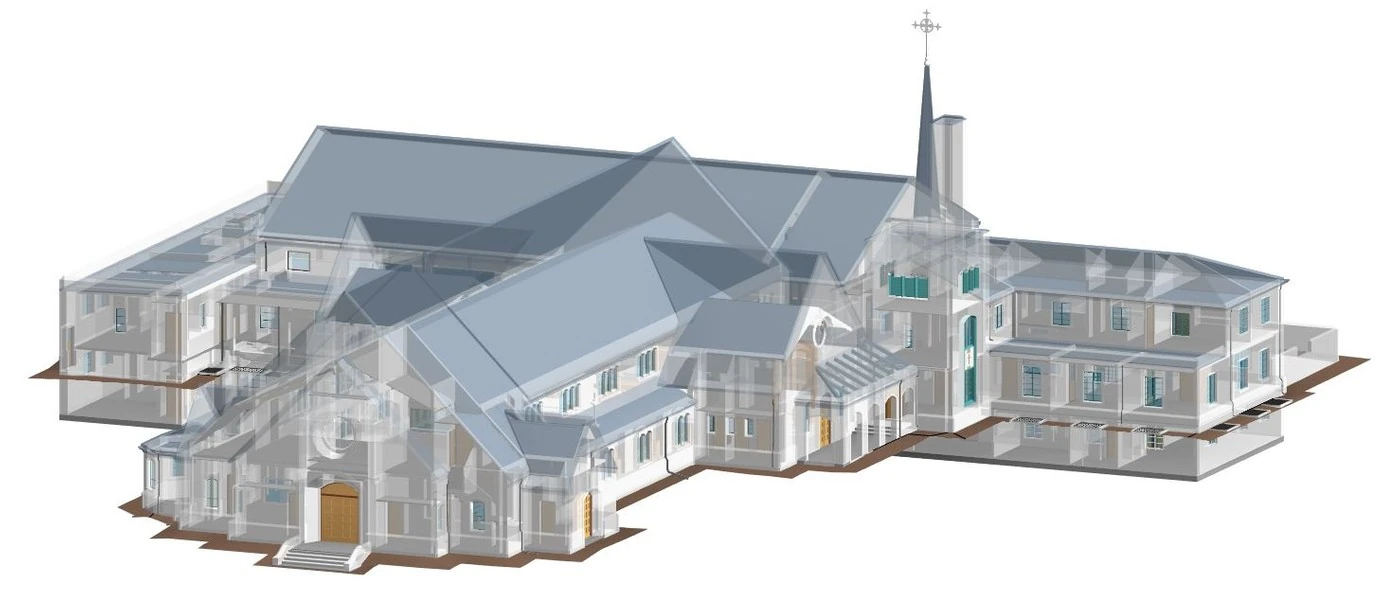
Engineering Use Cases for 3D Laser Scanning
Structural Analysis
Engineers use 3D laser scanning to measure deflection, settlement, and deformation in structural components such as beams, columns, and slabs over time. This technology enables early detection of structural movement and helps create a digital record that can be used to meet safety rules or investigate issues later. By comparing scans taken at different times, engineers can plan repairs before bigger problems happen.
MEP Coordination
Mechanical, electrical, and plumbing systems often compete for limited space within ceilings, shafts, and plant rooms. 3D laser scanning captures existing conditions with millimeter-level accuracy, allowing engineers to detect potential clashes and validate routing within CAD and BIM environments. This ensures efficient coordination and reduces the risk of installation conflicts.
Tolerance Verification
To ensure that steel, piping, and equipment installations meet fabrication tolerances, engineers rely on laser scanning to compare as-built conditions against design models or fabrication drawings. This verification process helps confirm that components fit as intended, minimizing costly adjustments in the field.
Load Path and Clearance Checks
Projects involving cranes, conveyors, or heavy equipment installations must confirm that load paths and clearances are sufficient. 3D laser scanning creates a detailed 3D environment where these paths can be simulated and validated, ensuring safe and efficient equipment placement.

Construction Use Cases for 3D Laser Scanning
Layout Verification
Before concrete is poured or structural steel is placed, even minor deviations in the positioning of anchor bolts, embeds, or sleeves can lead to significant alignment issues later in the project. 3D laser scanning provides millimeter-level accuracy to verify that these elements are correctly positioned relative to the design model. This proactive verification helps reduce the risk of costly rework and schedule delays.
Clash Detection
When integrating new design models with existing site conditions, hidden conflicts can disrupt progress and increase costs. 3D laser scanning captures the true geometry of the site, allowing project teams to overlay point clouds with BIM models and identify potential clashes early. This ensures that mechanical, electrical, plumbing, structural, and architectural elements fit together as intended during installation.
Prefabrication
For prefabricated assemblies such as pipe racks, ductwork, or façade panels, dimensional accuracy is critical. Laser scanning validates field dimensions and tolerances before fabrication begins, helping to ensure that prefabricated components will fit correctly upon delivery. This reduces waste, minimizes rework, and supports a more efficient installation process.
Progress Monitoring
By conducting frequent comparisons of point clouds to the 3D design model, project teams can verify the completeness of installations, detect deviations from the plan, and document work upon completion. This ongoing monitoring supports quality control and provides a reliable record of construction progress.
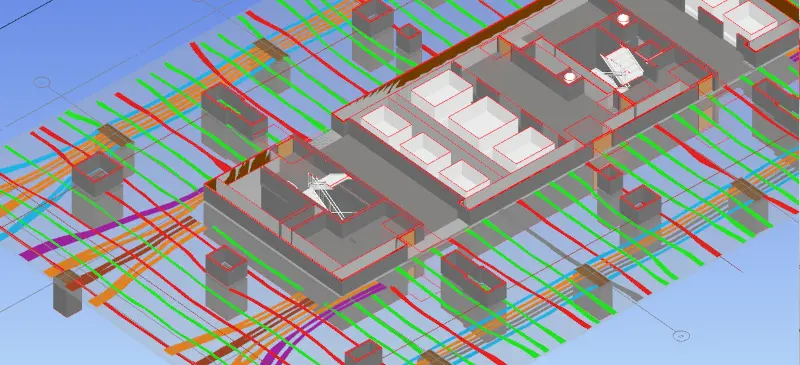
Facility Management Use Cases for 3D Laser Scanning
Digital Twin Creation
Creating a digital twin of your facility establishes a reliable baseline for ongoing operations, maintenance, and space planning. This digital representation enables real-time monitoring and seamless integration with building management systems, improving overall efficiency.
Asset Tagging and Inventory
Accurate asset tagging and inventory management are also key benefits of 3D laser scanning. The technology helps you track equipment locations, serial numbers, and metadata. You can then integrate this data into your Computerized Maintenance Management System (CMMS). This ensures precise asset tracking and helps reduce downtime during repairs or replacements.
Facility Layout
Laser scanning also supports facility layout and space utilization by validating room dimensions and occupancy levels. This data can be used to ensure compliance with regulations and optimize space allocation, contributing to more effective energy efficiency strategies.
Retrofits and Renovations
For facility renovations, having accurate as-built documentation allows facility managers to plan upgrades and retrofits without the need for intrusive surveys. This reduces project risk, minimizes disruption to building occupants, and streamlines the renovation process.
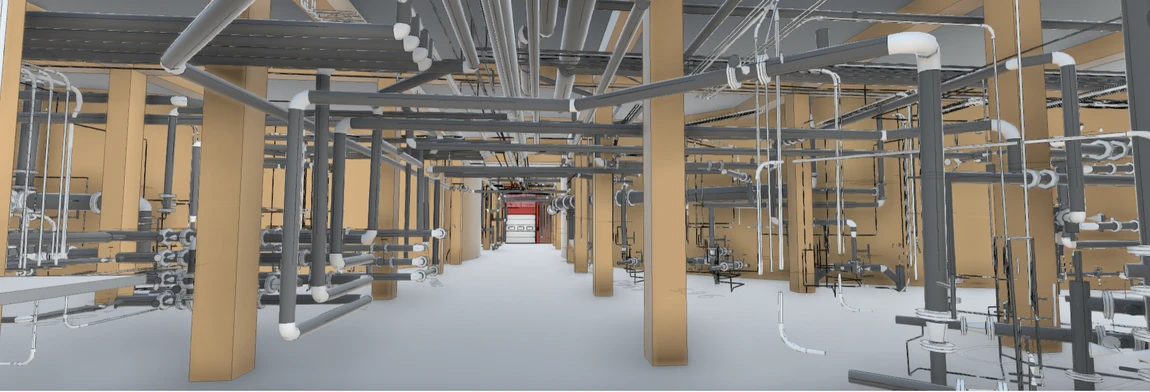
What Types of Equipment Can Be Used for 3D Laser Scanning?
Terrestrial Laser Scanners
Terrestrial Laser Scanning (TLS) uses stationary, tripod-mounted 3D laser scanners. These scanners send out laser pulses to capture millions of accurate 3D points of objects, buildings, or sites. They are often used for the reality capture of building interiors, structural steel, façades, and other projects that require high accuracy. These systems typically achieve an accuracy of ±2–5 mm at ranges of 10–30 meters, which is why they’re commonly used in situations requiring exact measurements. Terrestrial 3D laser scanners include Leica Geosystems, FARO Focus series, and RIEGL VZ series, Trimble, and Topcon.
Mobile Mapping Systems
Mobile Laser Scanning (MLS) and SLAM-based systems fit into mobile platforms. These include handheld devices, backpacks, and vehicle-mounted scanners. Mobile Laser Scanning (MLS) and SLAM-based systems use special tools. These include a laser scanner (LiDAR sensor), an Inertial Measurement Unit (IMU), and often a Global Navigation Satellite System (GNSS). They gather real-time 3D point clouds. Then, they combine the scanner's position with the environment's structure to create maps. This approach is best suited for large interiors, complex layouts, and projects where speed is more important than sub-millimeter accuracy. Accuracy generally falls in the ±10–30 mm range, depending on control and loop closures. Mobile mapping systems include the NavVis VLX, FARO, Leica Geosystems, GeoSLAM, Trimble, Artec, and Riegl.
Aerial LiDAR
Aerial LiDAR is deployed via drones or aircrafts to capture terrain, roofs, and large outdoor areas efficiently. Aerial LiDAR is commonly used for site surveys and topographic mapping. Accuracy typically ranges from ±20–50 mm, influenced by altitude and GNSS quality. Examples of aerial LiDAR systems include the DJI L1 and RIEGL’s airborne platforms.
Photogrammetry
Photogrammetry uses high-resolution overlapping photographs processed with specialized software to generate 3D models and point clouds. While it is generally less accurate than LiDAR, offering ±20–50 mm accuracy, it is cost-effective and ideal for capturing interior layouts and floor plans where ultra-high precision is not required. Photogrammetry is often combined with drone platforms for rapid coverage and can be enhanced with survey control points to improve accuracy. Brands offering stationary LiDAR photogrammetry are Leica Geosystems, FARO, RIEGL, Artec 3D, and Matterport.
If you need the highest accuracy for prefabrication or clash detection, terrestrial laser scanning with survey control is the best choice. But if speed and coverage across large interiors matters more, mobile laser scanning can deliver better efficiency, provided everyone understands its accuracy limits and follows proper quality checks. For expansive sites, aerial LiDAR offers rapid data capture over large or inaccessible areas.
Read more about the equipment used for 3D laser scanning.
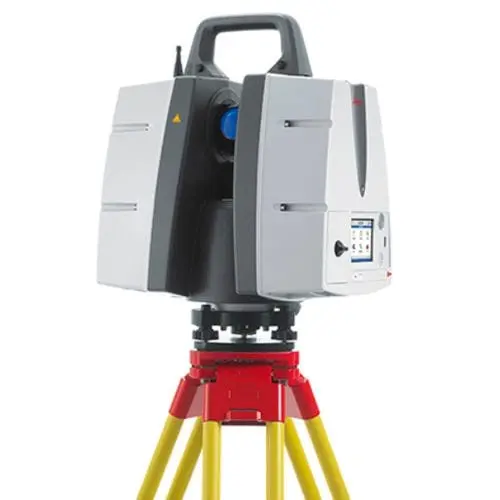
Why Do Architects, Engineers, General Contractors, and Facility Managers Choose 3D Laser Scanning?
AEC companies choose 3D scanning for its unmatched precision, speed, and versatility, which leads to significant cost savings and more efficient workflows across a range of applications. The technology digitizes physical objects into highly accurate point clouds, CAD drawings, and 3D models, enabling companies to reduce errors and accelerate project lifecycles.
General contractors often turn to 3D scanning to keep projects on schedule and minimize disruption. Mobile scanning systems can capture large areas quickly, even during off-hours, while high-precision tripod-based scanning is reserved for tasks that demand tight tolerances, like verifying embeds or prefabricated components.
Engineers value 3D laser scanning for its accuracy and traceability, using it to confirm structural alignment, check flatness, and generate reliable data for analysis.
Architects rely on 3D laser scanning to document existing conditions and ensure their models reflect reality, which helps to avoid design conflicts later.
For facility managers, 3D laser scanning creates a detailed digital record of the building, supports asset tracking, and provides a foundation for digital twins, making future maintenance and renovations far easier.
Each role uses scanning to reduce risk, improve coordination, and make better decisions with confidence.
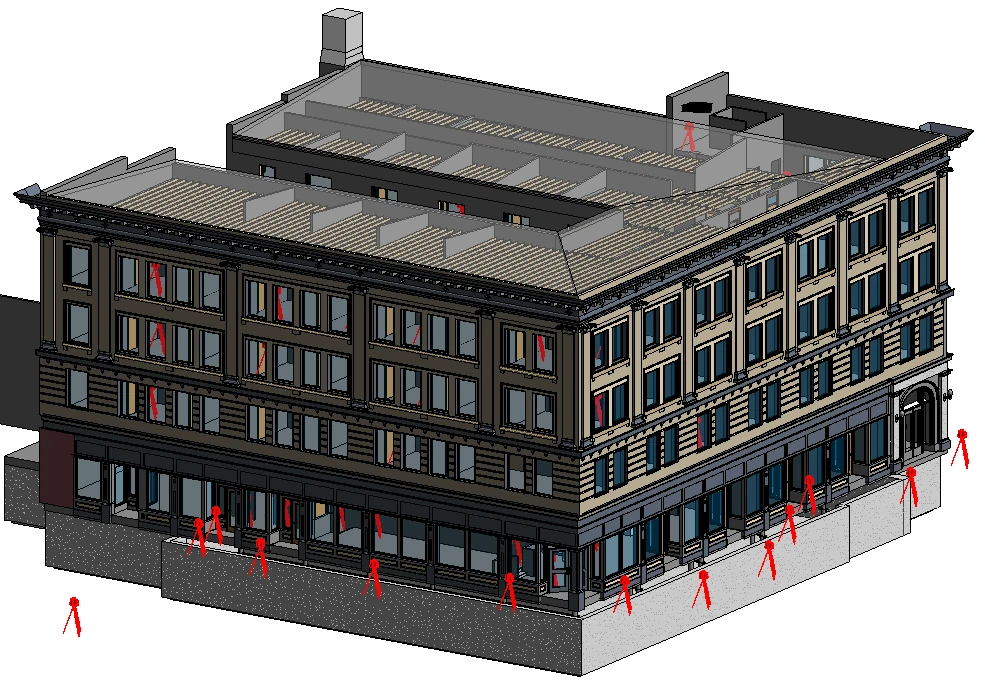
How Can GPRS 3D Laser Scanning Services Help You?
The key to maximizing the value of 3D laser scanning lies in aligning the scanning approach with the specific use case.
You can trust the GPRS team to provide the best experience in laser scanning by walking you through the entire 3D laser scanning process from pre-planning to project completion.
We offer a consultative approach to project management, working with you to ensure our data, maps, and models are the perfect solution for your project. The data delivered is accurate within millimeters, and the maps and models provide complete as-built and location data.
GPRS serves a wide variety of industries, including architecture, engineering, design, construction, oil & gas, facility management, historical preservation, stadium & theater, education, healthcare, water & wastewater, energy & utilities, and multimedia & entertainment industries.
Our elite team of Project Managers must complete an extensive training program before they perform field services on your job site. The program includes 80 hours in the classroom, more than 320 hours of field mentorship, and 40 hours of specialized LiDAR training. This ensures mastery of top Leica equipment and techniques. Project Managers gain practical experience at a dedicated training facility in Ohio and learn the full scope of the 3D laser scanning process, from project planning to final data delivery.
At GPRS, we ensure you have all the information you need to get the job done right, delivering accurate as built data to expedite project planning and reduce change orders, delays, and costs.
What can we help you visualize?
Frequently Asked Questions On 3D Laser Scanning
Reality capture is a powerful tool used across the construction, architecture, and engineering industries. At GPRS, we hear from clients who want to gain a deeper understanding of the technology, its applications, and how it fits into their projects. That’s why we’ve compiled answers to the most commonly asked questions about 3D laser scanning, LiDAR, BIM, digital twins, and more. Whether you’re a beginner or want to expand its use, you'll find explanations to make informed decisions.
WHAT IS LIDAR?
LiDAR (Light Detection and Ranging) is a remote sensing tool that builds accurate 3D models of objects and surfaces. Instead of using radio waves like radar, LiDAR sends out laser pulses from a scanner. These light pulses bounce off objects, and the system measures how long they take to return. This helps calculate exact distances and shapes. It creates detailed three-dimensional data about an object.
WHAT IS THE DIFFERENCE BETWEEN LIDAR (TIME-OF-FLIGHT) AND PHASE-BASED SCANNING?
LiDAR systems operate using the time-of-flight method. This approach involves emitting short laser pulses toward a beam, then measuring the time it takes for the reflected signal to return. Using the known speed of light, we calculate the distance to the object as:
Distance = (Speed of Light × Time of Flight) / 2.
Time-of-flight LiDAR works well for long-range measurements. But it generally gathers data at a slower rate than phase-based systems.
Phase-based laser scanners work by sending out a steady laser beam modulated in many phases. The system measures distance by looking at the phase difference between emitted and reflected signals. It uses this formula:
Distance = Phase Shift / (2π × Modulation Frequency).
This method allows for faster data capture but has a limited range compared to time-of-flight systems. Phase-based scanning tends to have more “noise” or false data compared to time-of-flight scanners.
WHAT IS 3D LASER SCANNING?
3D laser scanning uses LiDAR to measure precise distances and locations. It creates a point cloud file, which is a digital map made of millions of points. This helps you get accurate measurements and images of buildings in a short period of time. 3D laser scanning is a modern tool to document existing conditions. This supports your work in design, construction, prefabrication, facility changes, and asset management.
WHAT IS REALITY CAPTURE, EXACTLY?
Reality capture utilizes tools like 3D laser scanning and photogrammetry. These tools create a precise digital record of existing conditions.
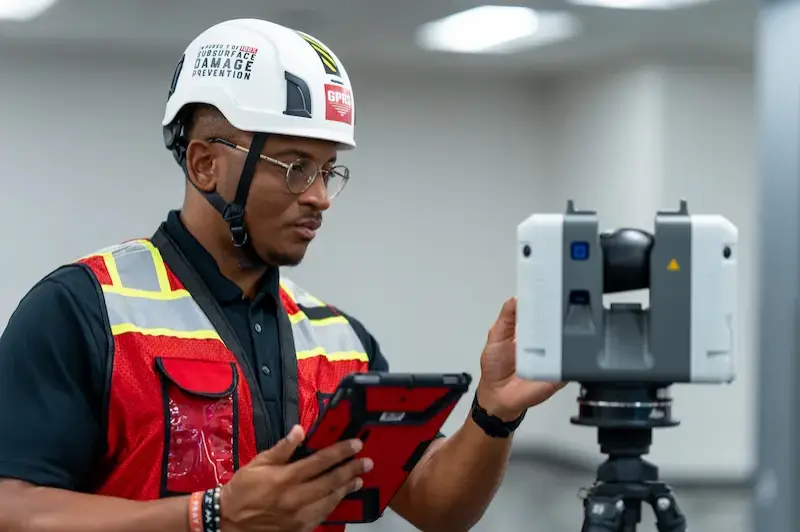
HOW DOES GPRS CONDUCT REALITY CAPTURE SERVICES?
GPRS captures millions of precise data points at any site to document existing conditions in detail. We process this data into point clouds. Then, it transforms into 2D CAD drawings or 3D BIM models, depending on the client’s needs. This enables accurate planning and easy coordination across all disciplines.
WHAT IS A BIM OR A 3D BIM MODEL?
A Building Information Model (BIM) is a digital representation of a facility’s physical and functional characteristics.

WHAT IS A DIGITAL TWIN?
A digital twin is a complex virtual model. It serves as the exact twin (counterpart) of a physical object. GPRS uses 3D laser scanners to collect real-time data, which helps create a digital twin of a building or facility. You can easily visualize, measure, and analyze data. Digital twins can also be used to improve efficiencies, optimize workflows, and detect problems before they occur.
ARE REALITY CAPTURE AND A DIGITAL TWIN THE SAME THING?
Reality capture is the process of collecting spatial data from the physical world. A digital twin is a dynamic, data-rich virtual model of a physical asset. It integrates real-time information and analytics.
Reality capture provides the geometric foundation for building a digital twin. GPRS delivers both, tailored to your project’s needs.
WHAT IS AS-BUILT DOCUMENTATION?
As-built 3D documentation is a clear and accurate set of drawings that show how a project was actually built.

HOW ACCURATE IS GPRS REALITY CAPTURE?
GPRS delivers construction-grade precision through high-resolution LiDAR scanning. This is in combination with survey-grade control and registration techniques. Accuracy depends on site conditions and equipment. Our usual tolerances are between 2 and 6 millimeters. This accuracy is more than sufficient for clash detection, prefabrication, and as-built documentation.
WHAT IS 3D PHOTOGRAMMETRY?
3D photogrammetry reconstructs three-dimensional models by analyzing overlapping photographs captured from various angles. Using computer vision algorithms, it triangulates spatial coordinates. This is also known as orthomosaic imaging and registration. It helps to generate 3D meshes, point clouds, or virtual walkthroughs for visualization and measurement.
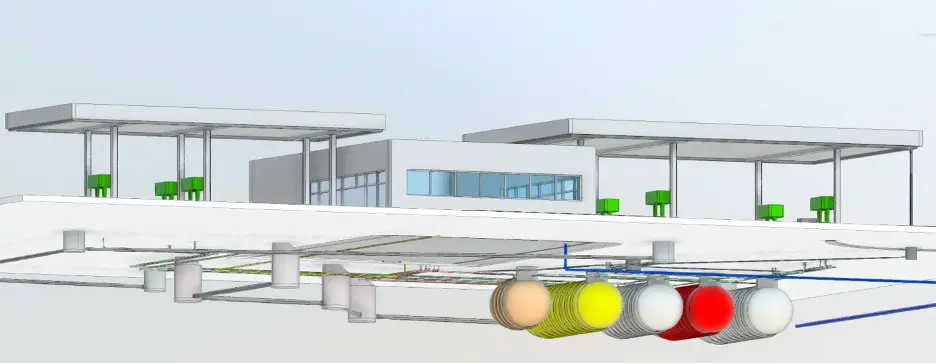
WHAT IS ARTIFICIAL INTELLIGENCE (AI) AND MACHINE LEARNING IN RELATION TO LASER SCANNING?
If you use laser scanning in your workflow, CAD technicians will turn your point cloud data into useful drawings or models. Many software tools help by automatically sorting and cleaning the data. In this field, that process is often called “artificial intelligence” or “machine learning.” AI’s software makes decisions or classifications that are usually done by humans. Machine learning is when software improves at tasks by practicing. It relies on human input and training.
CAN YOU USE WORKSETS?
Yes, we can use worksets and attach different components based on what the client prefers. According to Autodesk, “a workset is a collection of elements in a workshared project.’
CAN YOU TIE THE POINT CLOUD DATA TO LAND SURVEY CONTROL?
GPRS does not perform land surveys or Subsurface Utility Engineering (SUE) surveys. However, we support your survey team by providing high-quality SUE Level B mapping and utility locating services. When we use LiDAR-based 3D laser scanning, you can expect accuracy between 2 and 6 millimeters. If you provide proper documentation, including the location and coordinates (x, y, z) of control points, we can attach point cloud data to survey control.
DO WE NEED TO PLACE TARGETS DURING 3D LASER SCANNING?
Targets – black and white markers placed on tripods, are sometimes used to help align scan data. We place these at known control points and scan them to help the software match and correct the data. GPRS mainly uses scanners that don’t need targets. But we do use them in certain cases:
- Survey Control: When linking scans to client-provided survey data.
- Multiple Scanners: When combining data from different scanners, targets help align multiple datasets.
Targets align scan data with control points or global coordinates. They also help ensure the precise registration of data from multiple 3D laser scanners.
CAN YOU USE MY REVIT TEMPLATE AND FAMILIES?
Before the GPRS Reality Capture Team issues a project proposal, our consultative sales team will confirm whether your deliverables need to be developed within a specific Revit template. The GPRS Mapping & Modeling Team can work within client-provided templates. This ensures that your project can proceed immediately upon delivery of the 3D BIM model. Make sure we receive your Revit template before modeling begins.
CAN YOU DETECT IF MY FLOOR IS UNEVEN?
Floor deformation mapping is a service we provide to determine the levelness of the floor using a “topographic-like" 2D CAD file. The 2D CAD file is then merged within the Revit model.
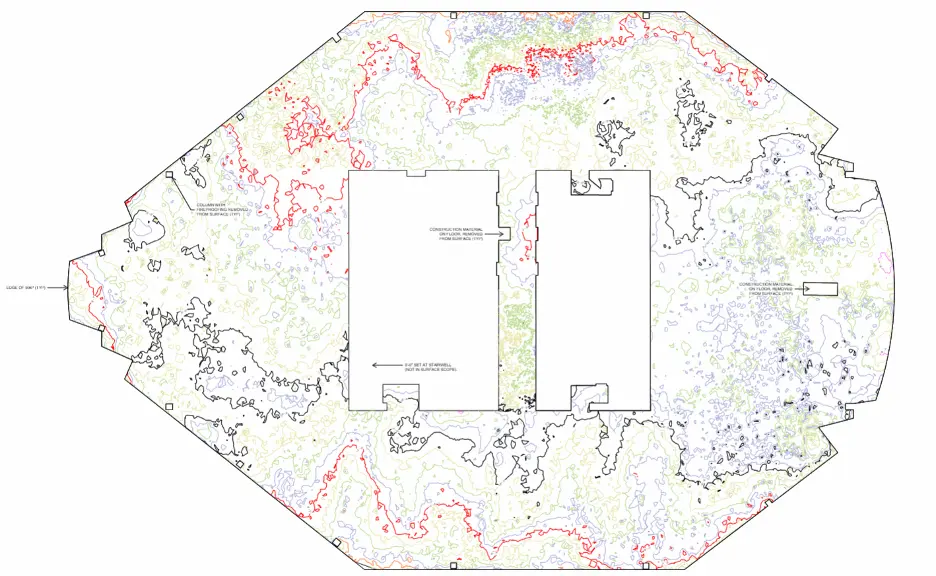
CAN YOU MODEL THE SIDEWALKS AND THE SITE?
Modeling sites is possible if it is within the scope of work. This can include components like sidewalks, ramps, stairs, and parking lots. It’s best to discuss these in the early project phase to include them in the scope of work. Sometimes a client may only want to model just the sidewalk. Or sometimes the client wants the sidewalk and parking areas to be modeled. We can model a site, but the word "site" is too broad. We will need to get specific about what the client wants modeled.
CAN YOU EXPORT A REVIT FILE TO MY PREFERRED FORMAT?
All GPRS’s modeling takes place within Revit. We can export our models into various formats like DWG, DXF, DGN, SAT, PLN, OBJ, and PDF. These are all file types supported by Revit.
CAN I SHARE PROJECT FILES WITH MY TEAM?
Upon delivery by the GPRS Mapping & Modeling Team, the model belongs to the client. They have rights to share or distribute it as they wish.
IS THERE A SOFTWARE THAT DOES ALL THE MODELING FOR YOU?
At present, no software exists that can provide models with complete accuracy. The GPRS Mapping & Modeling Team models each wall, floor, door, and window with precision.
CONSIDERING PURCHASING A LIDAR SYSTEM?
When buying a laser scanner, the cost isn’t just the price of the machine. You also need to pay for qualified personnel, special software, training programs, scanner calibration, and even legal fees. Before you buy, make sure you understand the real cost of owning a scanner. Often, hiring a qualified professional can save you money and ensure the job is done right.
WHAT IS THE COST OF LASER SCANNING VS. THE COST OF TRADITIONAL MEANS TO “AS-BUILT” ON A SITE?
Weighing the benefits of laser scanning versus using traditional means to “as-built” a site:
- Safer – No need for lifts, harnesses, or other high-risk equipment
- Faster – The process requires fewer people and allows scanning of a larger area in less time
- Lower Costs – Reduces extra site visits for missed measurements
- Saves Time – You focus on what you do best, while scanning happens on-site
- Cost Savings – Cuts travel expenses, lift rentals, and errors from manual measurements
- Streamlines Workflow – Deliverables are ready for immediate use, speeding up your project start
WHAT ARE YOUR NAICS CODES, SIC CODES, CSI CODES, PSC, AND FSC CODES?
GPRS Reality Capture Services fall into the following categories:
NAICS Codes:
- 541370 Surveying and Mapping
- 541330 Engineering Services
- 541340 Drafting Services
- 541690 Other Scientific and Technical Consulting Services
SIC Codes:
- 87130000 Surveying Service
CSI Codes:
- 2073 3D Laser Scanning and Dimensional Survey
PSC and FSC Codes:
- C217 Mapping
- C218 Architectural and Engineering Services
- 1550 Drones
- 6675 Drafting, Surveying, and Mapping Instruments
- R425 Engineering and Technical Services
- R617 Data Collection Services
WHAT IS THE DIFFERENCE BETWEEN A “DESIGN INTENT” AND “AS-BUILT MODEL?”
- DESIGN INTENT – these models align with standard design practices. A few examples include walls positioned at 90° to floors, straight pipes and conduits, and level floors and ceilings. This approach produces cleaner 2D drawings and simplifies dimensioning. It does not exactly follow the scan data, but is ideal for most clients who need standard deliverables.
- AS-BUILTS – deliverables will match actual site conditions with a high degree of accuracy. This creates a true reality-capture representation. If walls lean, pipes sag, floors slope, or steel shows camber, these issues will show up in the model. Dimensioning can also be more challenging because elements are not perfectly level or plumb. Leverage this option when the exact conditions of the scan area are critical. Clients utilizing the data for fabrication, forensic analysis, bolt hole patterns, camber/sag/deformation analysis, and similar needs would need this option.
WHAT CAD AND BIM SOFTWARE DOES GPRS USE?
Our engineers and CAD technicians are trained in the following software:
- Autodesk Recap
- Autodesk Revit
- Autodesk 3DS Max
- Autodesk Navisworks
- Autodesk AutoCADCivil 3D
- Autodesk AutoCAD Map 3D
- Autodesk BIM 360
- Autodesk A360
- Autodesk Recap
- AutoCAD
- ArchiCAD
- Bentley MicroStation
- Bentley Descrates V8i
- ClearEdge 3D Edgewise
- Leica Cyclone
- FARO As-Built
- FARO Scene
- Scene 2go
- Scene Webshare
- AVEVA LFM
- Cintoo
- CloudCompare
- Unreal Engine
- FileZilla
- ShareFile
- Dropbox
- Register 360
- JetStream Viewer
- TruView
WHAT IF MY PROJECT IS LIMITED WITHIN THE PHYSICAL SETTING?
Certain projects need specialized scanning approaches due to physical constraints. These limits often arise from obstructed lines of sight or the need to scan from secure, ground-level spots. Laser scanning has a clear advantage. It’s a non-contact method, so it captures data from a safe distance. This way, it doesn’t disturb sensitive areas.
Examples include above-ceiling mechanical, electrical, and plumbing (MEP) systems in healthcare facilities. Here, keeping negative airflow is crucial.
Another example is interstitial spaces that are packed tightly and hard to reach. In these cases, laser scanning reliably provides accurate spatial data and minimizes disruption.
WHAT IS SLAM?
SLAM (Simultaneous Localization and Mapping) is a computational method used to navigate and digitally reconstruct a physical environment. Its core function is to determine the scanner’s position relative to its surroundings (localization). It also concurrently generates a spatial map of the area (mapping).
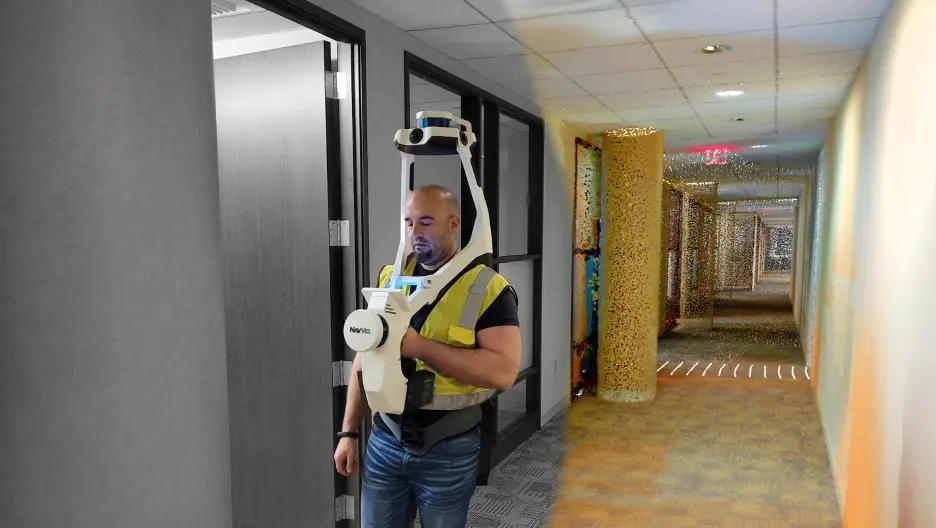
WHAT ARE THE BENEFITS OF 3D LASER SCANNING?
- Millions of real-world data points – A single laser captures up to one million 3D data points every second. This allows for detailed and thorough documentation of physical environments.
- Eliminate error – Manual tools like tape measures or handheld devices can lead to human error. Laser scanning provides sub-centimeter accuracy. This makes it the most reliable way to capture dimensional data.
- Answers unanticipated questions – Laser scanning gathers extensive spatial data in one site visit. This lowers the chances of missing measurements. It also cuts out extra trips to collect more data.
- Reduce change orders and waste – Using laser scan data in design ensures accurate spatial coordination. This minimizes construction conflicts, cuts change orders, and reduces unnecessary material use.
- Minimize shutdown times – Laser scanning is quick, safe, and non-intrusive. It eliminates and minimizes operational shutdowns and client inconvenience.
- Increase safety – The scanning is quick and non-invasive. It can occur without disrupting ongoing operations. Thus, scanning minimizes downtime and client inconvenience.
IS 3D LASER SCANNING RIGHT FOR MY PROJECT?
Almost any project that needs as-built information benefits from 3D laser scanning. Talk with our experts and begin your existing conditions survey today.
WHAT INDUSTRIES DOES GPRS SERVE?
GPRS provides reliable 3D laser scanning and modeling services. We service hundreds of clients across various industries. Our team focuses on accuracy, professionalism, and strong client service. We collaborate with each client to deliver detailed point clouds, 2D CAD drawings, and 3D BIM models.
Our scanning services are designed to support a wide range of industries, offering clear and accurate digital models that help you plan, build, and manage better. We offer 3D laser scanning services to the following industries:
- Agricultural Facilities
- Architectural Documentation
- Concrete Construction
- Construction
- Clash Detection
- Design Build
- Energy & Utilities
- Engineering
- Government, Defense & Military Sector
- Healthcare & Pharmaceutical
- Historical Documentation & Preservation
- HVAC & MEP Coordination
- Industrial, Manufacturing, Assembly & Distribution Facilities
- Mixed Reality & 3D Projection Mapping
- Office & Commercial Buildings
- Overhead Clearances
- Oil & Gas Facilities
- Power Plants & Process Plants
- Real Estate
- Stadiums, Arenas & Theatres
- Telecommunications
- Schools & Universities
- Subsurface Utility Engineering
- Virtual Design and Construction
- Water & Wastewater Treatment Plant
- Accident Reconstruction
- 3D Video Gaming & Software Development
IS GPRS AN EXPERIENCED COMPANY?
GPRS is a highly experienced provider of 3D laser scanning services. We have completed scanning and modeling projects across many industries. Our teams can deploy quickly to any location in the United States. GPRS has worked with some of the top leading firms to scan industrial plants, oil and gas sites, historic buildings, stadiums, hospitals, universities, municipal facilities, wastewater treatment plants, new construction projects, and more.
We are a licensed engineering firm that focuses entirely on 3D laser scanning. GPRS uses in-house technicians and engineers to provide a detailed review of site conditions. Then they create customized deliverables such as point clouds, 2D CAD drawings, and 3D BIM models tailored to the client’s needs.
WHAT DELIVERABLES CAN GPRS PROVIDE?
We can deliver 3D laser scan data in many formats, including:
- Point Cloud Data (Raw Data)
- 2D CAD Drawings
- 3D Non-Intelligent Models
- 3D BIM Models
- TruView (previously known as JetStream) Viewer
CUSTOMIZABLE DELIVERABLES UPON REQUEST
- Aerial Photogrammetry
- Comparative Analysis
- Deformation Analysis
- Digital Drawings of GPR Markings
- Floor Flatness Analysis/Contour Mapping
- New Construction Accuracy Analysis/Comparative Analysis
- Point Cloud Modeling Training Webinars
- Reconciliation of Clients 2D Design Drawings
- Reconciliation of Clients 3D Design Model
- Structural Steel Shape Probability Analysis
- Template Modeling
- Volume Calculations
- Wall Plumb Analysis
IS NATIONWIDE SERVICE AVAILABLE?
GPRS serves a diverse client base, ranging from small firms to multinational corporations. GPRS is ready to mobilize to any site in the United States, typically within the lead time of 24-48 hours. Additionally, we can be on-site, short-term or long-term, based on our clients' specifications.
WHAT IS HIGH-DEFINITION SCANNING?
GPRS uses construction-grade 3D laser scanners. These tools collect accurate data in many environments, including buildings, hospitals, schools, and industrial sites. This technology works well on structures of any size or surface feature. We can quickly scan large areas and deliver detailed 3D models. These scans help document current conditions. They also aid in planning renovations and checking construction progress to match the design.
WHY IS A POINT CLOUD IMPORTANT?
Point clouds are a key source of spatial data for many projects. They store millions of coordinates. Users can extract large datasets for information.
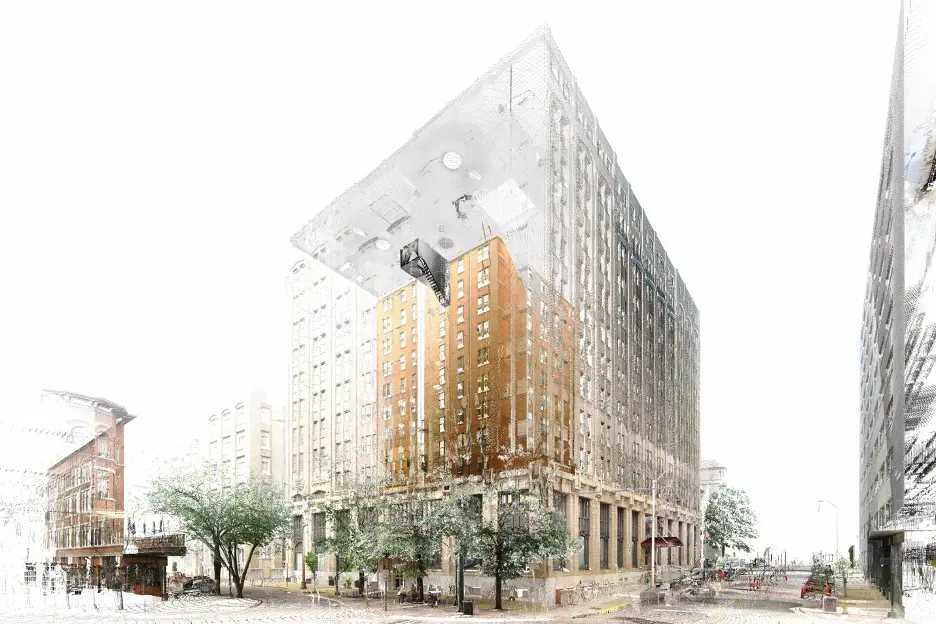
HOW LONG DOES 3D LASER SCANNING TAKE?
GPRS has Project Managers across the country, allowing us to respond quickly with detailed quotes. Most jobs can be scanned in just a few hours, while larger sites may take a few days. Scanning entire facilities or campuses can take weeks. Yet, most projects are complete in hours or days.
HOW IS 3D LASER SCAN DATA REGISTERED?
The registration process is a collaborative effort. Registering a 3D laser scan point cloud involves aligning multiple scans of the same area taken from different positions into a single, coherent point cloud. This typically involves using specialized software like Autodesk Recap to import the data and align the scans. The Mapping & Modeling Team uses the software to spot overlapping areas in different scans. It captures the same physical features from slightly different angles. This helps the software identify corresponding points.
Unwanted “noise” can be cleaned or deleted from the point cloud. Autodesk Recap software can remove unwanted data or noise. This includes reflections, moving objects, and background clutter. As a result, it creates a clean point cloud that shows the target project area. Proper registration makes sure 3D laser scan measurements are accurate. This data can be exported for use in CAD or BIM software like Revit or AutoCAD.
HOW IS 3D LASER SCAN DATA PROCESSED?
Once a site is scanned, we process the raw point cloud data by combining individual scans. We remove unwanted noise and convert the data into usable formats like 2D drawings or 3D models. The level of detail depends on the project’s needs, ranging from basic visuals to complex models. GPRS follows a structured workflow focused on accuracy, teamwork, and planning. We ensure efficient project execution. Our deliverables are high-quality and tailored to each client's needs.
WHY WORK WITH GPRS?
Many of our clients are new to laser scanning, so we guide them through every step, from pre-planning to final deliverables. This hands-on support is one reason we’ve earned the trust of top companies and institutions across the country.
We understand you have choices: buying or renting equipment, or hiring another provider. But GPRS offers key advantages that set us apart:
- Cutting-edge technology – GPRS utilizes the most up-to-date technology, equipment, and software.
- Industry trends – Laser scanning is a fast-changing field. Since it’s our main focus, we stay current with new methods and tools, so you don’t have to.
- Training – GPRS technicians receive formal training from the scanner manufacturer. They also get thorough coaching from a seasoned in-house technician. Furthermore, because our team of professionals is committed entirely to scanning and processing the data, we have developed the steps to work quickly, accurately, and knowledgeably.
- Expertise – Our GPRS team brings combined expertise to every project in multiple disciplines, including engineering, architecture, information technology, and construction. This knowledge combination helps us give our clients excellent service and top-quality deliverables.
- Professional support – While our field team handles scanning, our office team is ready to answer questions and help when needed.
- Client-focused approach – We listen carefully to your goals and often suggest ideas to add value to our service.
GPRS 3D REALITY CAPTURE SERVICES
GPRS is a leading 3D laser scanning company in the United States, helping clients to successfully complete their most complex architecture, engineering, and construction projects. We've been providing reality capture services and excellent customer service for over two decades.
GPRS’s elite team of Project Managers efficiently 3D laser scans the exterior and interior of each site with professional-grade laser scanners, capturing the exact layout, dimensions, and locations of your specific project requirements. This includes architectural, structural, and MEP features, walls, windows, doors, stairs, roof, railings, exposed columns, beams, equipment, piping, ducts, and more.
Our Mapping & Modeling Team registers and processes the point cloud, removing noise and setting the coordinate system to provide the most precise measurements. Data is then compiled into custom 2D CAD drawings and 3D BIM models and delivered via SiteMap®. SiteMap is GPRS’ secure GIS platform that delivers point cloud data, 2D CAD drawings, and 3D BIM models, giving clients 24/7 access to verified as-built documentation to help start accurate and stay accurate.
GPRS Reality Capture Services Expedite Upgrades to Hydroelectric Dam
GPRS Reality Capture Services collected accurate, actionable data to expedite upgrades to a nearly 100-year-old hydroelectric dam.
Project Manager Dean Sturt was called out to the dam to conduct 3D laser scans of its two powerhouses, in preparation for upcoming renovations.
Situated at the foot of the dam, the powerhouses are each multi-story buildings densely packed with complex mechanical and electrical systems. There were no existing, accurate plans of the buildings. The project team needed to know exactly where every pipe, transformer and structural element was inside each of the powerhouses to effectively plan upgrades to the facility.
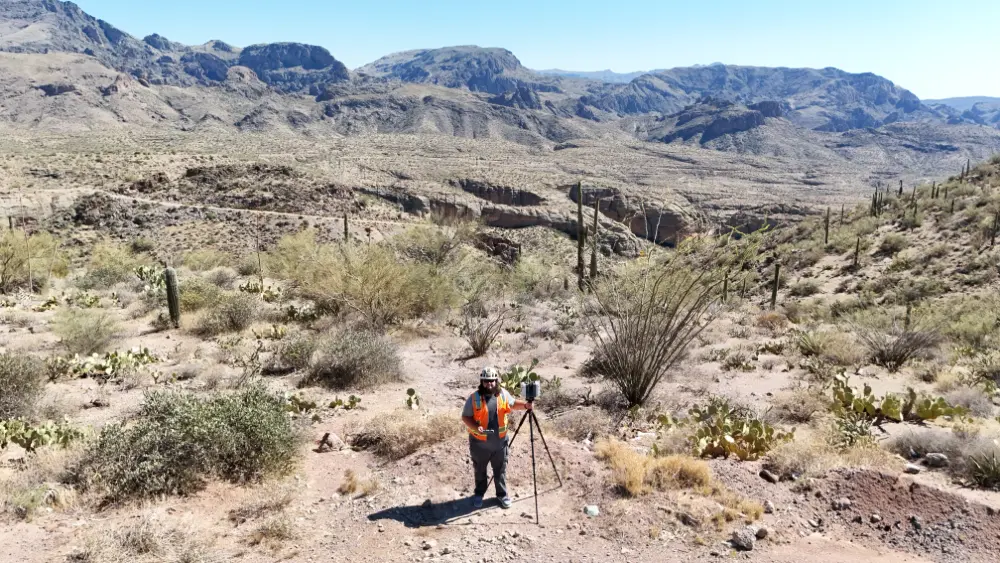
Accurate, real-time as-built data is essential for informed decision-making and seamless collaboration. With precise design plans from the start, architects, contractors, engineers, and facilities managers can streamline fieldwork and minimize change orders, plus avoid delays and extra costs.
GPRS 3D Laser Scanning Services provide clients with precise as-built documentation of buildings and infrastructure using advanced Leica laser scanners, delivering point clouds, 2D CAD drawings, and 3D BIM models to streamline project planning and construction.
GPRS Project Managers begin every project by speaking with on-site personnel and conducting a site walk to understand the unique elements of the project they’re about to begin. Sturt spent three hours walking the dam with its operations team.
“We walked it top-to-bottom, the whole facility, just so that I could mentally game plan where to start, how many floors there were, etc.,” he said. “They didn’t have any plans of the facility to start from, so it wasn’t like going into it I already had a base to go off. So, I walked it with those guys, asked a lot of questions.”
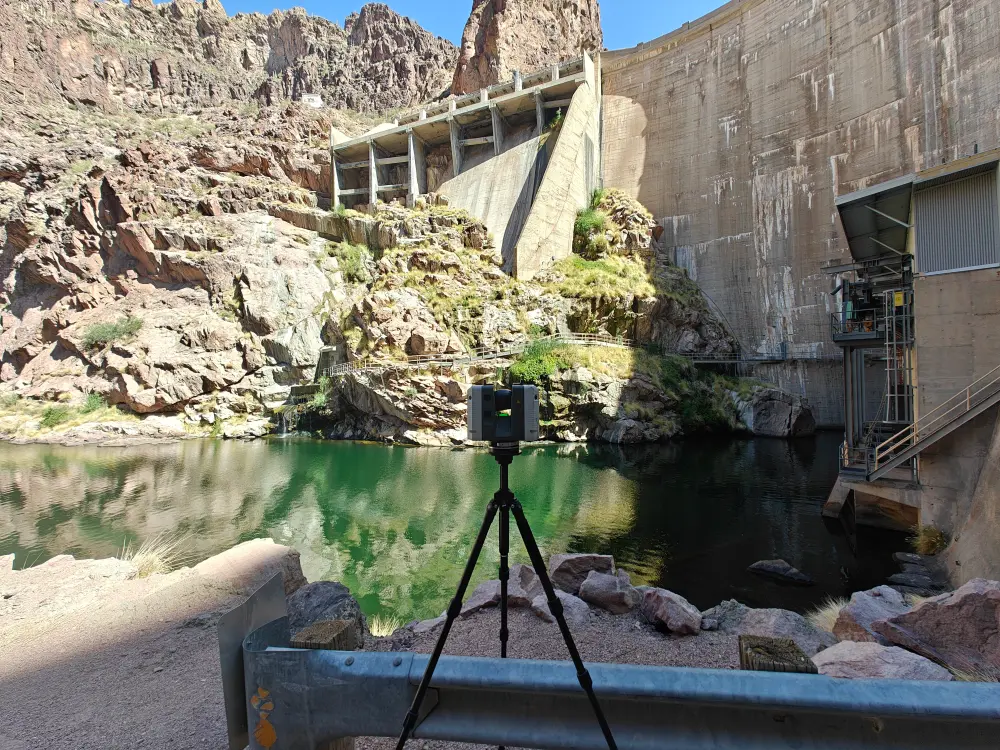
Over the next several days, Sturt scanned every inch of the two powerhouses and surrounding structure, capturing the accurate data necessary to create the as-built documents the client required.
“It was a little daunting at first, just those dense areas, a lot going on in kind of a small space,” he said. “But as you start going through it, it made a lot more sense.”
The point cloud data generated from Sturt’s scans was turned over to GPRS’ in-house Mapping & Modeling Team, where it was used to build a 3D model, virtual walkthrough, and 2D floor plans of the dam’s power infrastructure.
Our Mapping & Modeling Team can create anything from a simple GPS-enables locating map of your utility locate, to highly detailed 2D CAD drawings and 3D BIM models, depending on your needs.
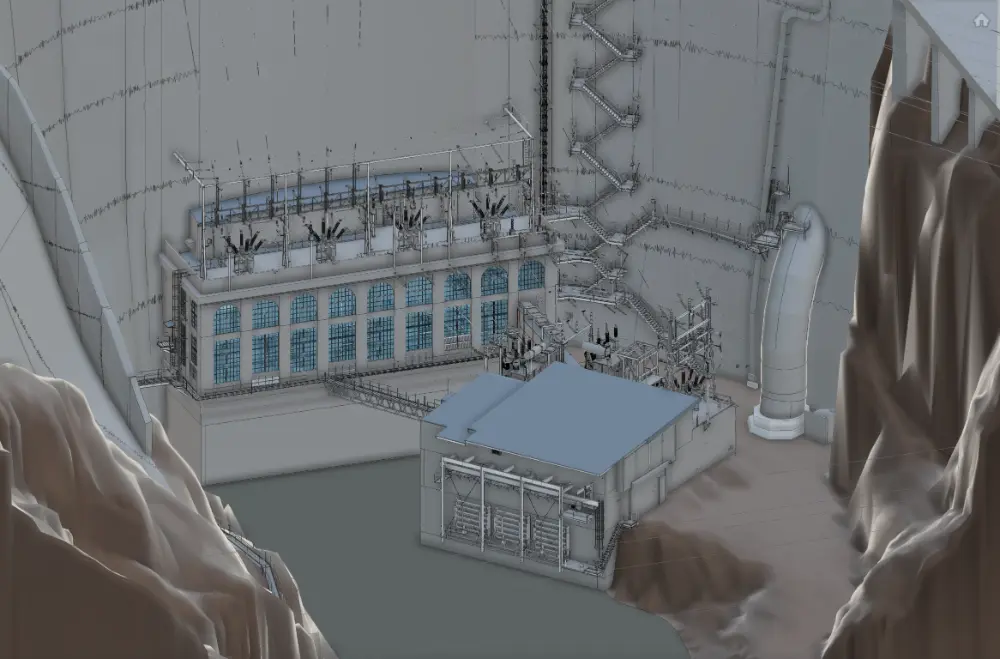
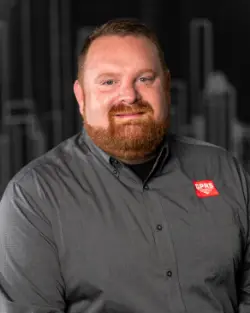
“[The customer] wanted a full 3D model of both powerhouses, so the additional topography and the rest of the dam [shown in the deliverables] is pretty much just for reference,” explained GPRS Senior Modeling Technician Nate Nowels. “We were responsible for modeling all the equipment structural components, and all the architectural features… It was structural beams, columns, trusses, all the architectural elements, and then into the mechanical systems. So, ducts, the footprints of actual equipment, we got pipes and all that kind of stuff, valves, actuators, everything… All the mechanical items were captures.”
Nowels said that modeling the complex mechanical systems inside the powerhouses did present its own unique set of challenges.
“There were pieces of equipment that ran through multiple floors,” he explained. “With a lot of factories, you’ll have some equipment that runs from, say, level one to level two. But in powerhouse two, for example, there’s a turbine that runs all the way down into the water and then up through multiple layers. It’s a very unique object to model; it has lots of mechanical piping going in and out of it.
“It’s multiple levels of a piece of equipment running through multiple floors…,” Nowels continued. “You wouldn’t want your entry level engineer or designer on it. You need to have extensive knowledge of the [modeling] software, for sure.”
The data provided to the client by GPRS will allow them to accurately and efficiently plan their upgrades to the hydroelectric dam.
“They have nice existing condition documentation of [this equipment on] the day that we scanned it,” Nowels said. “And they’re able to tie into all the mechanical systems, HVAC systems, and add on however they need to add on.”
GPRS turns your built world into easily accessible and accurate data.
What can we help you visualize?
Frequently Asked Questions
How is 3D laser scan data registered?
The registration process is a collaborative effort. Registering a 3D laser scan point cloud involves aligning multiple scans of the same area taken from different positions into a single, coherent point cloud. This typically involves using specialized software like Autodesk Recap to import the data and align the scans. The Mapping & Modeling Team uses the software to find overlapping areas between different scans where the same physical features are captured from slightly different angles, allowing the software to identify corresponding points.
Silbaugh says unwanted “noise” can be cleaned or deleted from the point cloud. Autodesk Recap software can isolate and delete extraneous data or noise, such as reflections, moving objects, or background clutter, leaving behind a refined point cloud representing the desired project area. Proper registration ensures that measurements taken from the 3D laser scans are accurate and the data can be exported for use in CAD or BIM applications like Revit or AutoCAD.
How long does laser scanning take?
With Project Managers all over the U.S., we work quickly to provide detailed quotes for clients. For most jobs, large areas can be laser scanned in as little as a couple of hours or larger sites in as little as a few days. Entire facilities or campuses can take several weeks to capture the entire site, but most projects are measured in hours or days.
Data Centers Continue to Fuel Construction Planning Growth
Data center activity continues to fuel construction planning growth, according to a recent report released by the Dodge Construction Network.
The Dodge Momentum Index (DMI), a monthly measure of the value of nonresidential building projects entering the planning stage, grew 20.8% in July to 280.4 from the upwardly revised June reading of 232.1. Over the month, commercial planning grew 14.2% while institutional planning expanded 35.1%. Year-to-date, the DMI is up 27% from the average reading over the same period in 2024.
“Planning data skyrocketed in the month of July on the back of several large projects entering the planning queue for data centers, research & development labs, hospitals and service stations,” stated Sarah Martin, associate director of forecasting at Dodge Construction Network. “Combined with more organic momentum in planning for hotels, warehouses, and recreational projects, cumulative activity drove record highs in the DMI. After months of wait-and-see due to tariff uncertainty, owners and developers have begun to move forward with projects and assumed higher costs for them. As economic and fiscal uncertainty remains prevalent, volatility in planning activity will remain elevated.”
In July, all commercial sectors grew. Data centers and warehouses led this increase. MassDOT also committed over $700 million in planning for several service plaza construction projects across the state.

Most of the month’s growth came from the institutional sector. Planning activity jumped in education, healthcare, and public projects. Notably, the Hospital Corporation of America announced a series of hospital developments, contributing to a sharp increase in institutional planning.
Overall, the DMI rose 41% compared to July 2024. Commercial planning increased by 24% year-over-year, while institutional planning jumped 85%. Commercial planning saw a 26% increase from 2023 to 2025, even without including data center projects. This growth was mainly fueled by warehouse development.
In total, 47 projects valued at $100 million or more entered the planning phase in July.
Some of the biggest commercial projects include:
- The $500 million Fairview Connections Data Center in New Cumberland, Pennsylvania
- The $500 million Jabil AI Data Center in Salisbury, North Carolina
- The $460 million Peabody Union Hotel in Nashville, Tennesse
On the institutional side, major projects included:
- The $459 million ASM Campus R&D lab and office in Scottsdale, Arizona
- A $398 million R&D lab in San Diego, California
- The $380 million PPV Unaccompanied Housing/Navy Dormitory in Norfolk, Virginia
Why are Data Center Projects Booming?
As our world becomes increasingly connected, the demand for data centers is expected to grow significantly. To keep up with construction trends long-term, we must focus on sustainability. This means looking at energy use and the materials needed for building these facilities.
A data center is a central hub for computing and storing data. It supports shared applications and digital services. Smaller organizations may set up these operations in a room within their building. Larger companies, however, often have multiple standalone centers to handle their large data processing and storage needs.
The recent surge in data center construction across the U.S. can be largely traced back to the COVID-19 pandemic. As most Americans stayed home, online shopping soared. Companies like Amazon and Walmart quickly boosted their data infrastructure to handle the rising demand.
This growth remained robust post-pandemic and has continued despite ongoing concerns over the impact of tariffs. There are currently over 5,400 data centers operating in the U.S. – by far the most data centers operating in a single country in the world.
America's growing fleet of data centers needs a lot of power. This demand is putting more strain on our aging electrical grid.
The American Society of Civil Engineers gave America’s energy infrastructure a D+ in its 2025 Report Card on America’s Infrastructure.
ASCE said that electric vehicles (EVs) and data centers will need 35 gigawatts (GW) of electricity by 2030. This is a jump from 17 GW in 2022.
“This rapid acceleration, compounded by federal and state net-zero greenhouse gas emissions goals, means utilities will need to double existing transmission capacity to connect new renewable generation sources,” the report states. “Transmission investments have risen by $5 billion from 2017 to 2022, and the Infrastructure Investment and Jobs Act (IIJA) and Inflation Reduction Act (IRA) are supporting renewable technologies and grid hardening measures.”
GPRS delivers a comprehensive array of solutions for subsurface damage prevention, existing condition documentation, and management of construction and facility projects, ensuring that initiatives like data center builds remain on schedule, within budget, and safe.
What can we help you visualize?
Frequently Asked Questions
What is 3D Photogrammetry?
3D photogrammetry is a technique that uses overlapping photographs taken from multiple angles to reconstruct three-dimensional models. It relies on computer vision algorithms to triangulate spatial coordinates (also known as orthomosaic imaging and registration), to produce textured 3D meshes, walkthrough virtual tours or point clouds for visualization and measurement. GPRS can integrate subsurface feature markings via photogrammetry and integrate them into a full above and below-ground CAD drawing or BIM model, as required.
What are the benefits of utility locating?
Utility locating is a critical step in construction planning that helps prevent costly damage to underground infrastructure, enhances worker safety by avoiding hazardous utility strikes, and ensures compliance with regulatory standards. By accurately identifying the location of buried utilities, GPRS enables project teams to reduce legal liabilities, minimize delays caused by unexpected obstructions, and maintain efficient workflows. A thorough utility locating process supports safer, smarter, and more cost-effective construction execution.
Should You Rent, Buy, or Hire a GPR Service?
Should You Rent, Buy, or Hire a GPR Service?
If you're considering ground penetrating radar (GPR) for your next project, you are likely to have questions about how it works, what it can detect, and whether it's better to rent, buy, or hire a service. This guide breaks down the key considerations, so you can make an informed decision that fits your project’s needs, timeline, and budget.
What is Ground Penetrating Radar (GPR)?
GPR is a safe, non-destructive technology that uses radar pulses to detect and map subsurface features. It’s commonly used to locate underground utilities, scan concrete for embedded objects, and provide detailed imaging for a wide range of applications, from construction and engineering to telecommunications and facility management.
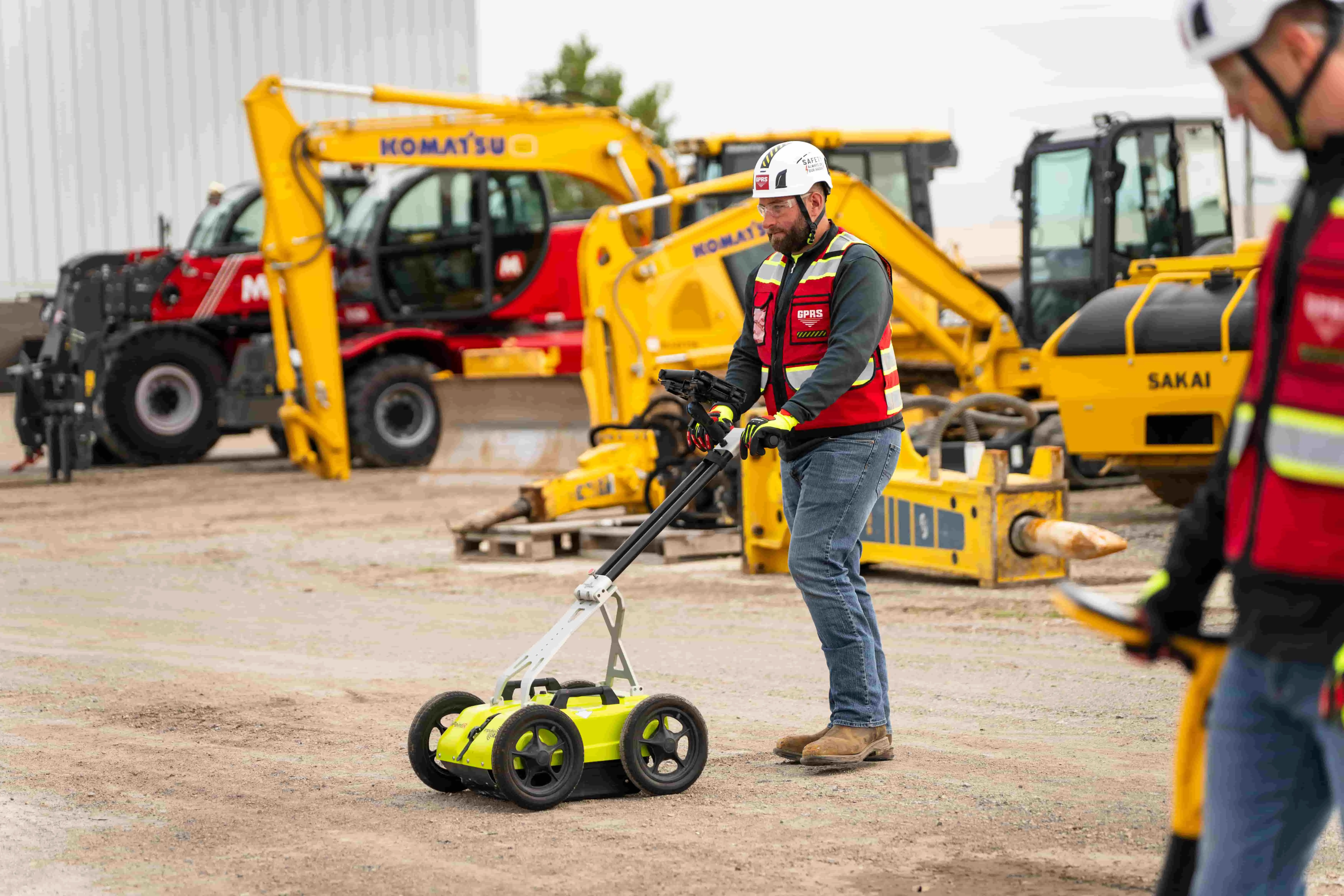
What Can GPR Locate?
GPR can detect a wide variety of subsurface elements, including:
- Utilities: Gas, electric, telecom, and water lines, regardless of whether they are made of metal, PVC, or plastic, or what they carry.
- Concrete Features: Rebar, post-tension cables, conduits, and potential voids.
- Underground Structures: Tunnels, foundations, mines, and potential sinkholes.
- Infrastructure: Septic systems, drain fields, storage tanks, and more.
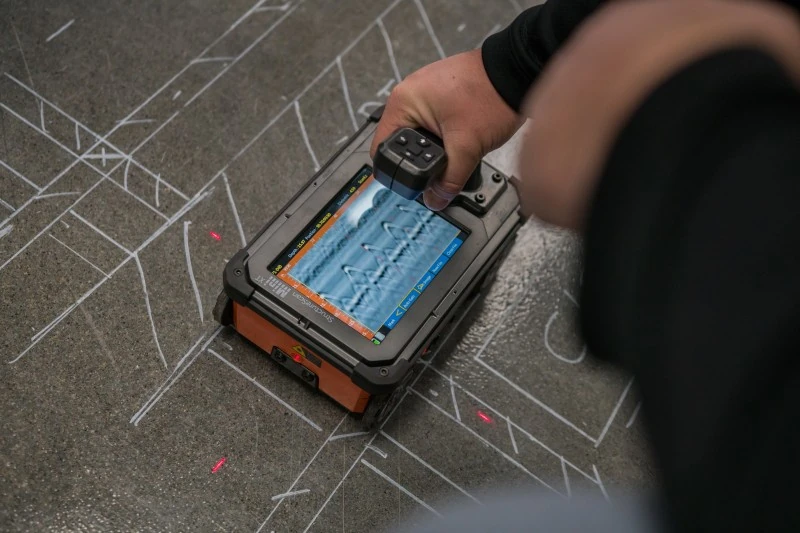
What are the Benefits of Using GPR Technology?
Using GPR technology for utility locating and concrete scanning before construction or excavation has several key benefits:
- Reliable underground data for better planning and design
- Reduced risk of damaging critical utilities
- Enhanced safety by identifying hidden hazards
- Improved job site coordination and efficiency
- Fewer delays from unexpected findings
- Minimized service disruptions
- Compliance with safety and regulatory standards
How Does GPR Work?
Ground penetrating radar works by sending radar signals into a surface, such as soil, concrete, or asphalt. When these signals encounter an object like a pipe, conduit, or rebar, they reflect back to the surface. A trained technician interprets these reflections to determine what’s below and where it’s located. GPR is a fast, safe, and highly accurate method for detecting subsurface features without the need for digging or drilling. Read Ground Penetrating Radar, Explained.

How Accurate is GPR?
GPR achieves a high level of accuracy, though results can vary depending on the type of material and the conditions of the ground.
At GPRS, we follow strict standards to ensure reliable results in any environment. When scanning concrete, our equipment typically achieves accuracy within ±¼ inch to the center of an object and ±½ inch to its depth. For utility locating, accuracy is generally within ±6 inches to the center and ±10% of the depth. Concrete antennas provide higher resolution for detailed imaging but have limited depth range, while utility antennas scan deeper with slightly lower resolution. Understanding the strengths and limitations of each system helps ensure the right tool is chosen for your project.
How Fast is GPR Data Collected?
GPR data collection is quick, often just a few minutes for small areas. For example, scanning a concrete slab or room may take 5–15 minutes. Larger areas like performing utility locating services for parking lots or construction sites may take a few hours, depending on size and complexity. Speed is influenced by several factors, including the surface type (soil, concrete, asphalt), the level of detail required, and any obstructions or access limitations.
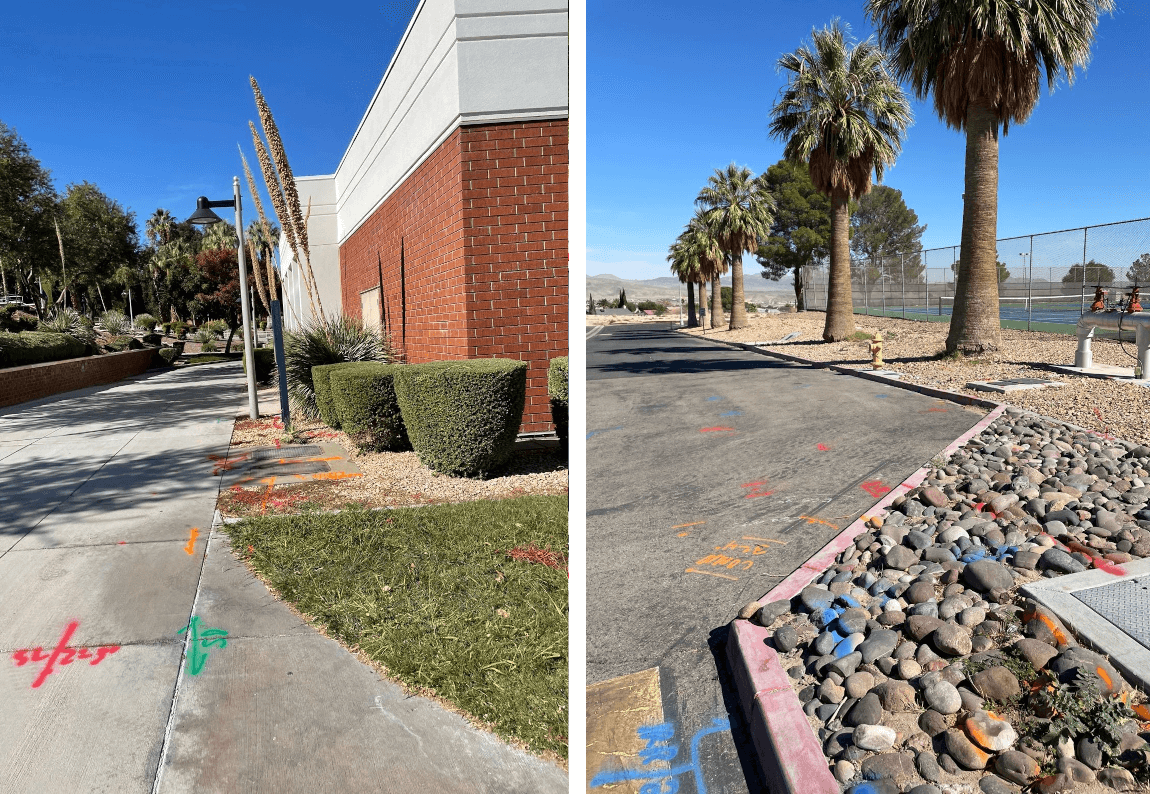
How Do Clients Receive GPR Data After it's Marked on the Ground?
Once GPR locations are marked on the surface, typically using color-coded paint, flags, or chalk for quick visual reference, the data is shared with clients through a combination of field markings, detailed reports, and digital deliverables. Technicians provide a summary of findings that include descriptions of detected features, estimated depths, and supporting site photos. What Do the Utility Marking Colors Mean?
GPR data can be delivered in various digital formats, including PDF utility maps for clear documentation, KMZ files with geolocated points marking specific subsurface features, and SHP files for detailed utility mapping compatible with GIS software.
To create a permanent digital record of surface markings for design and planning, 3D laser scanning or photogrammetry may be used. Data is often provided in BIM, CAD, or GIS formats such as RVT, DWG, DXF, DGN, and more.
GPRS also offers SiteMap®, a cloud-based platform where clients can easily view, download, and manage their subsurface data.

What Does it Cost to Rent a Ground Penetrating Radar Unit?
Based on actual KWIPPED Marketplace supplier quotes, ground penetrating radar rental costs are:
Daily: $284
Weekly: $1,138
Monthly: $3,406
While renting may seem cost-effective for short-term use, it comes with challenges. GPR rental requires significant training and experience to operate effectively. Short rental periods may not allow enough time to become proficient, and interpreting the data without expertise can lead to errors. Environmental factors like wet clay, salt, or rough terrain can also impact results. Over time, frequent GPR rentals can become more expensive than purchasing equipment outright.
When is it Better to Rent GPR Equipment?
Renting is best for short-term projects. It's not cost-effective to buy GPR equipment for just one use. It’s also useful if you already have trained staff and just need temporary access to the technology.
What Does it Cost to Purchase a Ground Penetrating Radar Unit?
Based on actual KWIPPED Marketplace supplier quotes, the cost to buy a ground penetrating radar unit is:
Average purchase price: $19,228
Purchasing GPR equipment offers long-term advantages. It lets you control usage fully. You can customize it for your project's needs. Plus, it removes those recurring rental fees. While the initial investment is higher, ownership becomes more cost-effective for regular users. It also ensures faster deployment and steady availability. Plus, it boosts project efficiency with reliable, high-quality subsurface imaging.
Who Should Consider Buying GPR Equipment?
Organizations that often perform subsurface investigations, such as construction firms, environmental consultants, or utility companies, can benefit from purchasing GPR equipment. It allows for flexible use, faster deployment, and long-term cost savings.
What is the Downside to Buying GPR Equipment?
Buying GPR equipment requires a big upfront cost. Also, owning it means handling tasks like maintenance, software updates, storage, and training staff. It’s not ideal for occasional use or teams without GPR expertise.
Why Hire a Ground Penetrating Radar (GPR) Service?
Hiring a GPR service is a smart choice. You get expert subsurface imaging without the hassle of owning equipment. It’s efficient and cost-effective. Professional GPR service providers offer expert knowledge and the right tools. Their experience helps interpret data better, leading to more accurate and useful results. This is ideal for critical projects, or when a fast turnaround is essential. Outsourcing takes away the hassle of maintaining equipment, updating software, and ensuring safety compliance. This makes it a cost-effective and low-risk choice.
What are the Benefits of Hiring a GPR Service?
- Expertise and Accuracy: Trained technicians assess the site, select the right equipment, and deliver precise data interpretation, reducing the risk of errors.
- Speed and Efficiency: GPR scans can be completed quickly, with real-time results and rapid post-processing, helping to keep projects on schedule.
- Access to Advanced Technology: Service providers often use the latest GPR systems, ensuring high-resolution imaging and reliable detection of subsurface features.
- Improved Safety: Accurate location of utilities, rebar, and other hidden hazards minimizes the risk of accidental strikes during excavation or drilling.
- Cost Savings: For short-term or infrequent needs, hiring a service is more economical than purchasing equipment, avoiding costs related to storage, maintenance, and training.

What Factors Should Influence My Decision to Rent, Buy, or Hire a GPR Service?
Think about your project's frequency, budget, timeline, staff skills, and how accurate you need it to be. If you need fast, reliable results without investing in training or equipment, hiring a GPR service is usually the best choice.
What are Some Examples of Projects Where Hiring a GPR Service is the Best Option?
On a construction site, before excavation begins, GPR is used to locate underground utilities like gas lines, water pipes, and electrical conduits. It is best to hire a GPR service for expert interpretation and safety compliance, especially for one-time or high-risk projects.
When renovating an office building, GPR is an essential tool for scanning concrete slabs to locate rebar, post-tension cables, and conduits before coring or drilling. For the most accurate results and safety assurance, it's best to hire a professional concrete scanning service.
During Phase I or II environmental investigations, GPR is used to detect buried tanks, drums, or other anomalies. It is best to hire a service for accurate data collection and reporting, especially when regulatory compliance is required.

Why Hire GPRS?
Every decision you make on a job site can cost time, money, and even lives. That’s why GPRS maintains a consistent 99.8%+ accuracy rate in GPR utility locating and concrete scanning & imaging. Because it’s our job to help you keep your jobs on time, on budget, and safe.
Our nationwide team of elite Project Managers aren’t just expert technicians – they are consultants who help you get what you need to do the job right, and safely. GPRS has completed over 500,000 utility locating and concrete scanning projects across the U.S.
Every GPRS Project Manager is trained in and follows our Subsurface Investigation Methodology (SIM), an industry-leading training program that ensures elite-level performance.
Our teams use multiple technologies to deliver the most accurate utility locating and mapping data available. Whenever possible, we include line depths in our locates and offer flexible data visualization options tailored to your needs.
All data is mapped directly on the site, plus can be mapped in CAD and 3D and uploaded into an interactive, facility management platform, SiteMap, providing accurate, real-world information collected directly from your jobsite.
Before any construction or excavation begins, knowing what lies beneath the surface is critical. GPRS helps you plan with confidence, avoid costly surprises, and keep your project on track.
If you’re looking for ground penetrating radar rental, ground penetrating radar rental near me, GPR rental, GPR rental near me, concrete scanner rental, rebar scanner rental, or concrete scanning service near me, perhaps hiring a GPR utility locating and concrete scanning & imaging service could be the best option for you. Reach out to GPRS for a free project quote today.
Cross Slopes Explained
Cross slopes are key for the safety, function, and durability of roads, sidewalks, and paved surfaces. They help manage water runoff, enhance safety, and ensure structural integrity.
Let’s dive into what cross slopes are, why they matter, how they're designed, and the implications of getting them wrong.
What Is a Cross Slope?
A cross slope refers to the transverse gradient of a surface – i.e. the angle or tilt from one side of a pavement or roadway to the other. It is measured perpendicular to the direction of travel and is typically expressed as a percentage or ratio. For example, a cross slope of 2% means the surface drops 2 units vertically for every 100 units horizontally.
Cross slopes facilitate drainage, allowing water to flow off the surface rather than pooling. This is important for roads, where standing water can lead to hydroplaning, damage the pavement, and increase maintenance costs.
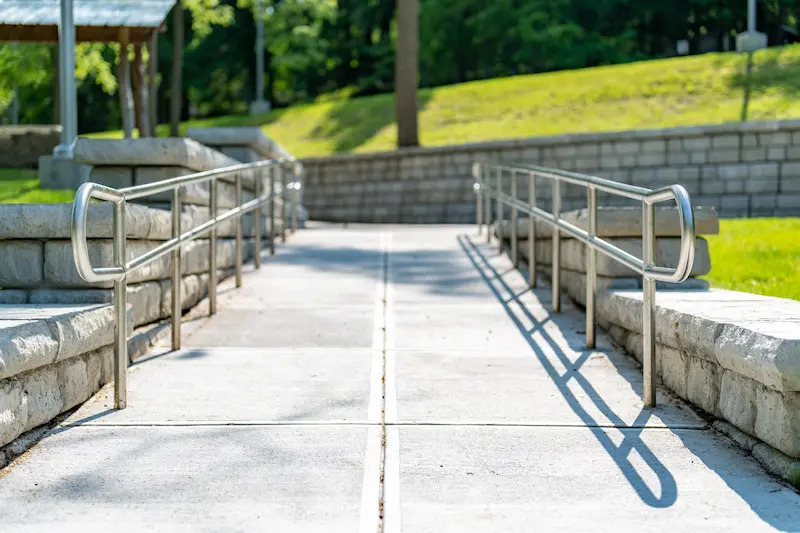
Why Cross Slopes Matter
The importance of cross slopes lies in their ability to manage surface water. Water is one of the most damaging elements to paved infrastructure. Without proper drainage, water can infiltrate pavement layers, weaken structural components, and accelerate wear and tear. Cross slopes help mitigate these risks by directing water toward gutters, drains, or adjacent terrain.
Beyond drainage, cross slopes also contribute to:
- Safety: Preventing water accumulation reduces the risk of skidding and hydroplaning for vehicles
- Accessibility: Well-designed cross slopes meet ADA (Americans with Disabilities Act) standards. This makes sidewalks and ramps easier for people with disabilities to navigate.
- Durability: Cross slopes reduce water infiltration, which helps pavements last longer.
Typical Applications of Cross Slopes
Cross slopes are used in a variety of contexts, each with specific design considerations:
Roadways
In road design, engineers apply cross slopes to the travel lanes and shoulders. The slope typically ranges from 1.5% to 2.5%, depending on the type of road and expected traffic volume. Highways often have steeper slopes to drain water quickly. In contrast, urban streets use gentler gradients. This helps balance drainage needs with pedestrian comfort.
Sidewalks and Pedestrian Paths
Sidewalks need careful cross slope design to ensure both drainage and accessibility. The ADA sets a maximum cross slope of 2% for pedestrian paths. This rule helps wheelchair users and others with mobility challenges.
Parking Lots
In parking areas, cross slopes direct water toward collection points without creating discomfort for pedestrians or vehicles. The slope must be subtle enough to avoid uneven parking surfaces but steep enough to prevent pooling.
Ramps and Driveways
Ramps, especially those used for accessibility, must balance slope requirements for drainage with strict ADA guidelines. Excessive cross slopes can make navigation difficult or unsafe.
Designing Cross Slopes: Key Considerations
Designing an effective cross slope involves a blend of engineering principles, regulatory compliance, and practical judgment. Several factors influence the ideal slope:
Surface Material
Different paving materials have distinct reactions to water and wear. Asphalt is more flexible, so it can handle slight changes in slope. In contrast, concrete needs precise grading.
Climate and Rainfall
Regions with heavy rainfall demand steeper cross slopes to ensure rapid drainage. Arid areas may prioritize comfort and accessibility over aggressive water management.
Traffic Type and Volume
High-speed roads use steeper slopes to lower the risk of hydroplaning. Low-speed urban streets have gentler gradients to improve pedestrian safety.
Regulatory Standards
Designers must follow local and national standards. These include guidelines from the Federal Highway Administration (FHWA) and the ADA. They outline acceptable slope ranges for various uses.
Measuring and Implementing Cross Slopes
Cross slopes are often measured using surveying tools or digital devices during design and construction. The slope is calculated using the formula:

During construction, achieving the correct slope requires precise grading and compaction. Contractors use laser levels, string lines, and automated machinery to ensure consistency across the surface.
Common Challenges and Mistakes
Despite its apparent simplicity, cross slope design can be fraught with challenges. Some common issues include:
Inadequate Slope
A slope that is too shallow may fail to effectively drain water, leading to puddling and long-term damage.
Excessive Slope
Overly steep slopes can create discomfort for drivers and pedestrians and may violate ADA standards.
Uneven Transitions
Bad transitions between slope areas, like from a sidewalk to a ramp, can cause tripping hazards and accessibility issues.
Settlement and Deformation
Pavement can settle or change shape over time due to traffic loads or unstable subgrades. These changes can alter the original slope and affect drainage.
Innovations and Technology in Cross Slope Design
Modern engineering offers various tools and technologies to enhance cross slope design and implementation:
- 3D Modeling and BIM (Building Information Modeling): Allows designers to visualize slope gradients in a digital environment prior to construction.
- Automated Grading Equipment: GPS-guided machinery ensures precise slope creation during paving.
- Smart Sensors: Embedded sensors can track slope integrity, alerting maintenance teams to changes or failures.
Cross Slopes and Sustainability
Sustainable infrastructure design increasingly considers the environmental impact of drainage systems.
Cross slopes play a role in green infrastructure by directing water toward permeable surfaces, bioswales, or rain gardens. This reduces runoff into storm drains and promotes groundwater recharge.
In urban planning, integrating cross slopes with low-impact development (LID) strategies helps cities manage stormwater more effectively while enhancing aesthetics and ecological value.
GPRS offers construction-grade reality capture services to help you inspect ramps and cross slopes. Our laser scanners collect the accurate, actionable data that our in-house Mapping & Modeling Team needs to create floor plans, virtual walkthroughs, BIM models, and whatever other deliverables you need to get the job done right.
What can we help you visualize?
Frequently Asked Questions
How Long Does 3D Laser Scanning Take?
With Project Managers all over the U.S., GPRS works quickly to provide detailed quotes for clients. For most jobs, large areas can be laser scanned in as little as a couple of hours or larger sites in as little as a few days. Entire facilities or campuses can take several weeks to capture the entire site, but most projects are measured in hours or days.
What if My Project is Limited in the Physical Setting?
Some projects require special applications due to limitations within the physical setting. Often times this is due to line-of-sight issues and when a scan must be done safely from the ground or with precautionary distance. Some of these applications would include above-ceiling MEP features in hospitals where it is necessary to maintain negative airflow or interstitial spaces that are congested with limited access. Since laser scanning is a non-contact measurement tool (i.e. we can scan from a safe distance or location) this becomes a powerful tool for solving these complex challenges.
GPRS Reality Capture Services Expedite Installation of LED Display at NBA Arena
GPRS’ reality capture services helped ensure the safety and success of the installation of a large LED display at a professional basketball arena.
Daktronics tasked GPRS Project Manager Brian Nicholson with scanning an area of the concourse at the Spectrum Center, the home of the NBA’s Charlotte Hornets. Daktronics is a nationwide manufacturer of video displays and digital billboards. They were preparing to install a 220’ x 8’ curved LED screen in the arena’s concourse.
“They have this huge steel structure mounted to the ceiling and the columns,” Nicholson explained. “To install the new video board, they need to confirm that the steel structure meets the correct dimensions and that the curvature to it is correct.”
Without precise measurements of the structure, the client risked damaging the LED display and delaying the project – which would have cost them time and money.
Nicholson deployed the Leica RTC360 laser scanner to capture 2-4 mm accurate data of the area.
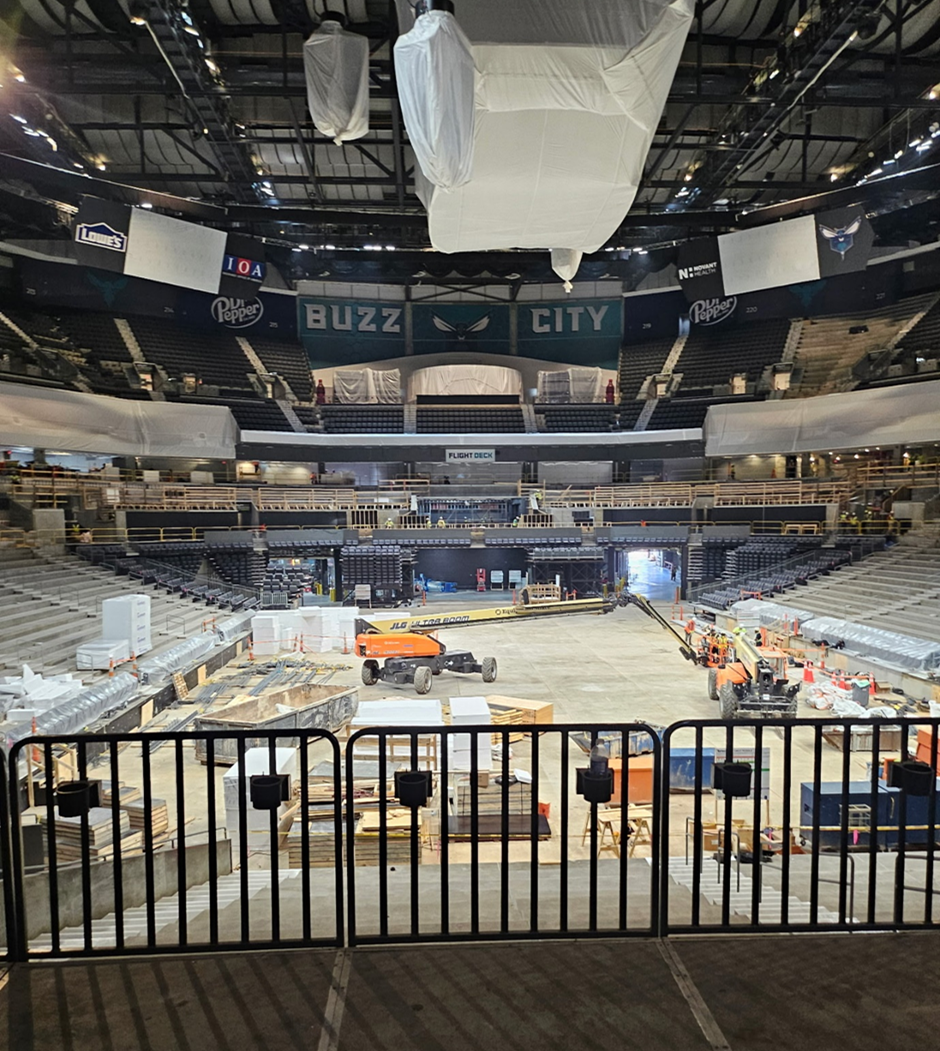
Along with the installation of the new LED display, the arena was undergoing many other offseason restoration projects. Scanning of the project area needed to happen around heavy foot traffic and could not disrupt these other operations.
“There was a lot of other stuff going on there and if there's vibrations, that'll throw off the laser scanner,” Nicholson explained. “So, anytime that I was setting up on a platform and they were also driving over a forklift or something like that, I'd have to rescan after they passed by, because their vibrations would mess up the scanning process.”
Nicholson’s training and experience helped him ensure that outside factors would not compromise any of the scans.
The scanning process took roughly an hour. Once Nicholson completed the scans, the point cloud data was sent off to GPRS’ in-house Mapping & Modeling Team.
Point cloud data refers to the data points collected by 3D laser scanners, like the Leica RTC360. Point clouds are also the foundation used by our Mapping & Modeling Team to create 2D CAD drawings and 3D BIM models.
%20(1).jpg)
With the point cloud data collected by Nicholson, the Mapping & Modeling Team created a 3D model of the steel structure.
Now that they have a highly accurate model of the area, Daktronics can assess with precision whether the structure meets the necessary requirements for the safe and efficient installation of the new LED display. They can also use that data for reference during any future renovations or O&M.
Even though Nicholson prefers football or hockey, he still felt excited about working at this arena for the day.
“I'm a huge football and hockey fan, but being in a sports arena is always cool,” Nicholson said. “I was right at the area where you look straight in and there's the court right there.”
From jumbotrons to skyscrapers, GPRS Visualizes the Built World® to help you Plan, Build, and Manage Better.
What can we help you visualize?
FREQUENTLY ASKED QUESTIONS
How do I know if 3D laser scanning is right for my project?
Almost any project that requires as-built information can benefit from a laser scanning survey. Talk with our experts and start your 3D laser scanning survey project today.
What deliverables can GPRS provide?
We can provide 3D modeling in many formats such as:
- Point Cloud Data (Raw Data)
- 2D CAD Drawings
- 3D Non-Intelligent Models
- 3D BIM Models
- JetStream Viewer
Customizable Deliverables Upon Request
- Aerial Photogrammetry
- Comparative Analysis
- Deformation Analysis
- Digital Drawings of GPR Markings
- Floor Flatness Analysis/Contour Mapping
- New Construction Accuracy Analysis/Comparative Analysis
- Point Cloud Modeling Training Webinars
- Reconciliation of Clients 2D Design Drawings
- Reconciliation of Clients 3D Design Model
- Structural Steel Shape Probability Analysis
- Template Modeling
- Volume Calculations
- Wall Plumb Analysis
GPRS Ensures Safe Installation of EV Chargers at Ohio Service Station
Accurate utility locating data helped ensure the safe and efficient installation of electric vehicle chargers at a service station in Ohio.
GPRS was contracted to locate and map utilities at the station in Cambridge, Ohio prior to the installation of EV chargers.
Project Manager Derrik Clark utilized both electromagnetic (EM) locating and ground penetrating radar (GPR) to locate and map the utilities.
“It's the exact same approach no matter what [the client’s attempting to do],” Clark said. “Because the goal is for them to not hit any existing utilities [when digging] for obvious safety reasons, and then obviously so you’re not interrupting operations or causing anybody to spend money fixing those things. So, for me, there’s never a different approach as to how I’m locating things, regardless of the job type. I find the underground utilities and mark them.”
EM locators detect electromagnetic signals radiating from metallic pipes and cables. These signals can be created by the locator’s transmitter applying current to the pipe, or from current flow in a live electrical cable. They can also result from a conductive pipe acting as an antenna and re-radiating signals from stray electrical fields (detected by the EM locator functioning in Power Mode) and communications transmissions (Radio Mode).
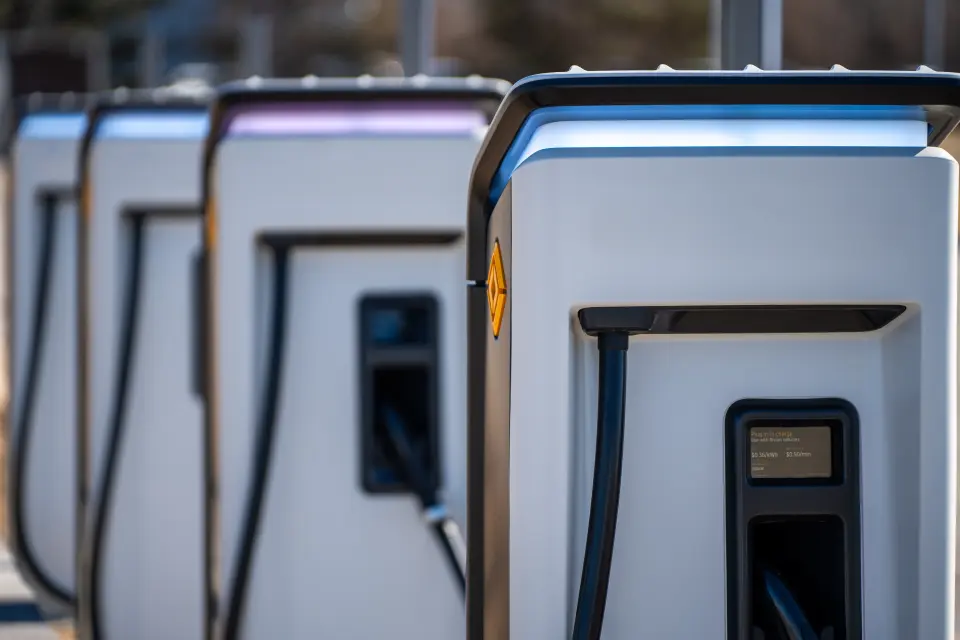
Signals are created by the current flowing from the transmitter which travels along the conductor (line/cable/pipe) and back to the transmitter. The current typically uses a ground to complete the current. A ground stake is used to complete the circuit through the ground.
GPR scanners send radio waves into the ground or a surface such as a concrete slab, then detect the interactions between those signals and any subsurface items such as buried utilities, embedded rebar or post tension cable, or underground storage tanks (USTs).
This data is displayed in a GPR readout as a series of hyperbolas, which vary in size and shape depending on what kind of material as detected. GPRS Project Managers are specially trained to interpret this data to tell you what was located, where it’s located, and its estimated depth underground or within the concrete slab.
Our Project Managers utilize both GPR and EM locating when conducting utility locates because they perfectly complement each other’s strengths and weaknesses.
When locating utilities around the service station in Ohio, Clark leaned primarily on EM locating. This was due to an abundance of aboveground contact points which he could use create a traceable signal, and the fact that the soil consistency and other environmental factors were interfering with his GPR scanner’s ability to penetrate the asphalt and soil.
“Max depth with GPR was very poor at this site,” Clark said. “It was like a foot-and-a-half, so that’s why I primarily used the EM locator. It’s always a combination of GPR and EM locating, but since GPR was limited so much I was more relying on the EM locator and hooking on to any surface features that were there.”
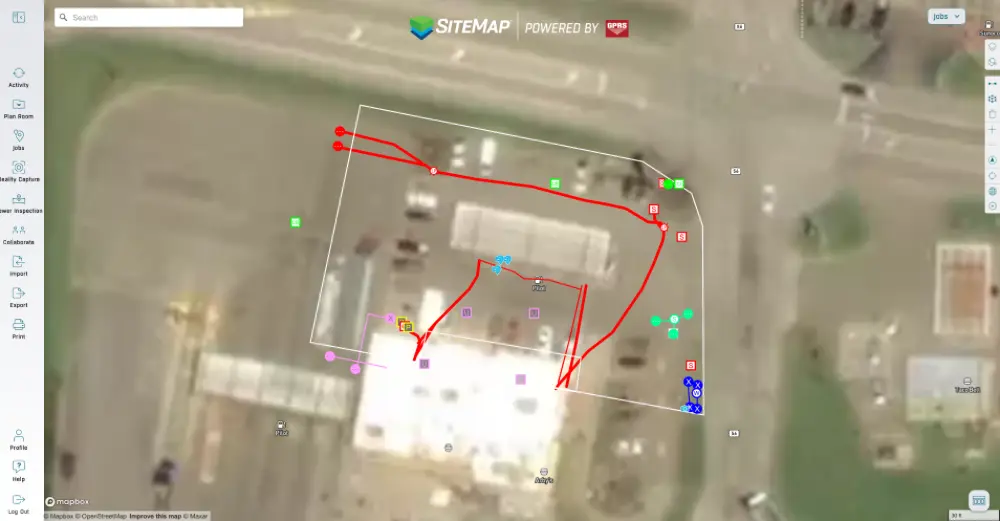
The accurate, actionable utility locating data Clark collected was uploaded into SiteMap® (patent pending), GPRS’ infrastructure mapping, and construction and facilities project management software application designed to help you plan, manage, and build better. Securely accessible 24/7 from any computer, tablet, or smartphone, SiteMap allowed the project team to work around a single source of truth that eliminated the costly and potentially dangerous mistakes so often caused by miscommunication and bad data.
The installer was able to complete their work without striking any buried utilities, ensuring the safety of everyone on-site and the success of their project. Services at the station were able to continue without the disruption that would have occurred due to destructive and expensive potholing to find the buried utilities.
From skyscrapers to sewer lines, GPRS Visualizes The Built World® to keep you on time, on budget, and safe.
What can we help you visualize?
Frequently Asked Questions
What do the utility marking colors mean?
The American Public Works Association (APWA) has established a universal color code to differentiate various utilities:
- Red – Electric power lines, cables, and lighting cables
- Orange – Communication, alarm, signal lines, and fiber optic cables
- Yellow – Gas, oil, steam, petroleum, and other flammable materials
- Green – Sewer and drain lines
- Blue – Potable (drinking) water
- Purple – Reclaimed water, irrigation, and slurry lines
- Pink – Temporary survey markings
- White – Proposed excavation area
What is RTK and why does it matter?
Real-Time Kinematic (RTK) positioning is a high-precision geo-positioning method that uses satellite correction data to achieve centimeter-level accuracy in the right conditions. In utility locating, RTK ensures that mapped utility data is geospatially accurate, enabling precise excavation and long-term asset management.
Concrete Finishes in Commercial Construction: Types, Processes, Curing, and Performance
Selecting the right concrete finish can impact safety, lifecycle performance, maintainability, and cost for any building, facility, or campus. For GCs, concrete subcontractors, and facilities managers, getting the means, methods, and timing right – especially finishing, jointing, and curing – determines whether a slab meets specifications like flatness/levelness, hardness, and appearance, while avoiding cracking, curl, dusting, and coating failures.
And understanding the various finish types, their maintenance, and repair needs allows facilities managers to effectively plan repairs, renovations, retooling, or any work that requires you to cut, core, or drill into your concrete.
You can use this quick-reference guide to help you determine the best finish for your job, plan for crew and equipment needs, set FF/FL expectations, schedule for saw cuts & cure times, validate slip resistance (DCOF) and moisture (ASTM F2170) requirements, and choose maintenance schedules that align with your facility’s use.
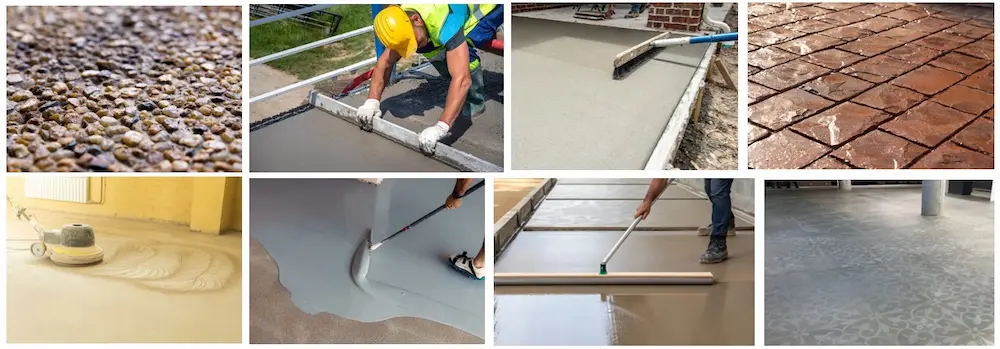
A. Cross Project Technical Fundamentals
1) Placing → Finishing Window (the “don’t miss it” timeline)
- It’s important to remember not to begin finishing while bleed water is present. The timing of finishing, jointing, and curing is critical; poor timing can cause cracking, scaling, impact the concrete’s wear resistance, cause dusting, and increase the risk of curling. When scheduling, you’ll want to plan manpower, tools, and breaks by both the size of the pour and the overall environmental conditions.
- Jointing: sawcut as early as the slab can support the saw without raveling. The typical guidance for jointing is within 4–12 hours, depending on temperature (hot sooner, cold later) and reach ≥ 1/4 slab thickness (≥ 1 in. minimum). Some specifications call 1/3 depth where fiber reinforced mixes are used. Joint layout and spacing should be established on your drawings. The specs are commonly 24-36 × slab thickness, but should always be driven by the engineer of record.
2) Curing (strength, abrasion resistance, color uniformity)
- Follow ACI 308R for optimal cure times. You’ll need to maintain moisture and temperature to ensure correct hydration. Seven days is a common minimum for many mixes. Although it may be longer for blended cements, pozzolans, or in colder weather. You may also use the manufacturer’s coverage rates and expected coating compatibility as part of your calculations. Not allowing adequate cure times can reduce surface strength and increases the risk for dusting and scaling.
- Moisture sensitive flooring/coatings: Your curing method must be compatible with subsequent finishes. For example, certain curing compounds may require removal prior to coating. It’s important to verify the specific curing and coating needs via submittals for each variety of concrete that may be used.
3) Acceptance Strength, Early Age Indicators
- Acceptance is 28 day unless otherwise specified (ACI 318). 7 day results are for monitoring only, not acceptance. Typical field heuristics see approximately 65-70% of 28 day strength by day 7, depending on mix and ambient temperature. You should always rely on project specifications for acceptance.
4) Floor Flatness & Levelness (F Numbers)
- ASTM E1155 lays out the measuring requirements (FF for flatness, FL for levelness) and includes statistical sampling for random traffic floors. If you’re working with fixed path VNA (very narrow aisle) aisles, you will need direct path profilometry, rather than an E1155 random sampling. Coordinate the Specified Overall Values (SOV) and Minimum Local Values (MLV) in your specifications. Remember, E1155 computes values, it does not define sectioning or pass/fail criteria.
- Design guides typically illustrate common FF/FL ranges by use. For example, office/retail, or defined traffic aisles, but you want to use the appropriate guide specific to your project.
5) Slip Resistance / ADA / DCOF
- The Americans with Disabilities Act (the ADA) requires construction to include accessible surfaces that are firm, stable, and slip resistant, although there is no single DCOF (Dynamic Coefficient of Friction) mandated. It is important to select textures and finishes that are appropriate to likely conditions and potential contaminants.
- Polished concrete tested by CPC/TCNA showed DCOF ≥ 0.42 across multiple gloss levels using ANSI A137.1 / A326.3 methods—document target DCOF by area and condition (dry/wet).
6) Moisture Testing Prior to Coatings/Resilients
- For in-situ RH (relative humidity) probes, refer to ASTM F2170, which calls for three holes for first 1,000 s.f. and 1 hole per additional 1,000 s.f.. Then test at 40% depth for one sided dry concrete, or 20% depth for two sided dry concrete, after 48 hours at normal service conditions. Record and report your readings, and compare them to coating manufacturer’s RH limits.
B. Finish By Finish Technical Detail
Consider utilizing the following “process blocks” when planning and executing your finishes. We’ve broken them out for you on each type of finish as follows:
Prep/Place → Finish Steps → Joints/Curing → QA/QC → Cure/Use timing → Durability & Maintenance → Typical Uses
1) Troweled Finish (Steel Trowel/Burnished)
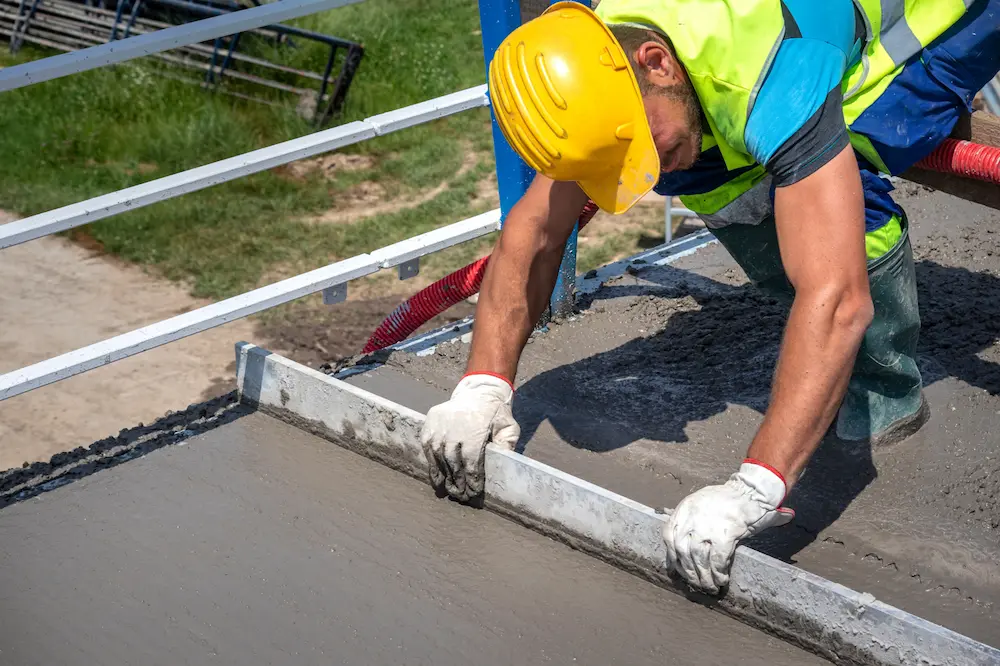
Process: Follow your strike off with a bull float. Allow any and all bleed water to evaporate fully. Densify the top pass with multiple steel trowel passes. Use power trowels for large bays. Uniform timing is vital to avoid dark/light burnish patching.
Joints/Curing: Layout joints per plans and perform early entry cuts when the raveling risk is low. Begin curing immediately: wet cure or compatible curing compound.
QA/QC: Monitor your finish window, avoid over troweling to reduce the chances for entrapped water and air that can lead to dusting, and check your FF/FL levels.
Cure/Use: Typically, your cure will be walkable on the next day, but will not sustain heavy rolling loads until after the full design strength and curing period have ended. Be sure to coordinate your cure times with any TI schedule. TI is an abbreviation for titanium dioxide – TiO2 – the substance often used as a photocatalyst in more sustainable concrete finishes and mixes.
Durability & Maintenance: You should achieve good abrasion resistance, if the concrete was cured and jointed correctly, with low wet traction. This means your facilities and operations managers should specify mats or surface treatments should this finish become wet.
Use Cases: Offices, retail, back-of-house dry areas. Be sure to set DCOF and safety expectations if this finish is exposed to wetness.
2) Float Finish (Mag/Wood Float)

Process: After your bull float, use a mag or wood float to open the paste and create a fine texture. This is often the intermediate step before steel troweling, or a final finish for traction.
Curing/QA: The same notes here as for the finish above. It’s important to watch your cure window, and check for texture uniformity across placements.
Performance: Float finishes generally provide higher traction than a plain steel troweled finish. Floats also retain modest amounts of soil over time, so they usually require a regular cleaning schedule to maintain their appearance and traction.
Use Cases: Exterior aprons, loading areas, or as a base for a broom finish
3) Broom Finish

Process: While the surface is still “plastic,” draw a broom consistently – either in one direction or in a cross broom pattern, as specified in your plans – for ridged texture. You can control your ridge depth with the stiffness of your broom bristles and how you time consecutive passes.
Joints/Curing: Broom finishes generally go best when you joint early, then cure to lock in the paste and minimize scaling.
Safety/DCOF: Broom finishes are known for their excellent wet traction, which is why they are common for ADA routes and ramps when detailed properly.
Use Cases: Sidewalks, ramps, exterior paths, the walking surfaces of parking decks
4) Exposed Aggregate

Process: Place your concrete, then seed or use integrally mixed decorative aggregate over it. Utilize surface retarders or a timed wash to provide uniform aggregate exposure. It’s important to protect this finish from early drying to lock the aggregate features in place.
Curing: To minimize aggregate feature loss and staining, sealants/sealers are often recommended.
Performance: Exposed aggregate finishes are generally high traction and durable in bad weather. However, they can present navigation challenges for wheeled carts and items with small casters.
Use Cases: Plazas, hospitality exteriors, pool decks
5) Stamped Concrete
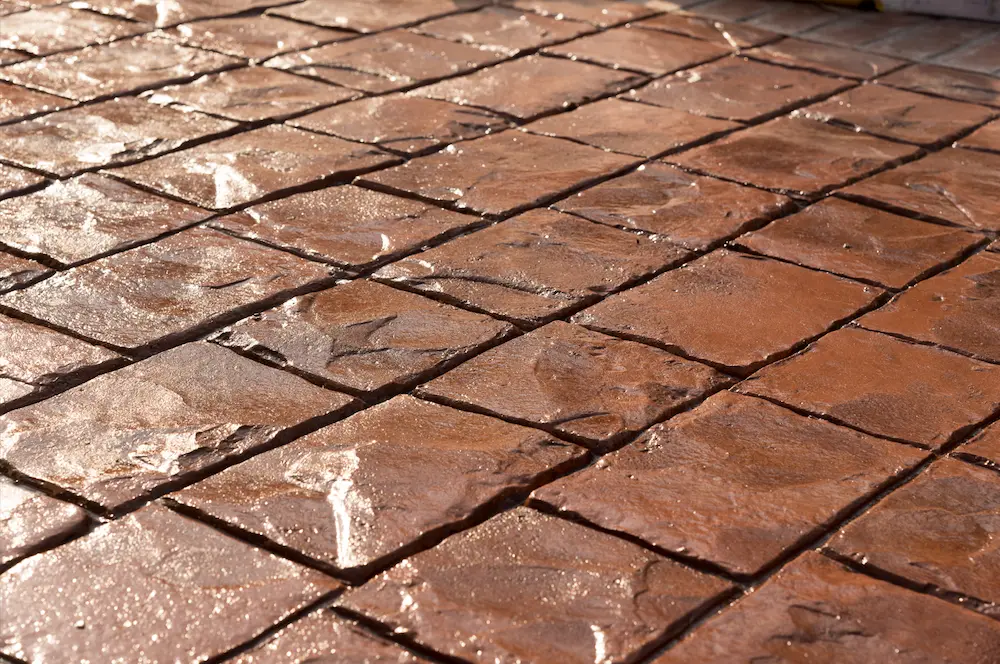
Process: Stamped concrete requires color hardeners and release agents that are applied via stamping mats during plastic stage, and a plan that details the joints to follow the stamped pattern’s logic.
Curing/Sealing: Whatever curing compound you use should be compatible with the ongoing need for periodic resealing to protect the color/pattern. When selecting additives, it is important to choose those with anti slip protections for wet zones.
Performance: While stamped concrete finishes are decorative, they still require joints and cracking control, as well as slip-resistance. That’s why it’s important to schedule regular reseal cycles that meet your traffic and UV conditions.
Use Cases: Retail streetscapes, restaurant patios, branded entries, mixed-use properties
6) Stenciled Concrete
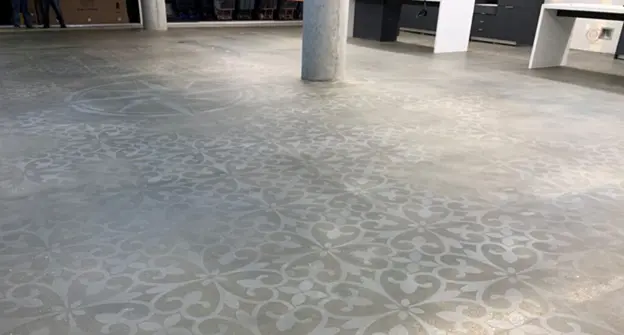
Process: The process and care schedule for stenciled concrete is similar to stamping, but generally stenciling is best used in areas without high foot traffic. Process-wise, once you’ve hit an acceptable level of cure, place and set your stencils, add your color, hardener, and/or texture. Then remove the stencils, allow the concrete to complete its cure, and seal accordingly.
Performance: Stenciling is a more cost effective method than stamping to add patterns in areas that have light to moderate foot traffic. However, it is not often used with a strong texture, and it does require monitoring for colorfastness, and a regular schedule for resealing to maintain the pattern.
7) Polished Concrete
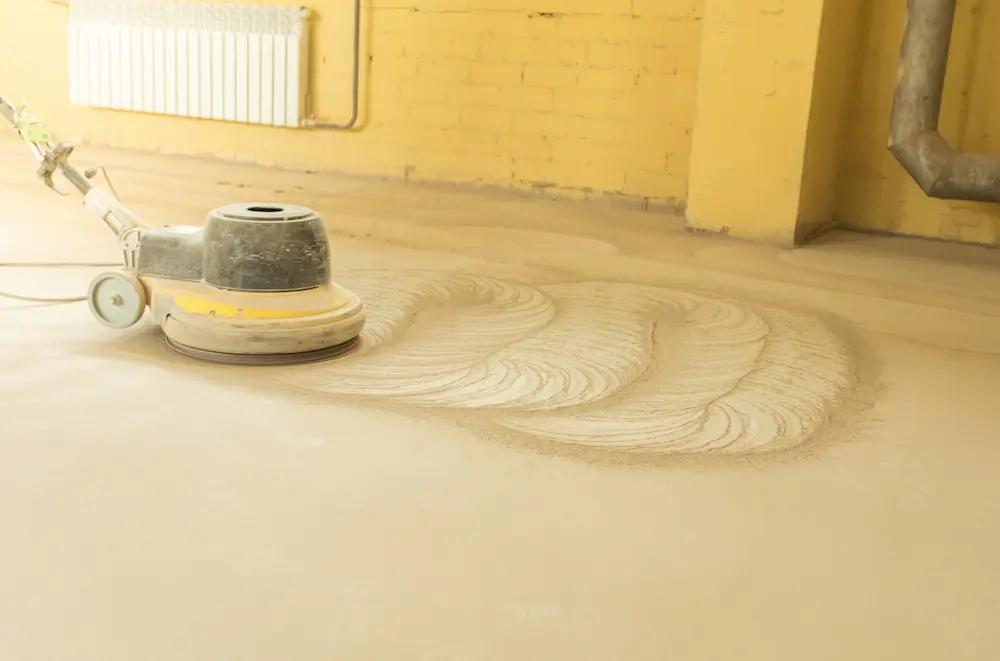
Process: This finish provides a high-gloss, slick look to your concrete. To achieve it requires 6-8 grinding and polishing steps at minimum. Grinding is most often an aggressive metal bond grind with a highly abrasive diamond-tipped head to smooth out rough spots and level the surface, followed by finer grinding in the transition phase to smooth the surface. A resin-bond grind following the initial grind will not usually do enough to fully polish the surface, so you may need to follow it with a ceramic or copper bond matrix polish, to tighten the pores in preparation for applying a densifier to fill in pores and creating a harder, wear-resistant finish. Refer to the specified CPC (Concrete Polishing Council/ASCC) class, aggregate exposure, and sheen when finishing and verify by DOI (Distinctness of Image), gloss, or haze metrics.
Slip Resistance: CPC and TCNA (Tile Council of North America) testing showed a DCOF ≥ 0.42 across finishes, which is in keeping with ANSI’s A326.3 requirements for interior, wet areas like bathrooms, kitchens, lobbies, and large retail stores like supermarkets. Due to its high gloss, it is crucial to document all target metrics and cleaning regimen schedules because gloss alone cannot predict slip; contaminants and maintenance have a huge impact on it.
Energy/ESG: The highly reflective surface of polished concrete can reduce lighting energy needs, and concrete’s thermal mass can help moderate indoor temperatures, which support energy performance and LEED strategies, when included as part of a whole building design.
Curing/Timing: Due to the aggressive nature of the initial grind stages, you need to allow for 28 days of cure, on average before grinding, depending on the project needs. If you need to polish early to keep to schedule, a best practice is to utilize contractor submittals to document risks and mitigations.
Maintenance: After its initial labor-intensive finish, polished concrete can be one of the easiest to maintain. Often a dust mop and periodic autoscrubbing can handle cleaning, as long as you avoid film forming sealers that can mask or impact your refinement metrics. You will also need to schedule periodic re polishes for higher traffic lanes.
Use Cases: Warehouses, big box retailers, showrooms, offices, schools
8) Epoxy Coatings: 100% Solids, Waterborne Systems, High Chemical/Novolac
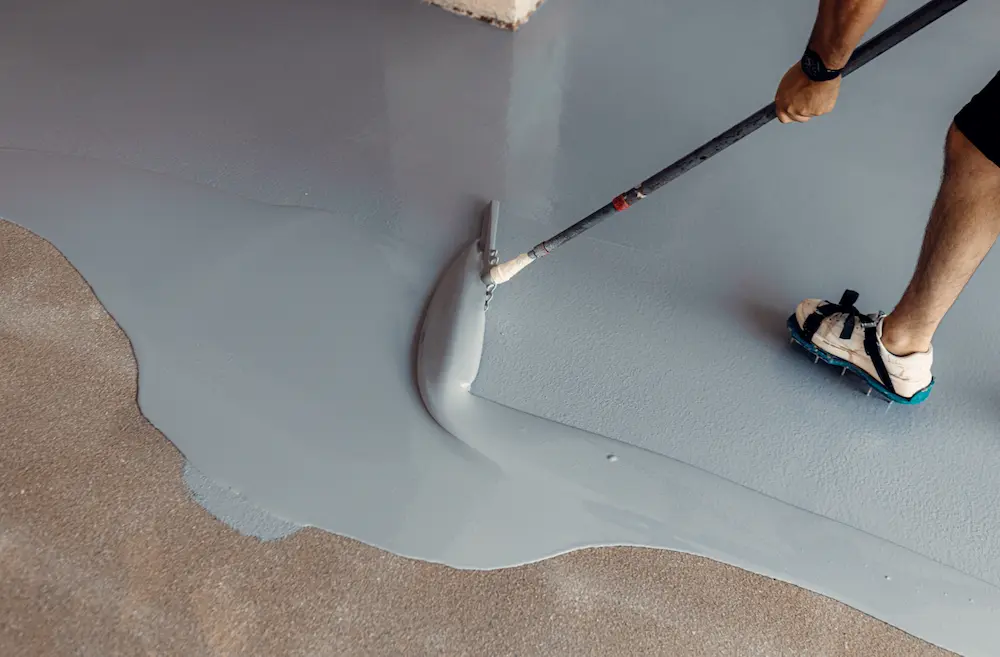
Epoxy finishes and coatings vary greatly depending on the use case. Durability, resistance to chemicals, and the environment during application can all play a role. Heavy duty protection often requires 100% solid epoxy, less high-traffic/high-stress use cases may be able to make use of waterborne systems, while areas that will endure extreme chemical exposure, like labs, chemical processing facilities, or battery recharging rooms will likely need Novolac.
Substrate Preparation: Decide on the necessary CSP (Concrete Surface Profile) and proceed with grinding or shot blasting to achieve the required roughness level. Verify the relative humidity (RH) level needs via both ASTM F2170 and the manufacturer requirements before treating, and remove any potentially incompatible curing compounds.
Build & Film Thickness: Most common epoxy systems provide a thin-mil or thin-film coating of 10–30 mils. Broadcast/quartz (distributed aggregate) and mortar systems (filler sand or aggregate) will be thicker by necessity. Your build and thickness requirements will depend on traffic needs, the level of chemicals to which the finish may be exposed, and thermal cycling.
Chemistry: Bis A, Bis F, and Novolac systems vary in their levels of chemical and temperature resistance. Determining your choice of hardener: polyamide, amine, cycloaliphatic, or phenalkamine, can tune your cure speed, blush, and chemical resistance.
Cure & Recoat Windows: Many 100% solids systems are tack-free at around 3-8 hours at a steady temperature of 70°F. In general, you can recoat anywhere from 3 hours to 14 days after your initial coat. Light traffic areas can be ready in as little as 24 hours, while areas requiring full chemical resistance will take 3-7 days, depending on the ambient temperature during cure. It is important to verify these times via your product’s data sheet.
Industrial Duty: Epoxy finishes are desirable in areas that need high chemical and abrasion resistance. Novolac is the most-often suggested epoxy for areas where strong acids and/or solvents are used, in secondary containment areas and process trenches, for example.
Use Cases: Manufacturing, pharma/healthcare, food & beverage manufacture, commercial kitchens, laboratories
C. Curing, Moisture, and Timing: What You Need to Schedule
Recommended Curing & Use Milestones in Typical Ranges.
(Always verify your specifications and product data.)
- Concrete curing: It is important to maintain moisture for your wet cure or curing compound per ACI 308R. Many mixes say they need 7 days. The cure period could be more for a moist cure, so check specifications because early drying elevates your risk for dusting and scaling.
- Sawcut: You can often cut somewhere between 4 and 12 hours after placement depending on conditions with a depth at 1/4 slab or more (≥ 1 in. minimum). You’ll want to coordinate any early entry saw cuts to minimize raveling.
- Moisture testing: Conduct ASTM F2170 at your regular service conditions. While you can insert a probe as early as 24 hours post-finish, the industry standard is to allow 48 hours of cure/conditioning period before testing. The necessary probe hole depth is 40% for one-sided, or 20% for two-sided slabs, with 3 holes per the first 1,000 s.f. and1 hole per each 1,000 s.f. thereafter. Be sure to compare your desired results to the manufacturer’s RH limits before installing epoxies.
- Epoxy coating service: Your finish can usually sustain light foot traffic in under 24 hours at an ambient conditioning temperature of 70°F. Surfaces requiring heavy or chemical exposure can be used once the full cure is reached, usually in 3-7 days. When recoating, your window could be a few hours to several days, depending on the finishes’ chemistry and the ambient temperature.
- Polish start: Industry standards prefer at least a 28-day cure period before a full grind or polish, unless early polish plan is approved.
D. Durability, Performance & Safety: What the Data Says
- Your finish choice impacts abrasion resistance and maintenance schedules: Inadequate curing/finishing can lead to dusting and early wear. Allowing enough time for proper curing elevates surface hardness and creates a longer-lasting finish.
- Polished concrete can reduce energy use via reflectivity and has been shown to moderate HVAC loads via thermal mass. However, these benefits are only when your concrete finishes are integrated with the lighting and HVAC designs and maintenance schedules.
- Slip resistance is context sensitive and can depend on a wide number of variables like contaminants, footwear, slope, and maintenance, among others. The ADA stops short of prescribing a single COF, so it’s a good idea to document surface conditions and cleaning schedules in O&M manuals.
- CPC/TCNA DCOF testing found polished concrete sections exceeded 0.42 even at high gloss, making them safe for high-traffic, wet areas. However, gloss ≠ safety. Soiling, cleaning routines, and spill management can all impact slip.
- Epoxy systems can achieve high chemical and abrasion resistance. Novolac resins can extend acid resistance, but you must confirm compatibility and the specific recoat and cure windows to avoid amine blush or intercoat adhesion issues.
E. Market & Usage Snapshot (context for owner conversations)
- The decorative concrete market, which includes polished, stamped and overlay finishes, is estimated at just under $19.5B in 2025, with an approximate 5-6% CAGR future-cast into 2030–2037 across analyses. These numbers reflect continuing and sustained demand in nonresidential and commercial upgrades and low maintenance finish needs.
F. Submittal Language & QA/QC Checklists
Here are some quick submittal language specifications and QA/QC checklists that you might be able to make use of for your concrete finishing work.
1) General Slab & Finish Submittals
- Mix design with SCMs, water cement ratio, admixtures; target strengths and shrinkage data. (Acceptance at 28 days per ACI 318 unless noted.)
- Finishing plan: manpower, equipment (screeds, pans, power trowels), placement map, FF/FL targets and test plan per ASTM E1155 (SOV & MLV defined in spec).
- Joint layout (spacing, depth, timing, filler type; early entry saw plan)
- Curing plan per ACI 308R (method, duration, compatibility with coatings)
- Moisture testing plan: ASTM F2170 method, hole depths/locations, service conditions confirmation, manufacturer RH thresholds
2) Finish Specific QA
- Polished Concrete: Specify CPC Aggregate Class (A–D) and Appearance/Gloss Level (1–4); require DOI/gloss/haze verification before any topical guards. Include DCOF target by area/use
- Epoxy Coatings: Substrate CSP, RH % (F2170), primer/system thickness, recoat window, cure schedule, chemical resistance tables (if labs/process)
- Exterior textured finishes (broom/exposed/stamped): State slip resistance expectations and sealer maintenance intervals
G. Quick Reference Tables
Table 1 – Processes, Timing, and Curing (selected highlights)
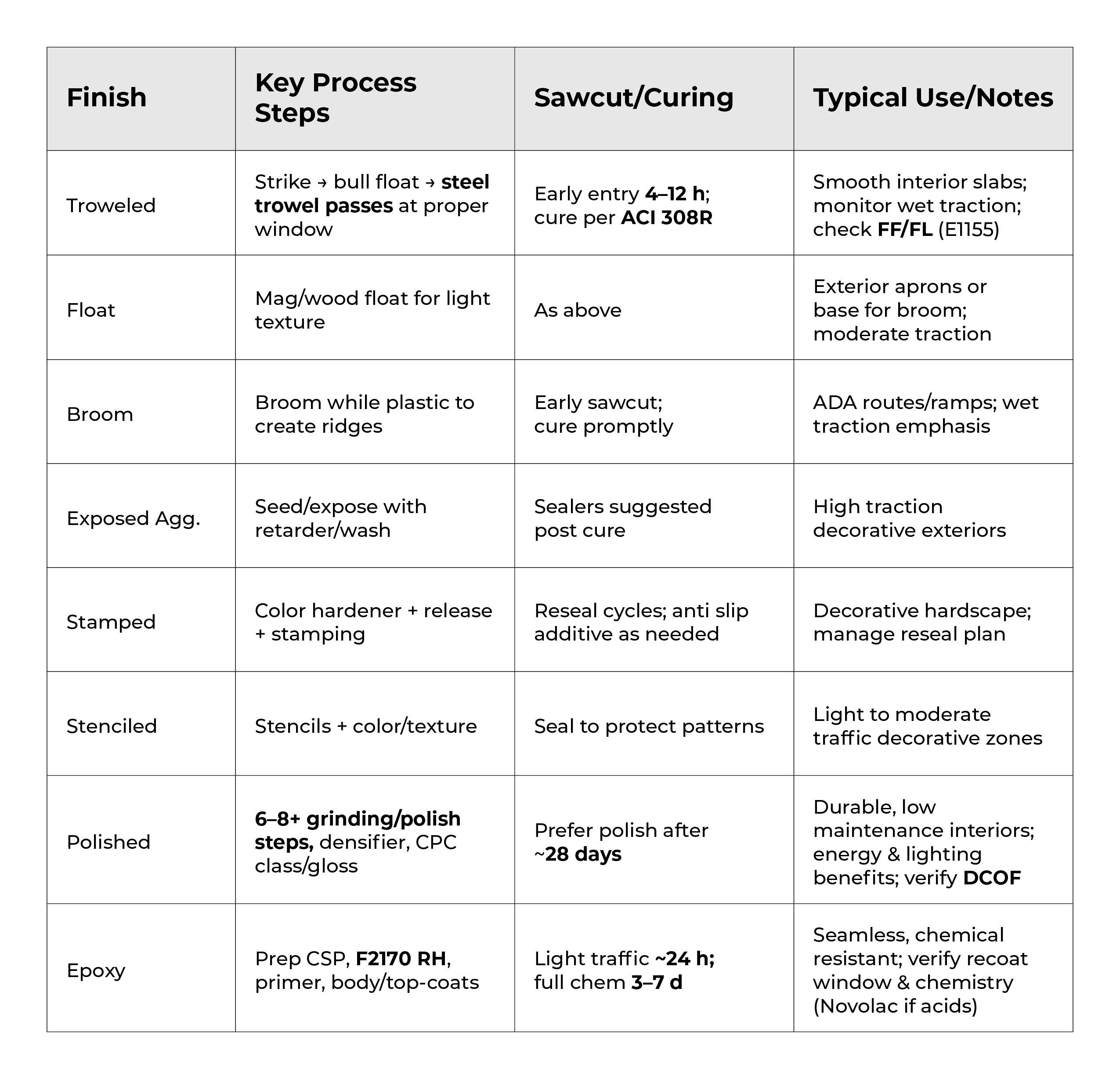
Table 2 – Standards & Tests to Reference
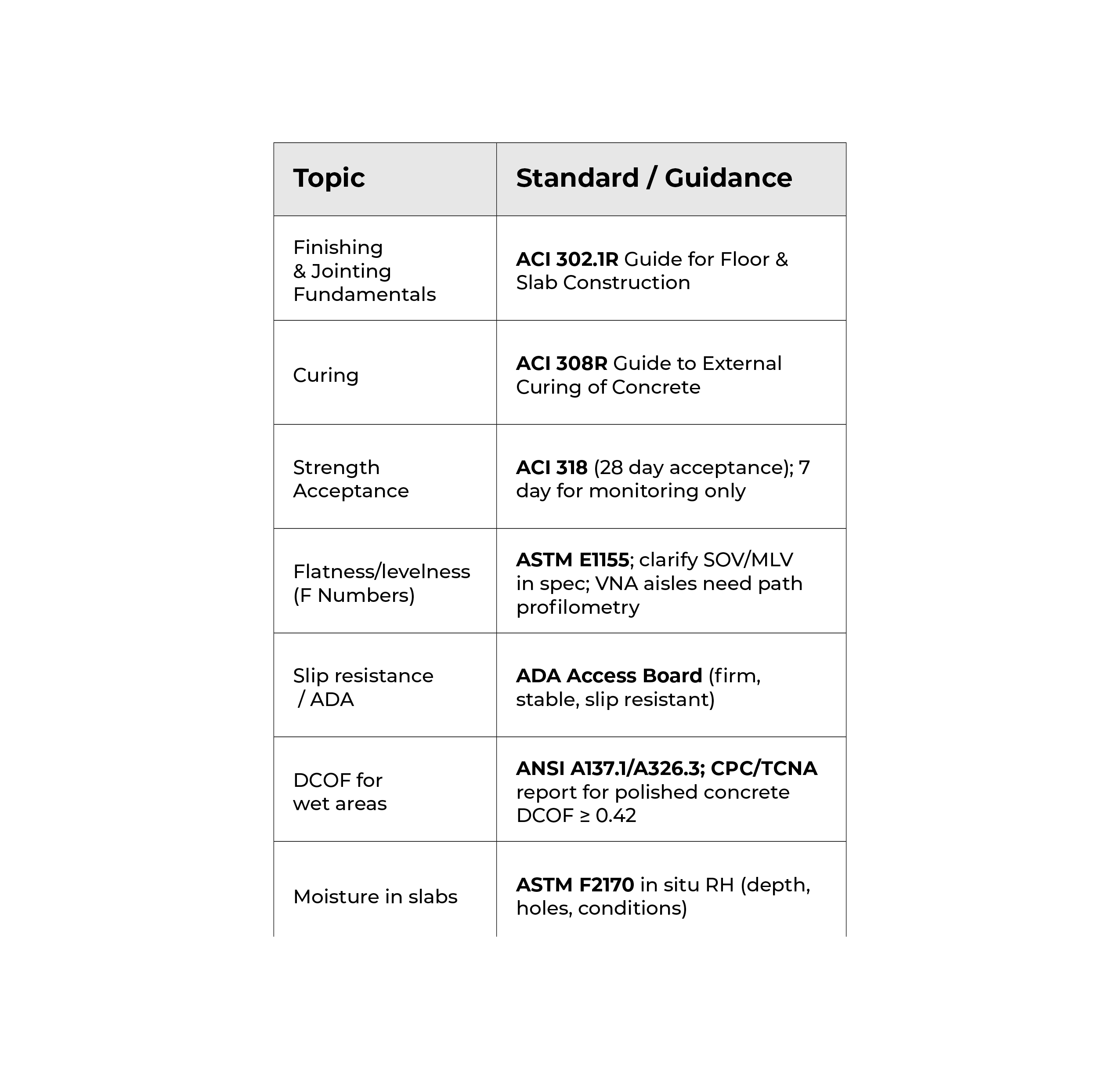
H. Decision Matrix: Matching Finish to Facility Demands
- Heavy forklift traffic / low maintenance → Polished concrete (spec CPC class/level; protect from oils with penetrants as needed; document cleaning program) and/or epoxy mortar/quartz in impact/chemical zones
- Food, healthcare, labs → Epoxy/Novolac systems with coves, slope-to-drain, and documented RH compliance (F2170)
- Exterior pedestrian safety → Broom or exposed aggregate (ADA emphasis) with UV-stable sealer plan
- Branding/streetscape → Stamped/stenciled, with reseal budget and anti-slip additives where wet
I. Common Pitfalls & How to Avoid Them
1. Finishing too early (over bleed water) → weak, dusty surface. Train crews to wait for the right window; mockups help
2. Late saw cuts → random cracking. Staff early-entry saw crew or adjust pour sizes/logistics
3. Incompatible curing when coatings planned → remove film-forming compounds or select compatible systems; coordinate early with coating sub
4. Skipping RH testing → coating delamination/OSD. Always test per ASTM F2170 and document
5. Mis-specifying FF/FL → claims and grinding. Write SOV/MLV and paths (for VNA), not just “per E1155”
6. Assuming gloss = safe → specify DCOF targets, cleaning, and mats in wet zones
7. Conduct comprehensive concrete scanning & imaging before cutting, coring or drilling into finished and cured concrete slabs. Finishes can be repaired in a variety of ways once you've pierced the surface, but your repair costs will skyrocket if your saw cut or anchor core strikes a post tension cable, conduit, or concrete reinforcement. In the case of outdoor concrete finishes and slabs, you may also strike underground utilities that could include gas lines, water mains, telecommunication lines, electrical transmission lines, and more, which could further hinder work progress and lead to cost overruns. Hiring a private concrete scanning and utility locating company like GPRS to visualize what’s inside and under your finished concrete can save labor hours, dollars, and can help keep your contractors, subs, and team members safe.
GPRS Visualizes The Built World® for customers throughout the U.S. What can we help you visualize?
What is the Future of 3D Laser Scanning?
The way we design, build, and manage spaces is changing fast. Technologies like 3D laser scanning, digital twins, and virtual tours are no longer just buzzwords. They’re critical tools for the project lifecycle. These solutions help capture real-world conditions with precision, reduce risk, and improve decision-making.
As Matt Mikolajczyk, GPRS Director of Reality Capture Services, explains, “Laser scanning should go beyond line of sight by adding context, like rebar depth, concrete thickness, and conduit placement under the slab, the thickness of walls, adding an extra layer of attribute data.”
This means capturing details from both above and below-ground, which helps create a complete picture for every stage of a project. The future of reality capture goes beyond what you can see.
How Does 3D Laser Scanning Work?
A 3D laser scanner is a powerful tool. It measures and maps spaces with construction-grade accuracy. The laser pulses off surfaces and return to the scanner’s sensor, a process known as Light Detection and Ranging (LiDAR). The scanner measures the time between each outgoing and incoming pulse to calculate the exact distance to the object. Each pulse produces a data point with a known X, Y, and Z coordinate.
To capture a complete view of a site, the scanner records data from different viewpoints. The scanner collects millions of individual points, which form a point cloud to create a precise 3D as-built data set of the site.
LiDAR-based scanners get speeds of up to two million points per second and maintain accuracy within 2-4 millimeters. This level of performance allows the Project Manager to document complex environments quickly.
What is the Current Market Landscape?
Future Market Insights, Inc. states, “From 2020 to 2024, the 3D scanning market grew from USD 3.3 billion to USD 5.1 billion, driven by hardware-centric adoption.” During this time, equipment manufacturers drove about 70% of revenue, including Hexagon AB, FARO, and Creaform.
Accuracy, speed, and cost-effectiveness were competitive attributes. Demand for 3D laser scanning will continue to increase this year and will expand to $16.66 billion by 2030. Laser scanning technology has made big strides, enhancing resolution and real-time processing power.
Here is how the architectural, engineering, and construction industries leverage 3D laser scanning:
- Architects utilize 3D laser scanning services to save valuable time and money and make informed decisions. An inaccurate set of as-builts leads to major cost overruns and delays. 3D laser scanning streamlines their workflows. This helps them skip time-consuming manual measurements and focus on their designs.
- Engineers need reliable existing conditions documentation to design upgrades or modifications with confidence. Inaccurate as-built documentation introduces errors that disrupt engineering workflows and cause costly delays. Engineers use 3D laser scanning its fast and precise measurements.
- Builders and general contractors need accurate as-built documentation because it helps them meet design specs, fix on-site problems, and keep projects on track. Accurate as-built drawings and BIM models are then created from 3D point clouds. These deliverables help with renovation planning and construction sequencing. They support important project decisions.
The AEC industries use 3D laser scanning the most. Yet, many other industries also use this technology. The entertainment industry uses scan data to create lifelike virtual worlds. Police departments use it to recreate crime scenes and improve investigations. Scientists use scan data to better comprehend the world and track environmental changes. Archaeologists use it to analyze and learn about artifacts. It reveals details that older tools couldn’t show.
How is 3D Laser Scanning Evolving?
History of 3D Laser Scanning
Before the introduction of 3D laser scanning, building industry professionals relied on manual methods to create building drawings. Surveyors and draftsmen used tape measures and levels to measure sites by hand. They sketched layouts in field notebooks. Then, they used graph paper and drafting tools to produce scaled drawings.
Blueprint machines made the final versions. The blueprints were kept in physical archives and shared with architects, engineers, and contractors. This process often caused errors, especially in hard-to-reach areas. It also took a lot of time and effort to finish.
RELATED ARTICLE: Read more about The History of 3D Laser Scanning
The Use of Simultaneous Localization and Mapping (SLAM) Technology
3D laser scanning is changing fast. One big change is the use of Simultaneous Localization and Mapping (SLAM) technology.
According to FARO, "It is the process of mapping an area while keeping track of the location of the device within that area. This is what makes mobile mapping possible, allowing the digitization of large areas in much shorter spaces of time."
This dual capability is very helpful in changing situations or places without GPS. Examples of these spaces and projects include underground tunnels, crowded cities, or disaster areas.
.webp)
GPS signals can’t reach underground mines. So, SLAM-equipped robots navigate tunnels on their own, and also create high-resolution maps.
In construction, handheld SLAM devices collect spatial data in hard-to-access areas without compromising data quality. SLAM plays a key role in today's reality capture workflows because it is crucial for working in complex areas without GPS.
LiDAR in Combination with SLAM Technology
Using terrestrial laser scanning (TLS) with SLAM-based mobile mapping improves accuracy and eliminates drift. TLS sets fixed control points that lock the scan data in place. SLAM scanners then cover areas that are hard to reach or lack GPS signals. Together, they create a complete and accurate map of the site. SLAM uses control points and loop closures to correct drift and reach high-precision results.
What is Above and Below-Ground 3D Capture?
As scanning technologies advance, so does the expectation for complete site visualization. Today's reality capture deliverables reveal what’s hidden beneath the surface. By combining 3D laser scanning with subsurface locating technologies, project teams can gain a holistic view of both structural and underground conditions. This dual-layered approach reduces risk, improves planning accuracy, and supports informed decision-making throughout the project lifecycle.
.jpg)
GPRS provides a variety of services to give you complete site and facility visualization, both above and below-ground.
We are a national service provider for 3D laser scanning, utility locating, concrete scanning, video pipe inspection, and leak detection. The combination of these services can provide your company with accurate data of existing as-built conditions and subsurface information.
You can receive clear and understandable findings of structural, MEP, and field markings in custom deliverables such as point clouds, 2D as-builts, and 3D models. Accurate data allows our clients to expedite design planning, extract 3D coordinates and measure distances, along with the ability to mark up and share this across project teams. Receiving critical site information can reduce your project risks and expand project efficiency.
What is the Role of AI and Machine Learning Reality Capture?
AI is growing in many industries. It improves 3D laser scanning systems' capabilities. These technologies support greater accuracy, faster decision-making, and streamlined workflows.
Artificial Intelligence
According to AVEVA, artificial intelligence is beginning to play an important role in optimizing point cloud processing. Point cloud datasets are very large, making manual processing time intensive. Point cloud processing involves several technical steps:
- Segmentation
- Object Detection
- Classification
- Feature Extraction
- Error Filtering
AI is starting to make this process easier by automating some of these steps, which can save time and provide a scalable solution. Some experts believe AI could enhance laser scanning even further as the technology improves.
AI is starting to play a bigger role in many industries. It can help with simple tasks, like sorting parts, and more complex ones, like identifying machines in a factory. Some experts say this can automate work and help answer questions like “How many machines do we have?” or “How can we improve this process?” These tools are growing quickly because of cloud computing and deep learning.
However, others are more cautious. If something goes wrong, it’s hard to review the AI’s work. Without a trained Project Manager reviewing the scan data, mistakes could go unnoticed. AI is still unproven in some areas, and removing the human factor can a risk factor. Project Managers still need to understand how the equipment works and what the client needs. Relying on AI alone could lead to errors that are hard to explain to the client.
Some software has AI features like recognition tools and automatic line extraction. But these tools are not perfect yet. Industry experts like Michael Harvey, Reality Capture Product Manager at Leica Geosystems, believe AI will continue to evolve and impact workflows.
“AI is going to allow sensors to think a lot faster and provide answers to complex problems quicker. AI is not just the point cloud, but it is going to be applied to imagery,” said Harvey on the Reality Capture Network Podcast.
He also noted that this means we’ll need tools to clean up faces and license plates in images.
Machine Learning
Recent advances in machine learning show strong potential for automating the processing of point clouds to create accurate as-built models. These models are key for tasks in construction and infrastructure. It will help with progress tracking and quality checks.
.webp)
Computer vision is a part of artificial intelligence (AI) that helps computers “see” and understand pictures, videos, and other visual information. This technology works with machine learning. It helps systems spot patterns and features in data. It has already proven in areas like image recognition and voice processing. But using it for point clouds in construction is much more complex.
Point clouds are irregular, unordered, and unstructured, which makes it tough for algorithms to learn. On top of that, construction sites add a lot of noise, reducing accuracy and reliability. Even so, new machine learning tools are improving.
Visualizing the Built World®: Above and Below-Ground
The future of 3D laser scanning is clear: smarter, faster, and more connected. Combined with advanced LiDAR, SLAM technology, ground-penetrating radar (GPR), electromagnetic (EM) locating, and more, these tools deliver context-rich models that show what’s visible above ground and what’s hidden below.
.webp)
.webp)
Every project is unique, so we select the right tools and partner with you every step of the way. This isn’t just innovation, it’s the new standard to keep your projects running on time, on budget, and safe.
GPRS 3D Reality Capture Services
GPRS is a leading 3D laser scanning company in the United States, helping clients to successfully complete their most complex architecture, engineering, and construction projects. We've been providing reality capture services and excellent customer service for over two decades.
GPRS’ elite team of Project Managers efficiently 3D laser scans the exterior and interior of each site with professional-grade laser scanners, capturing the exact layout, dimensions, and locations of your specific project requirements, such as architectural, structural, and MEP features, walls, windows, doors, stairs, roof, railings, exposed columns, beams, equipment, piping, ducts, and more.
Our Mapping & Modeling Team registers and processes the point cloud, removing noise and setting the coordinate system to provide the most precise measurements. Data is then compiled into custom 2D CAD drawings and 3D BIM models and delivered via SiteMap®. SiteMap is GPRS’ secure GIS platform that delivers point cloud data, 2D CAD drawings, and 3D BIM models, giving clients 24/7 access to verified as-built documentation to help start accurate and stay accurate.
What can we help you visualize?
FREQUENTLY ASKED QUESTIONS
How will 3D laser scanning evolve beyond what we see today?
Point clouds, which are currently massive collections of X, Y, and Z coordinates, will become smart datasets that AI can interpret automatically. Future workflows will leverage AI to classify doors, windows, and exact machines in manufacturing. Cloud computing and deep learning make these capabilities possible, and they’re improving every day.
Why is 3D laser scanning important in modern construction?
It delivers precise, real-world data that supports design, renovation, and facility management, minimizing errors, saving time, and enhancing collaboration across trades through tools like Building Information Modeling (BIM).
What are the benefits of 3D laser scanning?
- Fast, Accurate Data Collection: A single laser scan captures millions of 3D data points per second, delivering highly detailed and precise representations of buildings. These dimensionally accurate, measurable, and shareable datasets streamline project collaboration.
- Eliminates Revisits and Minimizes Disruption: Comprehensive site capture on the first visit eliminates the need for return trips. High-speed data collection ensures projects move forward quickly with minimal disruption.
- Reduces Costs and Change Orders: Accurate design plans from the start streamline fieldwork, reducing costly change orders, delays, and unexpected expenses.
- Safe and Non-Contact: 3D laser scanners operate from a distance, even in hard-to-reach or hazardous areas, keeping workers safe. Its non-intrusive nature helps to preserve historic sites and delicate artifacts.
- Enhances Communication: With access to the same detailed information, project teams can collaborate more effectively, creating a dynamic working environment.
Why Wastewater Infrastructure Inspections Are Critical Before Property Acquisition
When you’re looking to buy residential, commercial, or industrial property, it’s easy to only pay attention to what you can see.
You inspect the structure’s condition, its location, and aesthetics. You look for cracks in the ceiling, broken windowpanes, and anything else you’ll need to fix.
But beneath the surface lies critical infrastructure that, if neglected, can have significant financial, environmental, and legal consequences.
Wastewater systems are essential to the health and functionality of any property. Inspecting sewer lines and related systems before buying a property isn’t just smart - it’s essential.
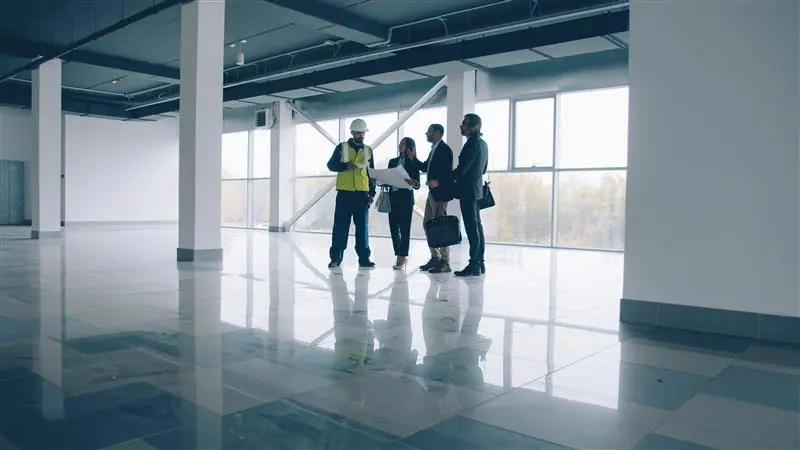
The Hidden Complexity of Wastewater Systems
Wastewater infrastructure is often out of sight, and consequently, out of mind.
Wastewater system issues aren't always easy to see, unlike a cracked foundation or a leaking roof. That’s a problem, because the condition of sewer lines and laterals can vary widely depending on age, usage, maintenance history, and environmental factors.
A property can look perfect on the outside. But it might hide problems like corroded sewer lines, overloaded septic systems, or poorly connected drainage networks. Without a professional inspection, these issues can remain undetected until they cause backups, contamination, or costly repairs.
Financial Implications of Neglect
A key reason to inspect wastewater infrastructure is the possible financial impact. Repairing or replacing wastewater systems can be prohibitively expensive. Sewer line replacements, especially in urban areas, may require excavation, permits, and coordination with municipal services, driving costs even higher.
If problems arise after acquisition, the buyer may have limited recourse. Many property deals have clauses that limit liability for hidden defects. This applies unless those defects were disclosed or found during due diligence. A thorough inspection helps buyers dodge surprise costs. It also lets them negotiate fair terms based on the real condition of the system.
Environmental and Health Risks
Engineers design wastewater systems to safely transport and treat sewage and graywater.
When these systems fail, the consequences can be severe. A broken sewer line can pollute soil, groundwater, and nearby water. This poses risks to both human health and the environment.
Contaminated water can carry pathogens such as E. coli, hepatitis, and other harmful bacteria and viruses. Exposure to these contaminants can lead to serious illness, especially in vulnerable populations. Wastewater leaks can harm the environment. This may lead to fines, cleanup costs, and damage to reputation, especially for businesses or factories.
An inspection ensures that the system complies with environmental regulations and functions as intended, protecting both the buyer and the broader community.
Regulatory Compliance and Legal Liability
Wastewater infrastructure is subject to a range of local, state, and federal regulations. These rules govern everything from system design and installation to maintenance and discharge limits. Noncompliance can result in legal liability, fines, and enforcement actions.
Properties with old or unapproved septic systems may need to upgrade or replace them to meet current standards. In some jurisdictions, properties must connect to municipal sewer systems if available, which can involve significant costs and logistical challenges.
A professional inspection can spot compliance issues before the deal is done. This helps buyers understand the legal landscape and plan ahead. It also offers helpful documents for negotiating repairs, upgrades, or price changes with the seller.
Impact on Property Value and Usability
The condition of wastewater infrastructure directly affects a property’s value and usability.
A malfunctioning system can limit occupancy, restrict development potential, or even render the property uninhabitable. For commercial properties, wastewater capacity may determine the feasibility of certain operations, such as food service, manufacturing, or hospitality.
Buyers should think about the system's current state and its ability to meet future needs. An inspection shows whether the system is the right size, well maintained, and ready for any planned changes or expansions.
In competitive markets, properties with well-maintained and compliant wastewater systems may command higher prices and attract more interest. Properties with unresolved issues may stay on the market longer or sell for less.
Due Diligence and Risk Management
Conducting a wastewater infrastructure inspection is a key component of due diligence. It demonstrates a proactive approach to risk management and helps buyers make informed decisions. By identifying potential problems early, buyers can:
- Request repairs or upgrades before closing
- Renegotiate the purchase price
- Allocate budget for future maintenance
- Avoid legal disputes and environmental liabilities
Due diligence is key for investors, developers, and businesses. It helps them when buying properties for income or redevelopment. Stakeholders need to consider a property's physical state, its operational viability, and its regulatory standing.
What a Comprehensive Inspection Includes
A thorough wastewater infrastructure inspection typically involves several components:
- Visual Inspection: Assessment of visible elements such as access points, tanks, and drainage fields
- Camera Inspection: Use of specialized cameras to inspect underground pipes for blockages, cracks, root intrusion, and other issues
- Flow Testing: Evaluation of system performance under normal and peak usage conditions
- Permit and Record Review: Examination of historical permits, maintenance records, and compliance documentation
- Soil and Water Testing: Analysis of surrounding soil and water for signs of contamination or system failure
Licensed professionals with experience in wastewater systems should conduct these inspections. Collaboration with environmental consultants or municipal authorities may be necessary to obtain a complete picture of your system.
GPRS offers NASSCO-certified video pipe inspections and other sewer inspection services designed to provide you with accurate, actionable data about your wastewater infrastructure. Utilizing remote-controlled sewer inspection crawlers and push-fed sewer scopes equipped with sondes, we map your sewer system while we’re inspecting it for defects such as inflow/infiltration (I/I) and cross bores.
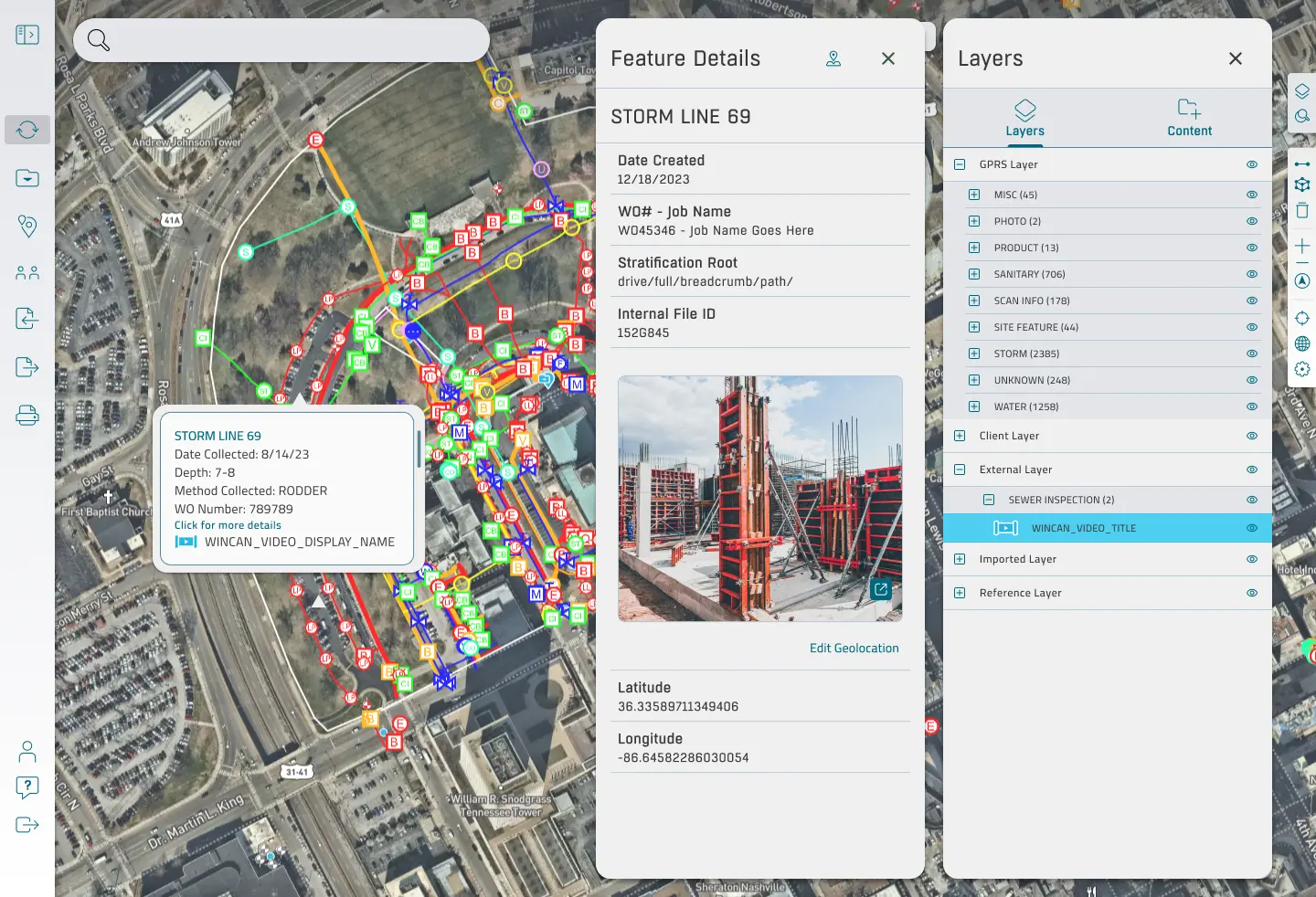
All this data is at you and your team’s fingertips 24/7 thanks to SiteMap® (patent pending), our innovative infrastructure, facilities, and construction project management software application. Securely accessible via any computer, tablet or smartphone, SiteMap allows you and your team to plan, manage, and build better whether you’re together on-site or scattered across the country.
SiteMap Sewer Layer offers facilities managers precise, accessible, and actionable sewer mapping data. This innovation enhances everything from daily operational efficiency to risk mitigation and long-term asset maintenance planning by providing a centralized, single source of truth for sewer systems.
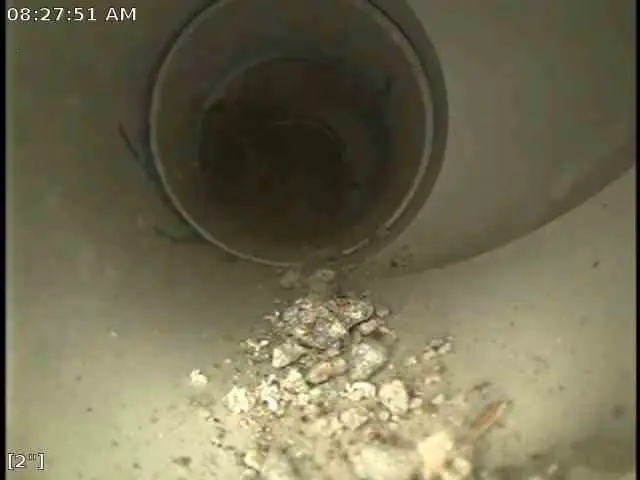
Case Study: GPRS Eliminates Surprises for New Owners of California Warehouse
Task: Inspect a distribution warehouse’s sewer system and collect reality capture data of its interior to provide accurate existing conditions documentation for new owners.
Problem
- Client was planning renovations to a recently purchased, 100,000 s.f. warehouse
- No accurate as-builts existed for the facility
- Surprises during renovations could torpedo the project’s budget and schedule
Solution
- GPRS conducted a video pipe inspection to map the facility’s sewer system and document defects
- Sewer inspection revealed debris that appeared to have been intentionally shoved into building’s cleanouts
- The interior of the warehouse was documented with a Matterport Pro 3 scanner
- GPRS’ in-house Mapping & Modeling Team used the Matterport data to create a detailed CAD drawing, 3D model, and virtual tour of the facility
Benefits
- Debris in cleanouts could be addressed before it caused costly damage to the sewer system
- CAD drawings, 3D model, and virtual tour will allow client and their partners to plan renovations and keep accurate records of future O&M throughout building’s life cycle
The Bottom Line: GPRS helped a developer avoid unwanted surprises during renovations to a recently acquired distribution warehouse.
Frequently Asked Questions
What size pipes can GPRS inspect?
Our NASSCO-certified VPI Project Managers can inspect pipes from 2” in diameter and up.
Can you locate pipes in addition to evaluating them for defects?
Yes, our SIM and NASSCO-certified Project Managers use VPI technology equipped with sondes, which are instrument probes that allow them to ascertain the location of underground utilities from an inaccessible location. This allows them to use electromagnetic (EM) locating to map sewer systems at the same time they’re evaluating them for defects.
GPRS Discovers the Location of Two Time Capsules from the 1940s
GPRS utilized ground penetrating radar (GPR) to help locate buried time capsules from the early 1900s before a school’s planned demolition.
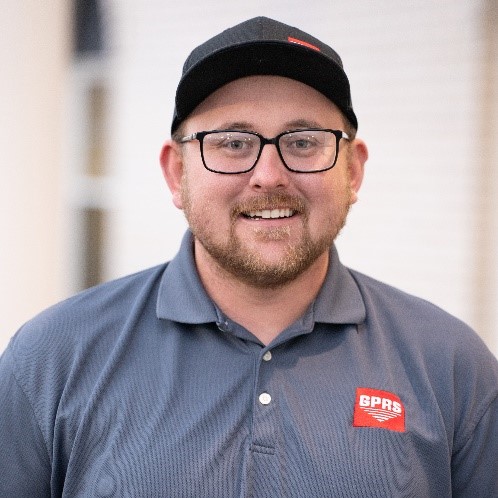
GPRS Project Manager Dillon Malang was called out to an elementary school in California to help narrow down the search for these time capsules.
“Our sole task was just to try and find these time capsules that were from, I want to say like the 1930s or 40s,” Malang explained.
The school was set for demolition, and members of the community recalled that time capsules were buried somewhere on the property. However, there was no documentation indicating where these capsules were – or if they truly existed at all.
“So, they pretty much narrowed it down to us for like 250-300 square feet areas just to scan with [ground penetrating] radar,” Malang explained.
When GPRS SIM-certified Project Managers utilize GPR for utility locating or concrete scanning, they rely on the imaging that displays when emitting radio signals into the structure. The radio waves “bounce” off any material it encounters and those bounces are displayed as hyperbolas.
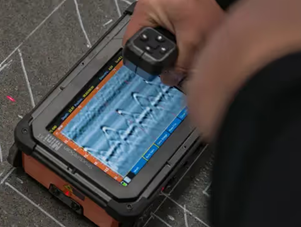
To the untrained eye, it may be unclear what these hyperbolas represent. Our experienced GPRS Project Managers can use this reading to determine the type of material located.
When conducting his investigation, Malang encountered two areas with distinct responses.
“We're able to find two reactions, one in each area, for them to possibly dig up to try and investigate,” Malang explained.
Malang marked the area with spray paint and flags, so the client will be able to investigate whether any of the responses are the missing time capsules without unnecessary, large-scale potholing.
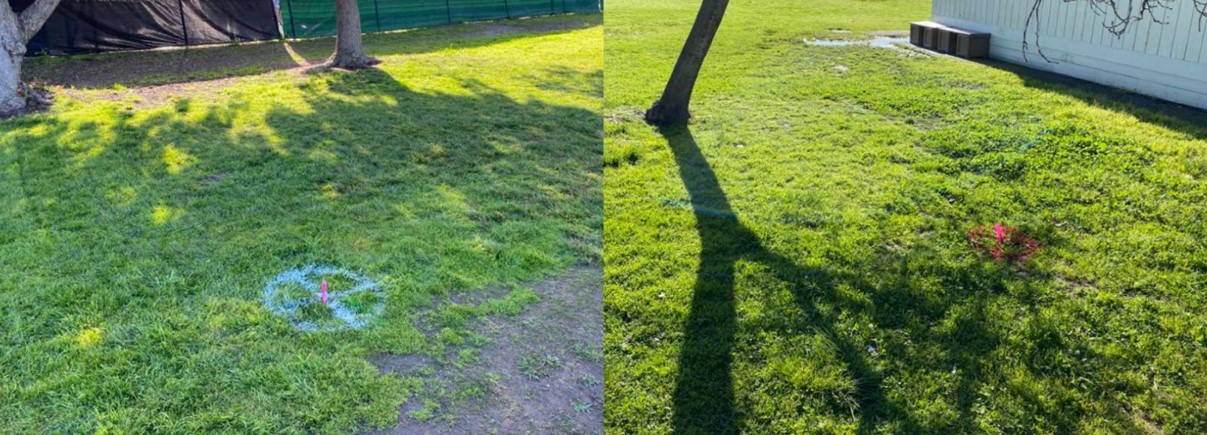
Locating time capsules isn’t an everyday type of job for GPRS’ nationwide team of Project Managers. Whether we’re helping you preserve a community’s history, or assisting with your commercial construction project, our aim is to give you the accurate, actionable data you need to stay on time, on budget, and safe.
Does GPR Have Any Limitations?
Ground and soil conditions, weather, and type of material located are a few of the potential limiting factors.
An experienced GPR technician, like GPRS Project Managers, will be able to assess a site’s condition to determine if GPR is the proper tool for the job. If GPR is limited by the site conditions or other factors, GPRS Project Managers are equipped with complementary utility locating tools to ensure we can still intelligently visualize your built world.
How Can I Determine if GPR is Needed for My Project?
GPR is commonly used to scan and identify subsurface elements. It’s always wise to conduct a GPR scan before beginning any renovation or demolition activities. This typically includes any excavation work deeper than 18”, or any coring, cutting, or drilling of concrete.
The best way to know whether you need GPR is to contact an experienced GPR technician to evaluate your project and its needs. GPRS’ Project Managers not only know how to use GPR properly and efficiently, they also know when it isn’t the best tool for the job and can recommend what works best for the needs of the clients.
With hundreds of GPRS Project Managers stationed all across the United States, you can be sure that there are quality GPR scanning services near you.
What can we help you visualize?
FREQUENTLY ASKED QUESTIONS
What is Subsurface Investigation Methodology?
Subsurface Investigation Methodology (SIM) is a standard operating procedure and set of professional specifications that work as a guide for utility locating experts when scanning for buried utility lines. All GPRS Project Managers are required to achieve SIM 101 certification, which requires 80 hours of hands-on training in a classroom setting and 320 hours of mentorship in the field. For reference, the American Society for Nondestructive Testing’s (ASNT) minimum training recommendation includes eight hours for training and 60 hours practicing GPR to achieve NDT Level 1 certification in ground penetrating radar (GPR) scanning.
SIM requires the use of multiple, complementary technologies, like GPR scanning and electromagnetic (EM) locating, when locating buried utilities or scanning a concrete slab.
What are the Benefits of Underground Utility Mapping?
Having an updated and accurate map of your subsurface infrastructure reduces accidents, budget overruns, change orders, and project downtime caused by dangerous and costly subsurface damage.
Contractors, Unions Provide Feedback on OSHA’s Proposed Heat Rule
Contractors and unions alike have said their piece about a proposed rule aiming to protect workers in the United States from the health risks of extreme heat.
The U.S. Dept. of Labor Occupational Safety and Health Administration (OSHA) held a multiday virtual public hearing earlier this summer as part of the rulemaking process for possible workplace heat injury and illness prevention standards.
Published last summer, the proposed rule would require employers to identify heat-related hazards and implement both engineering controls and safe work practices, using two distinct trigger thresholds. It would also outline procedures for establishing a heat emergency response plan, conducting training for employees and supervisors, and maintaining proper documentation.
The proposed rule applies to a variety of industries, but construction is perhaps the most important due to it being among the leading industries for workplace heat-related illnesses and injuries. According to Bureau of Labor Statistics data, between 2021 and 2022 there were 620 construction workplace injuries that resulted from exposure to environmental heat and required at least one day away from work, and 29 deaths.
OSHA says those numbers are likely lower than the true statistics due to underreporting.
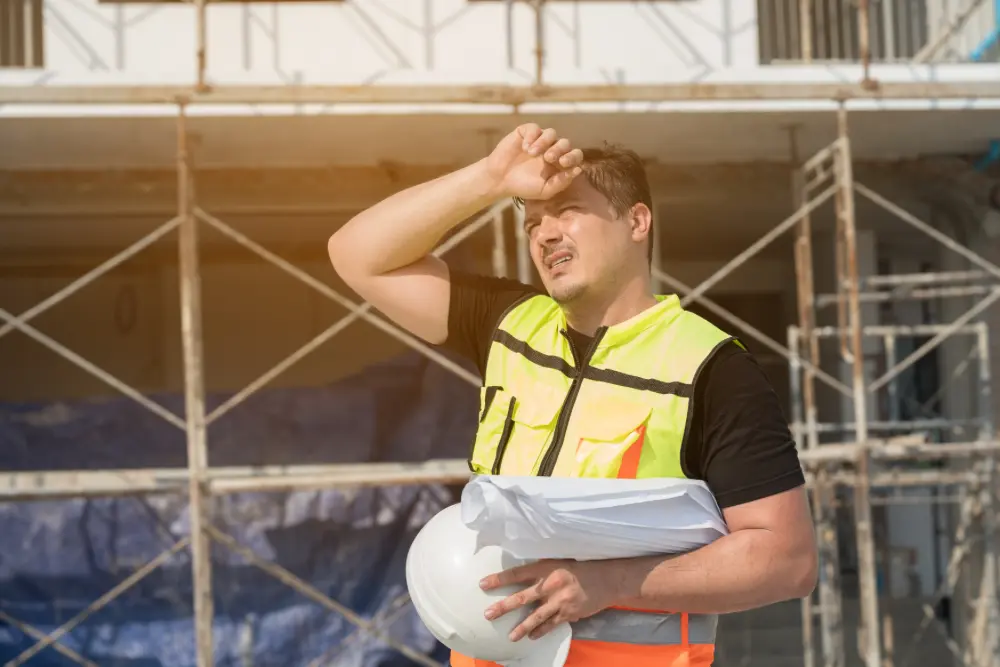
“Heat-related illnesses are significantly underreported for multiple reasons, including a lack of information, communication and fear of retaliation,” Ryan Papariello, safety and health specialist at the Laborers' Health & Safety Fund of North America, told Engineering News-Record. “…We must shift from a reactive to proactive strategy that centers on worker health and safety.”
According to ENR’s reporting, contractor groups have criticized the proposed rule for using what they call “a one-size-fits-all approach” to heat safety. The Associated General Contractors of America and the Associated Builders and Contractors are among the groups calling on OSHA to implement performance-based requirements in the standard, rather than prescriptive measures.
“OSHA should recognize, and I believe has recognized in the past, that the construction industry faces unique challenges compared to those in other industries,” said Kevin Cannon, director of safety and health services at AGC.
Cannon added that construction should be exempt from the temperature record keeping requirements included in the proposed rule.
“Our belief is that this data has limited utility in predicting environmental conditions on future projects and would not necessarily be considered representative sampling or objective data,” he told ENR.
The proposed rule states that employers would need to provide water, a break area and acclimatization for new or returning workers at 80°F. At 90°F, they would also need to provide 15-minute rest breaks every two hours and implement a supervisor or buddy system to observe for heat-related health symptoms.
Joe Xavier, senior director of health and safety at ABC, told ENR that provisions like requiring rest breaks “are impractical and would be exceedingly difficult to manage on construction sites due to time and schedule-based activity interdependencies.” He cited how mandatory breaks for crews placing concrete could cause a strain for contractors managing the timing of trucks, the concrete pour rate and other factors, among other examples of the challenges these types of rules would create.
“ABC recommends that OSHA allows supervisors and employees to work together and coordinate safe approaches for rest breaks focusing on individual employees’ needs, the nature of the work and the specific workplace conditions,” he said.
But Papariello pointed to the seven states that already have some workplace heat standards in place, and the additional ones currently considering them. Like the proposed federal rule, most of the state standards utilize prescriptive approaches to protect workers from extreme heat.
“[They] have shown that feasibility and flexibility are not a barrier,” he said. “In fact, as the more recently developed heat standards illustrate, these can go hand in hand.”
Other states, however, have made moves to reduce the amount of protection they require employers to offer their workers.
And in 2023, Texas legislators passed a bill that, among other effects, eliminated ordinances in Austin and Dallas that established mandatory water breaks for construction workers.
While commenting on OSHA’s proposed rule during a panel in June, Tarn Goelling, international representative at the International Brotherhood of Electrical Workers, shared a story about an electrical worker in Austin, Texas, who returned to his hot jobsite after taking some time off. The worker became pale, confused and dizzy over the course of his workday. He rested in the shade but still felt unwell and left early.
While driving home, the worker passed out and flipped his truck after suffering from heat stroke.
“[The worker was] not properly acclimated to working in extreme heat,” Goelling said at the panel, per ENR’s reporting. “…Many of the injuries and illnesses resulting from exposures to these heat hazards on the job are easily preventable with an appropriate heat illness prevention plan.”
GPRS Is Committed to You & Your Team's Safety
At GPRS, safety is always on our radar.
That’s more than just a catchy tagline; through our sponsorship of safety initiatives such as Concrete Sawing & Drilling Safety Week, Construction Safety Week, and Water & Sewer Damage Awareness Week, we aim to ensure that every employer and employee in the construction industry is equipped with the knowledge and resources they need to stay safe while building for our nation’s future.
Click here to learn more about GPRS’ safety initiatives and partnerships.
FIU Develops Spray-On Concrete System to Revolutionize Bridge Repair
Researchers at Florida International University have developed a spray-on concrete system that they believe could revolutionize how U.S. bridges are repaired.
According to an article in FIU News, engineers at the school have created a system that sprays Ultra-High Performance Concrete (UHPC) onto structures. This type of concrete has the potential to patch walls, fix pipes and restore drainage culverts – and it can make these structures stronger than they were originally.
According to information on the U.S. Department of Transportation website, UHPC is increasingly being used to build and repair America’s transportation infrastructure. Most of the time, these applications of UHPC involve pouring it into place. This UHPC would either be self-consolidating – filling its forms completely under its own weight – or thixotropic – a UHPC that is vibrated and struck off with a vibrating screed under initial placement.
Existing UHPC applications – such as girder end repairs and the restoration or protection of walls and columns – could be enhanced by the ability to spray UHPC directly into place. Emerging or future uses, including bridge deck soffit repairs and culvert rehabilitation or retrofitting, may also benefit from sprayable UHPC.
In these cases, spraying UHPC is often more economical than traditional pouring methods, primarily because it eliminates the need for formwork. Spray application also offers greater flexibility, allowing UHPC to be applied from any angle. This overcomes the limitations of gravity-based pouring, which can be hindered by structural obstructions like bridge decks.
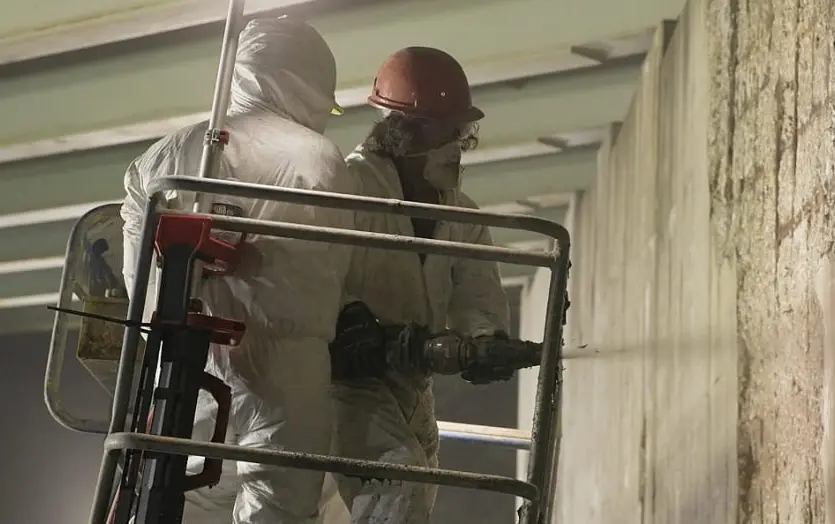
“UHPC has historically been very expensive to use, mainly because most of those available [mixes] on the market have been commercial versions,” said Atorod Azizinamini, a professor of civil engineering and director of a U.S. Department of Transportation-funded research center at FIU. “Even a very thin layer of UHPC can drastically improve the strength of a structure and protect it from water.”
“We have developed an affordable type of UHPC, and a system that can spray it,” Azizinamini continued. “This could become a major tool in repairing or upgrading structurally deficient bridges quickly and efficiently.”
FIU’s UHPC mix comes in at around $500 per cubic yard, which is considerably cheaper than many comparable commercial versions of the product. The school’s application system deposits thin layers of concrete onto surfaces through a nozzle, like how spray paint is applied. These layers can be added, one upon another, in coats. Their light weight doesn’t significantly alter the mass of a structure.
The FIU team used their system and UHPC mix on a bridge in Virginia last year.
“The reason that we invited the FIU team here to Virginia is that we had a bridge abutment wall that had corrosion issues due to the deicing salt that is used here,” said Sam Fallaha, an engineer with the Virginia Department of Transportation. “We liked it because it is easy to apply a thin layer to vertical surface creating a durable solution for problems like these that occur in cold climates.”
The Virginia job was the first-ever application of its kind in the U.S. The Risk and Resilience Tech Hub is investing roughly $1 million into the FIU researchers’ system to commercialize the technology and help the university train more engineers and builders to use it.
"Anyone who has used a glue gun for an arts and crafts project knows how difficult it can be to keep the nozzle from getting clogged,” said Morgan Dickinson, a Ph.D. student in Azizinamini’s lab. “The same goes with our UHPC system. If you don’t know how to clean it, the concrete hardens, and you might have to throw parts away. Fortunately, we are seeing widespread interest in people who want to learn about our system and use it properly.”
Kia Hajifathalian, Vice President and Market General Manager at Baker Construction, told FIU News that he sees the FIU system as a practical way of bringing the benefits of UHPC to more buildings and bridges around the nation.
“This is not just research in a lab that will only have a couple of specific uses,” Hajifathalian said. “I think that FIU has figured out how to utilize UHPC in a way that can be used to repair buildings and bridges at scale.”
"The biggest nightmare of a concrete contractor is pouring concrete, testing it later and finding out that it is not as strong as you thought it would be because something unexpected happened,” he added. “Having that concrete in a pre-bagged system like FIU is doing, where you have quality control, is so important.”
The State of America’s Bridges
There are more than 623,000 bridges across the United States, according to the American Society of Civil Engineers (ASCE) 2025 Report Card for America’s Infrastructure.
The ASCE gave America’s bridges a C in that report card, citing the fact that 49.1% of the country’s bridges are in “fair” condition, 44.1% are in “good” condition, and 6.8% are in “poor” condition.
“Unfortunately, the nation continues to see the number of fair bridges surpassing those in good condition,” the ASCE wrote. “As bridges in fair condition continue to age – presenting the possibility of being further downgraded – they also exemplify an opportunity because they can be preserved at a lower cost than bridges in poor condition.”
Bridges received a significant amount of funding through the Infrastructure Investment and Jobs Act (IIJA), which included $27.5 billion for the Bridge Formula Program and $12.5 billion for the Bridge Investment Program.
“Despite this infusion of federal funding, bridge-related system rehabilitation needs are estimated at $191 billion,” the ASCE wrote. “Therefore, strategic asset management planning and routine maintenance are essential to keeping bridge conditions from further declining and avoiding costly repair or rehabilitation work. While the effects of extreme weather events pose threats to bridges, innovative techniques are improving their security and resilience.”
As we wait to see if innovations like FIU’s spray-on concrete system, or Allium’s stainless-steel-clad rebar truly revolutionize bridge construction and maintenance, it’s important that you know exactly where all reinforcements are within bridge decks and other concrete slabs before you attempt to cut or core that concrete.
Striking rebar, post tension cables or other support systems within concrete can lead to catastrophic structural failure that endangers you and your workers, and anyone else in the vicinity of your job site.
GPRS provides precision concrete scanning and imaging services designed to keep your concrete cutting and coring projects on time, on budget, and safe. Utilizing state-of-the-art ground penetrating radar (GPR) scanners and other, complementary technologies, we visualize where you can and can’t safely penetrate the slab, providing you with accurate, actionable information that helps you plan, build, and manage better.
Our SIM-certified Project Managers have achieved and maintain a 99.8%+ rate of accuracy when scanning concrete slabs for buried rebar, post tension cable, electrical conduit, and any other types of embedded obstructions that could compromise the safety and success of your project. We’re so confident in their abilities that we introduced the Green Box Guarantee, which states that when we place a Green Box within a concrete layout prior to you cutting or coring that slab, we guarantee that the area within will be free of any obstructions.
If we’re wrong, we agree to pay the cost of the damage.
From bridges to skyscrapers, GPRS Intelligently Visualizes The Built World® to keep your projects on time, on budget, and safe.
What can we help you visualize?
Frequently Asked Questions
How is GPR used to identify tendons vs. rebar in a post-tensioned slab?
In post-tensioned structures, we typically find one mat of support rebar near the base of the slab. This mat is generally consistently spaced and remains at a constant elevation.
Post-tension cables are generally found above this support mat and “draped” throughout the rest of the structure. The elevation of the cable is usually high near the beams and column lines and drapes lower through the span between beams and column lines. Knowledge of these structural differences allows us to accurately differentiate between components. Our Project Managers will leave you feeling confident in our findings and in your ability to drill or cut without issue.
What types of concrete scanning does GPRS provide?
GPRS provides two specific but different scanning services: elevated concrete slab scanning and concrete slab-on-grade locating. Elevated concrete slab scanning involves detecting embedded electrical conduits, rebar, post-tension cables, and more before core drilling a hole through the slab. Performing a concrete slab-on-grade locating service typically involves scanning a trench line for conduits before conducting saw cutting and trenching to install a sanitary pipe, water line, or something similar.



.svg)